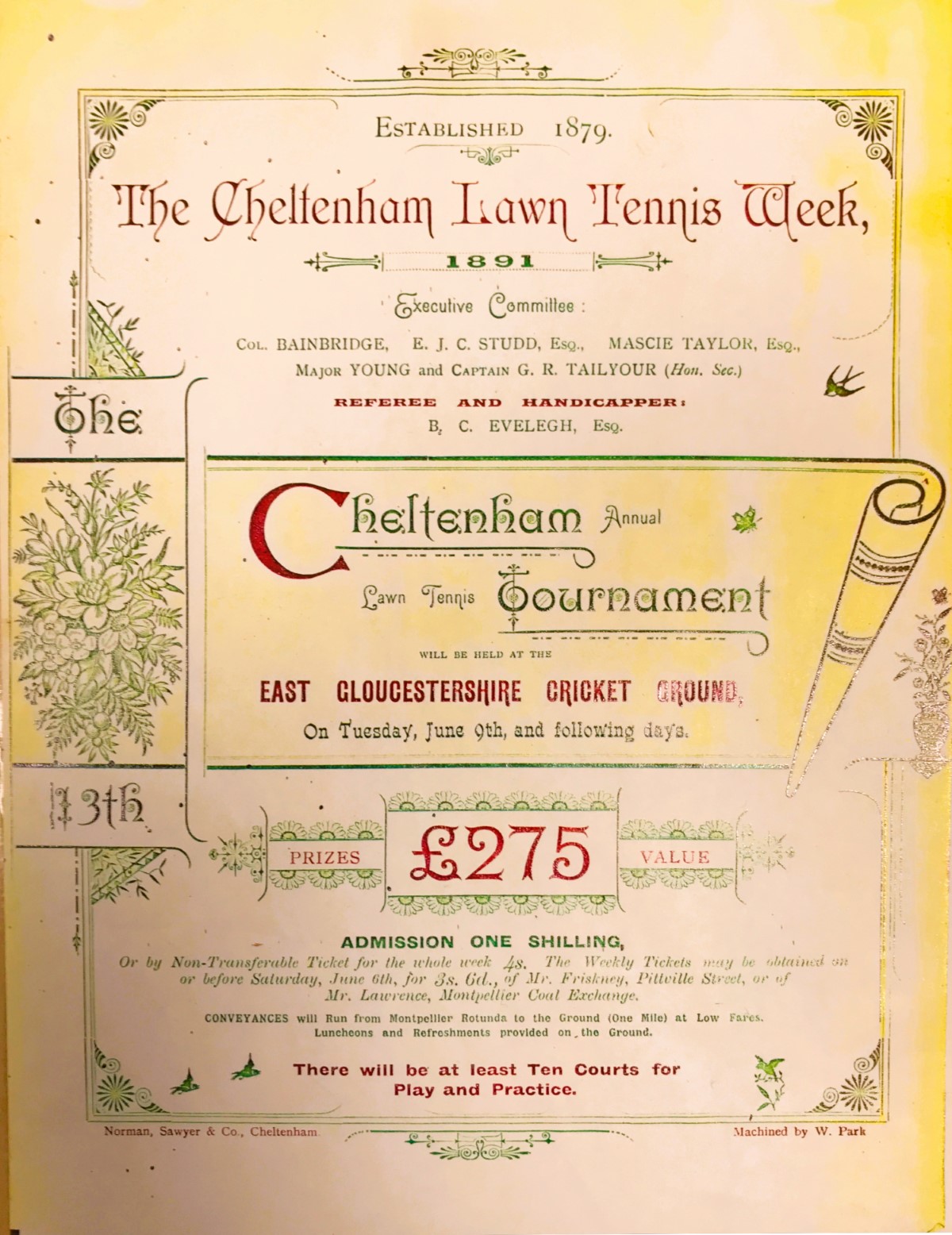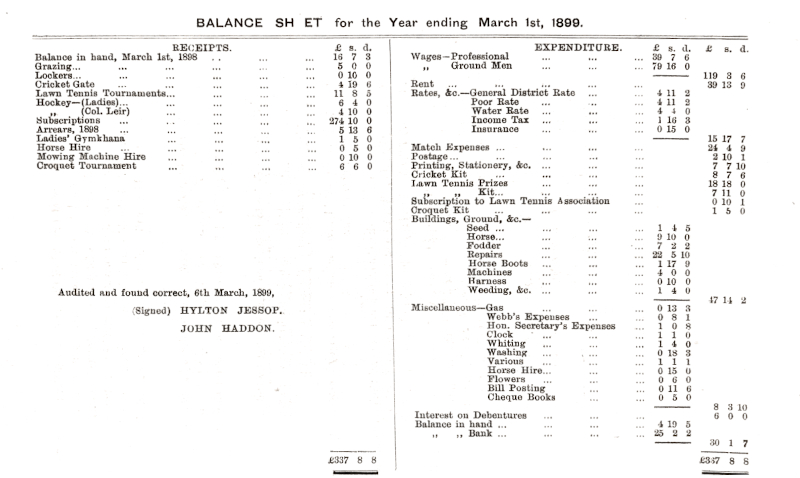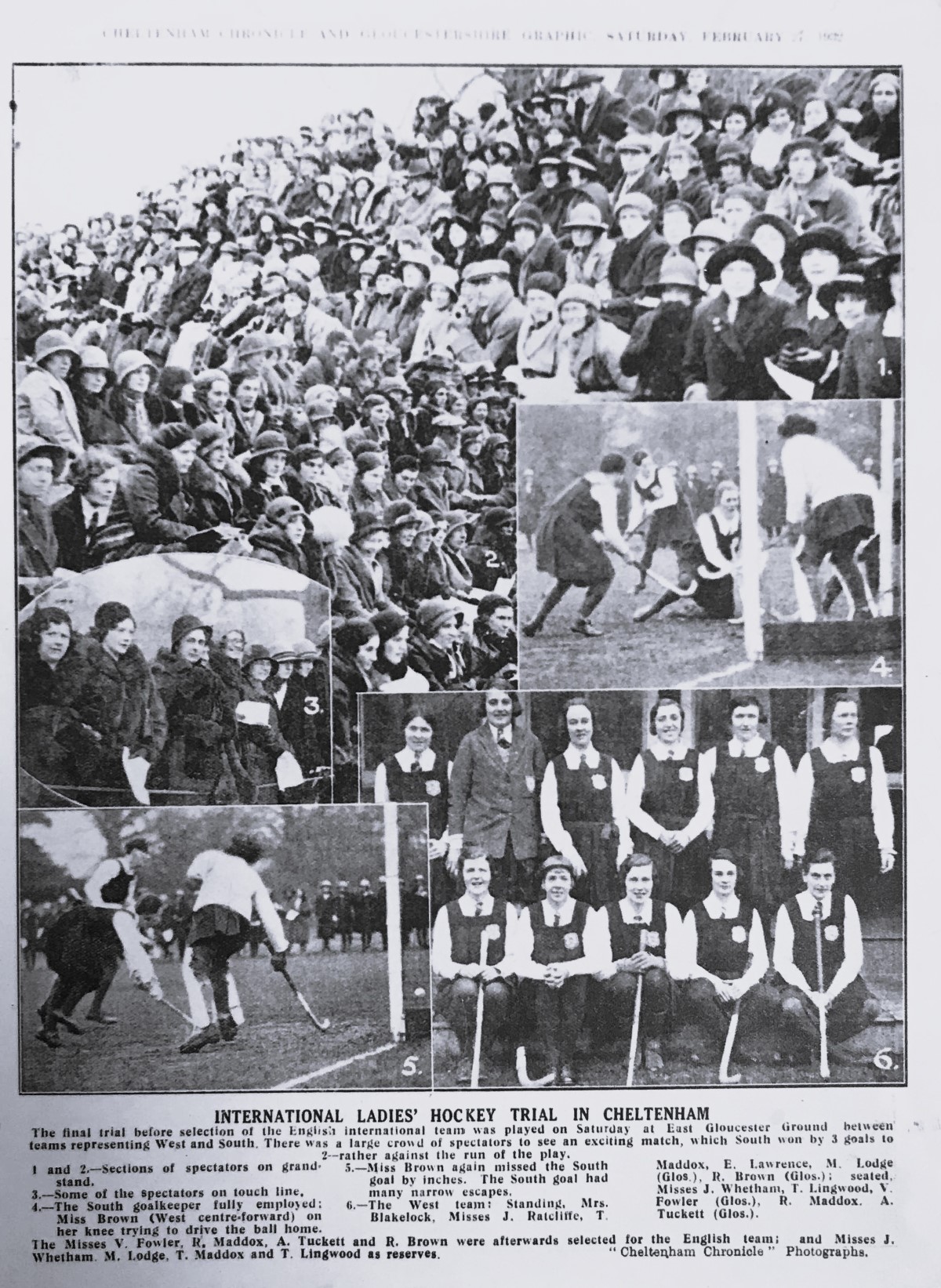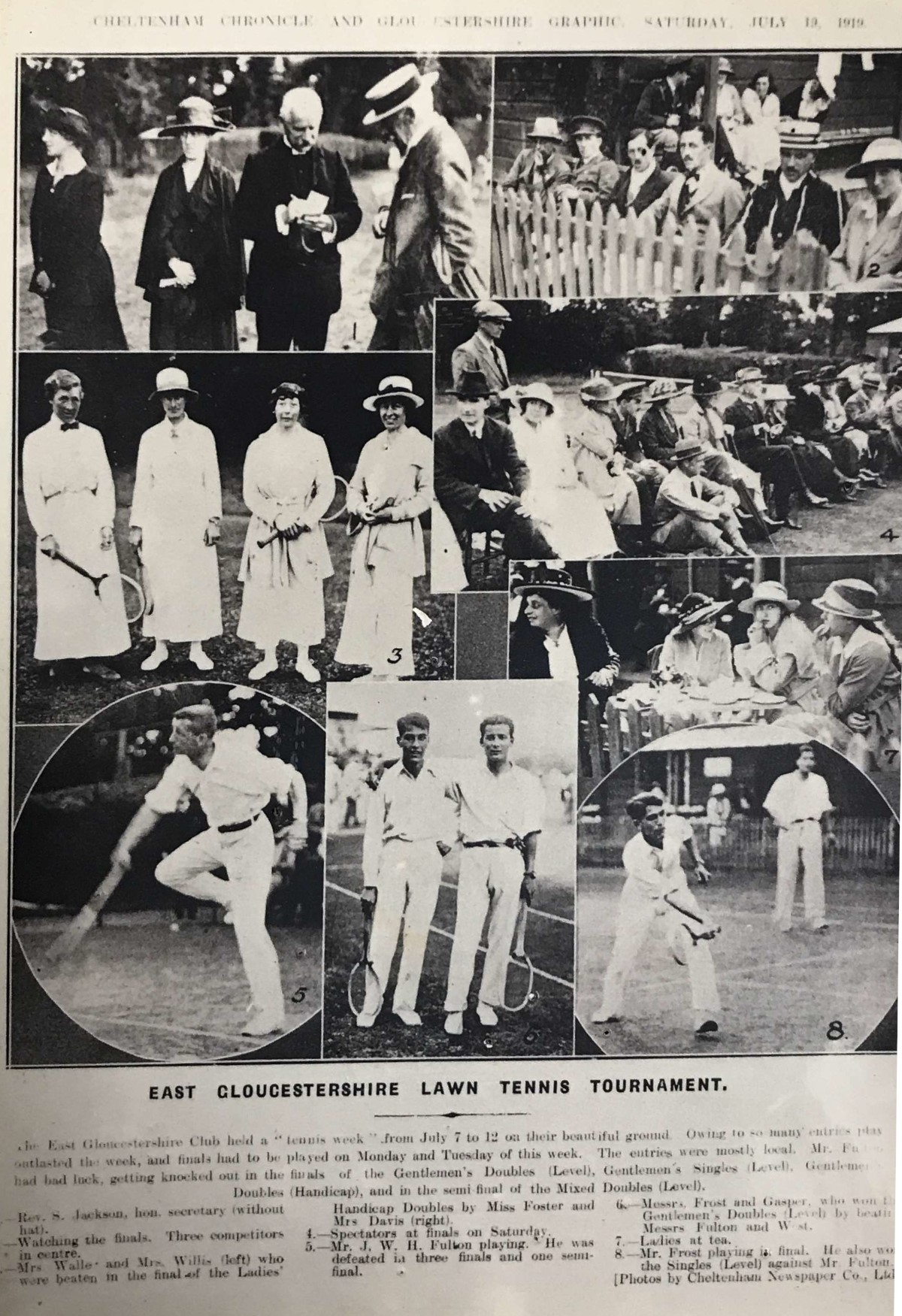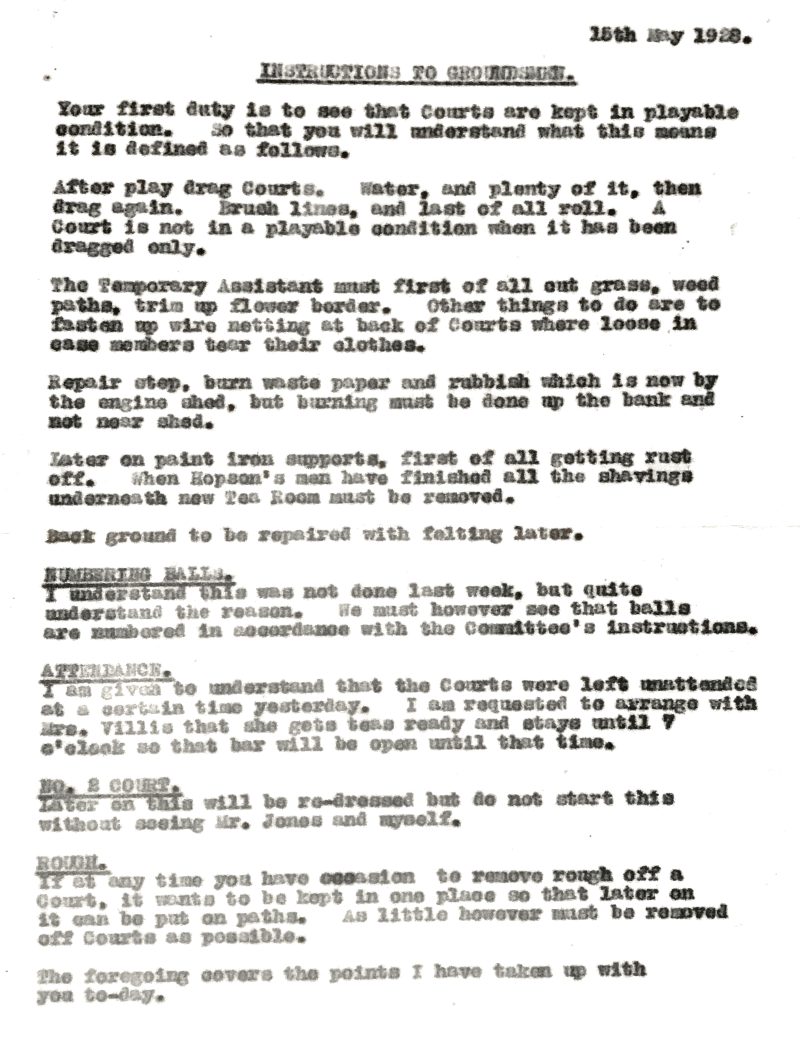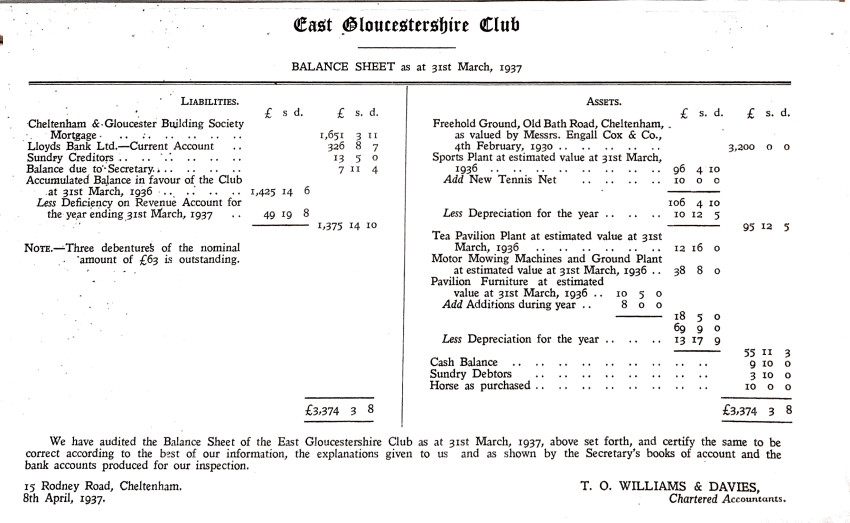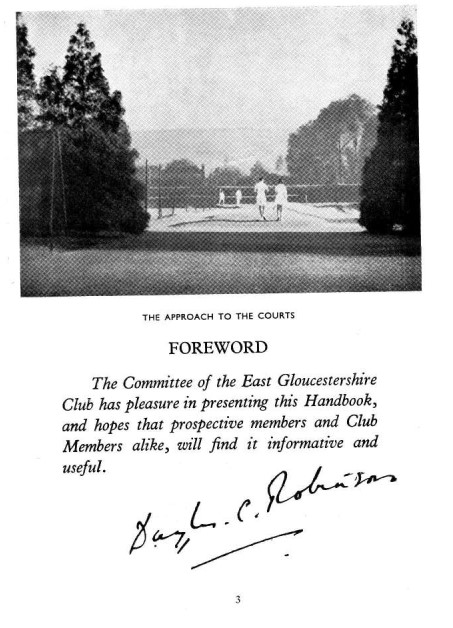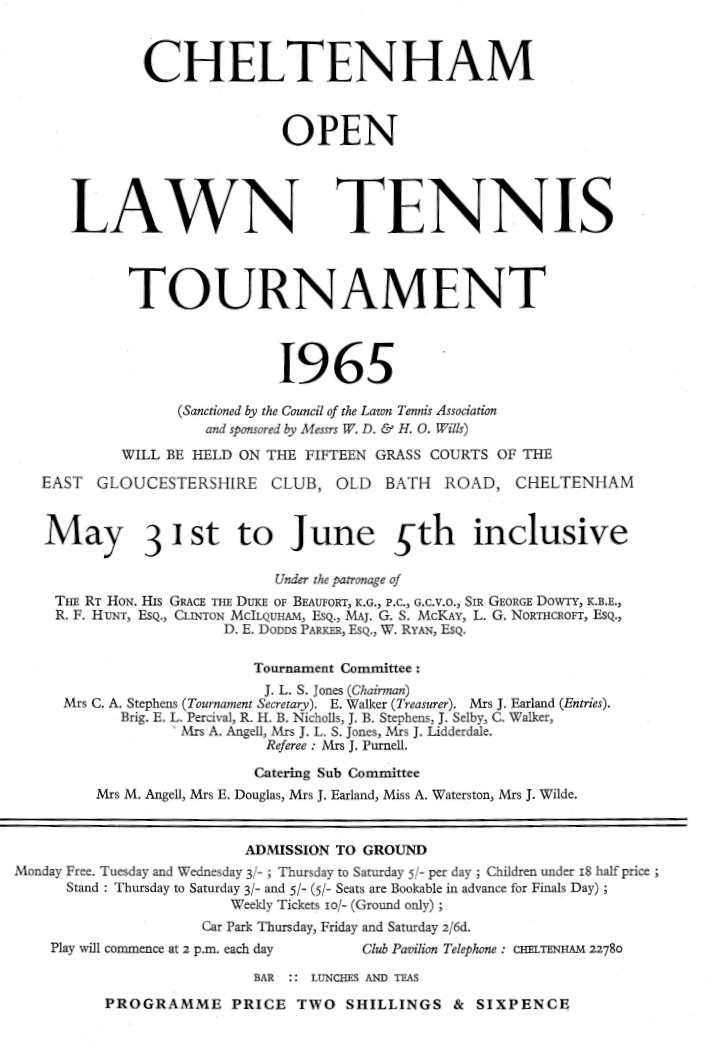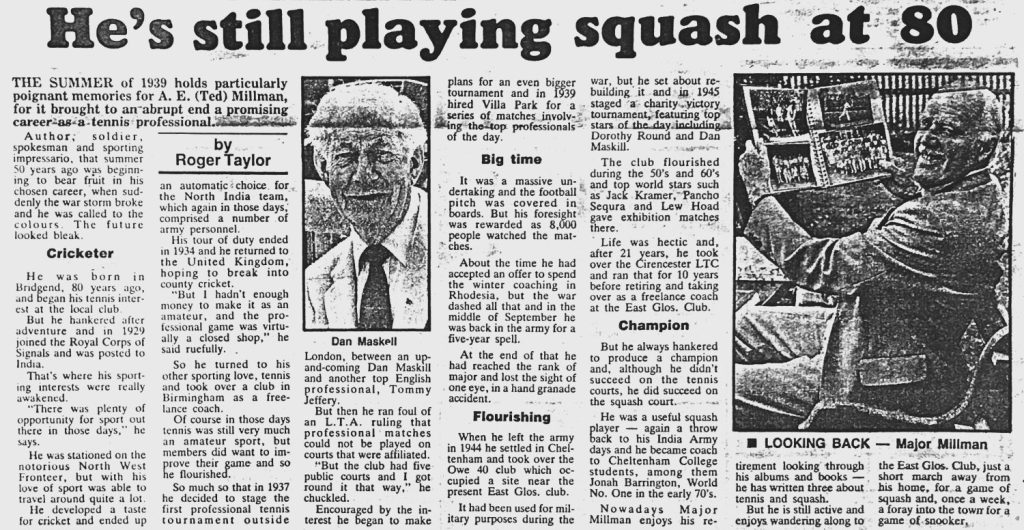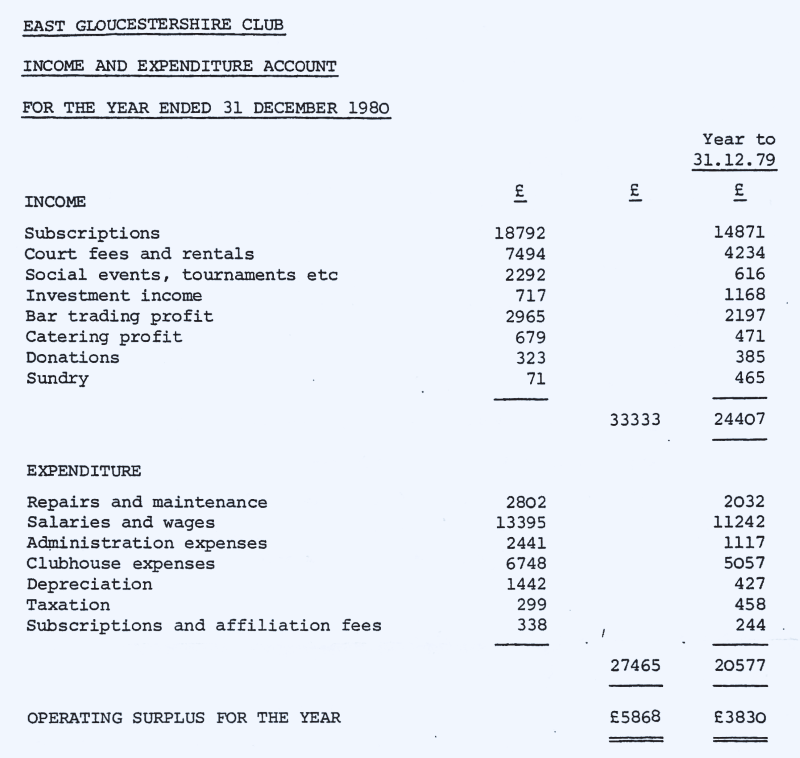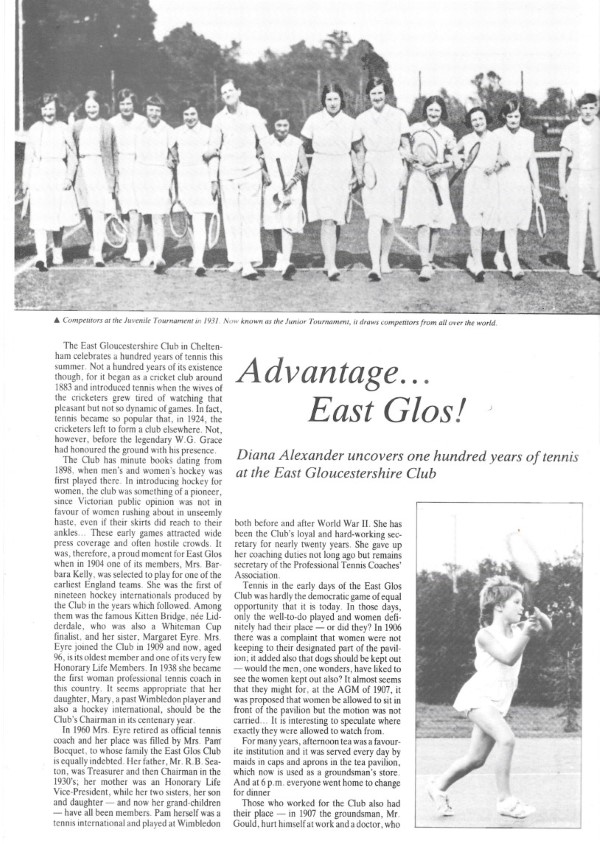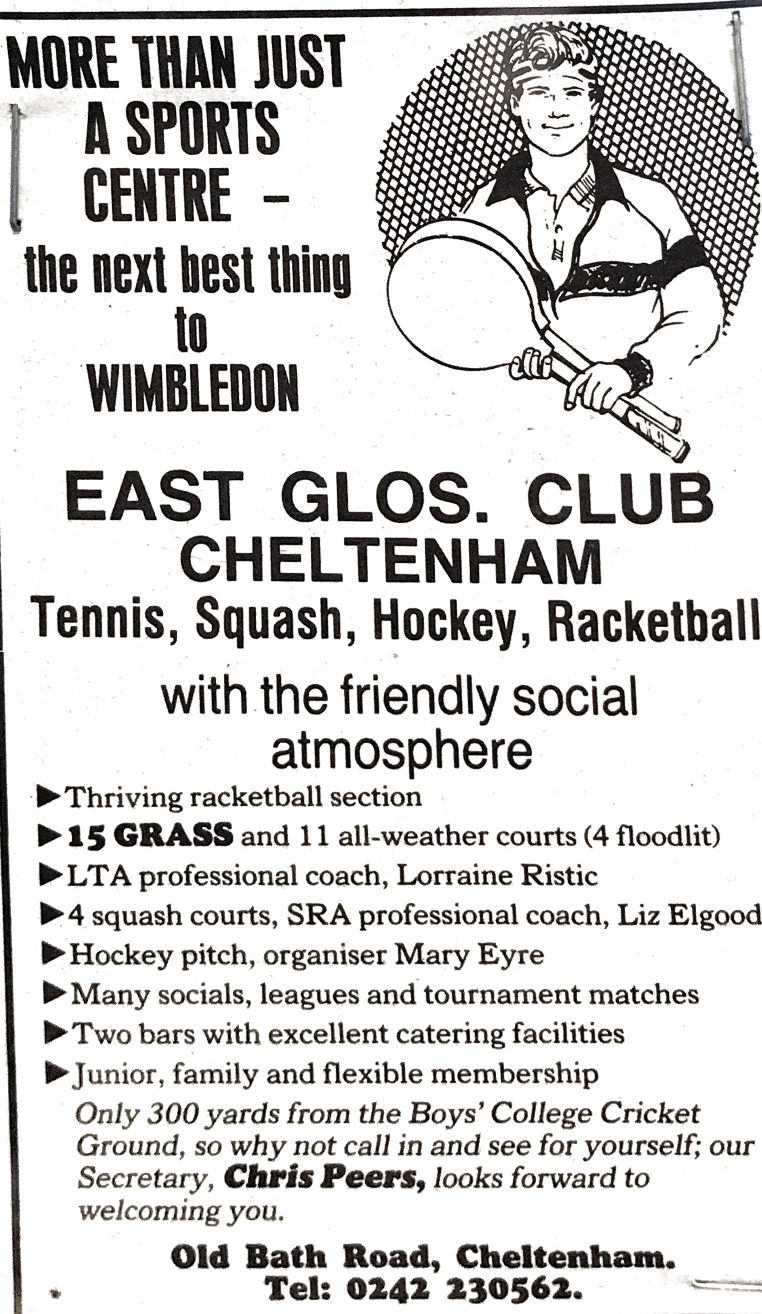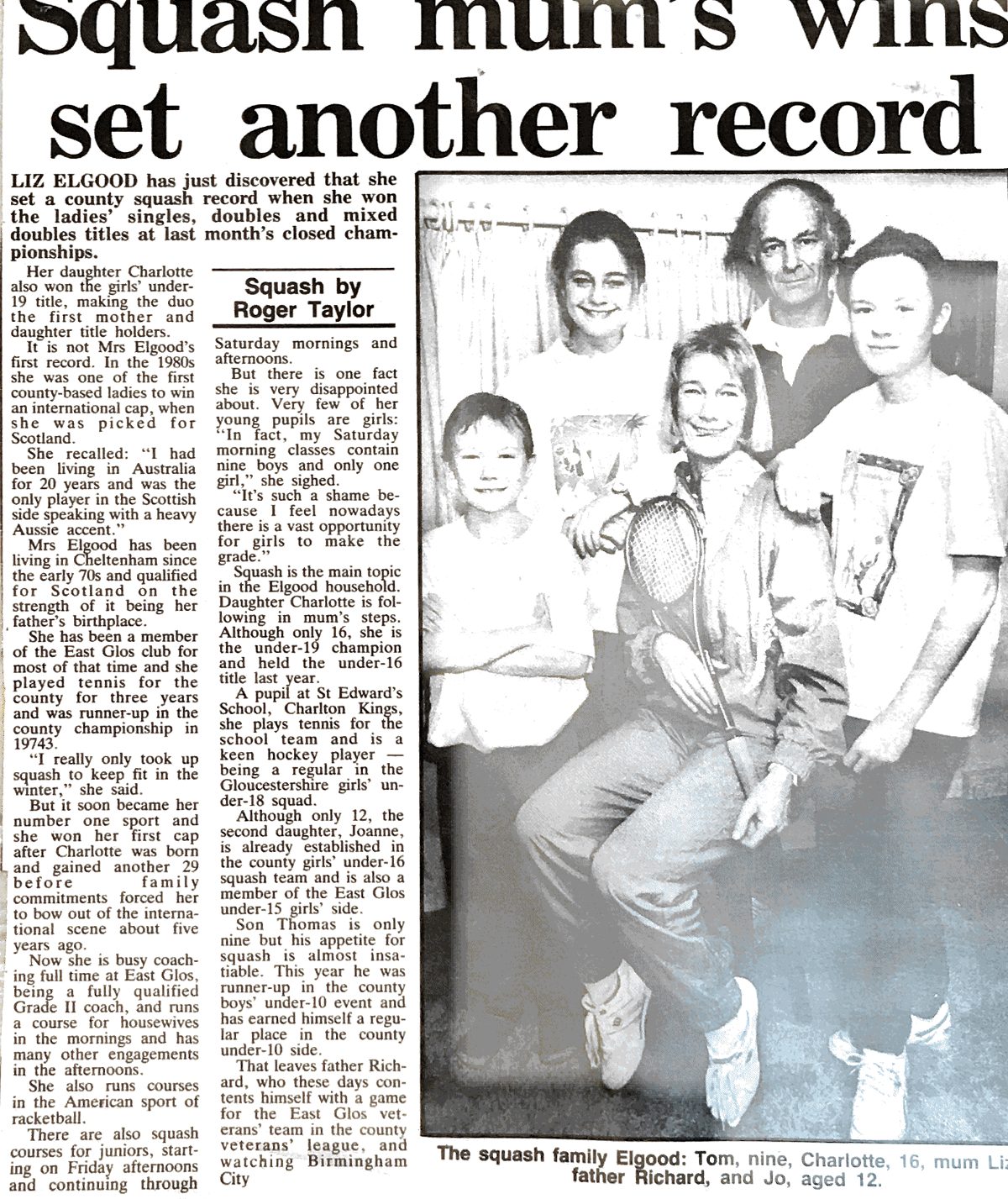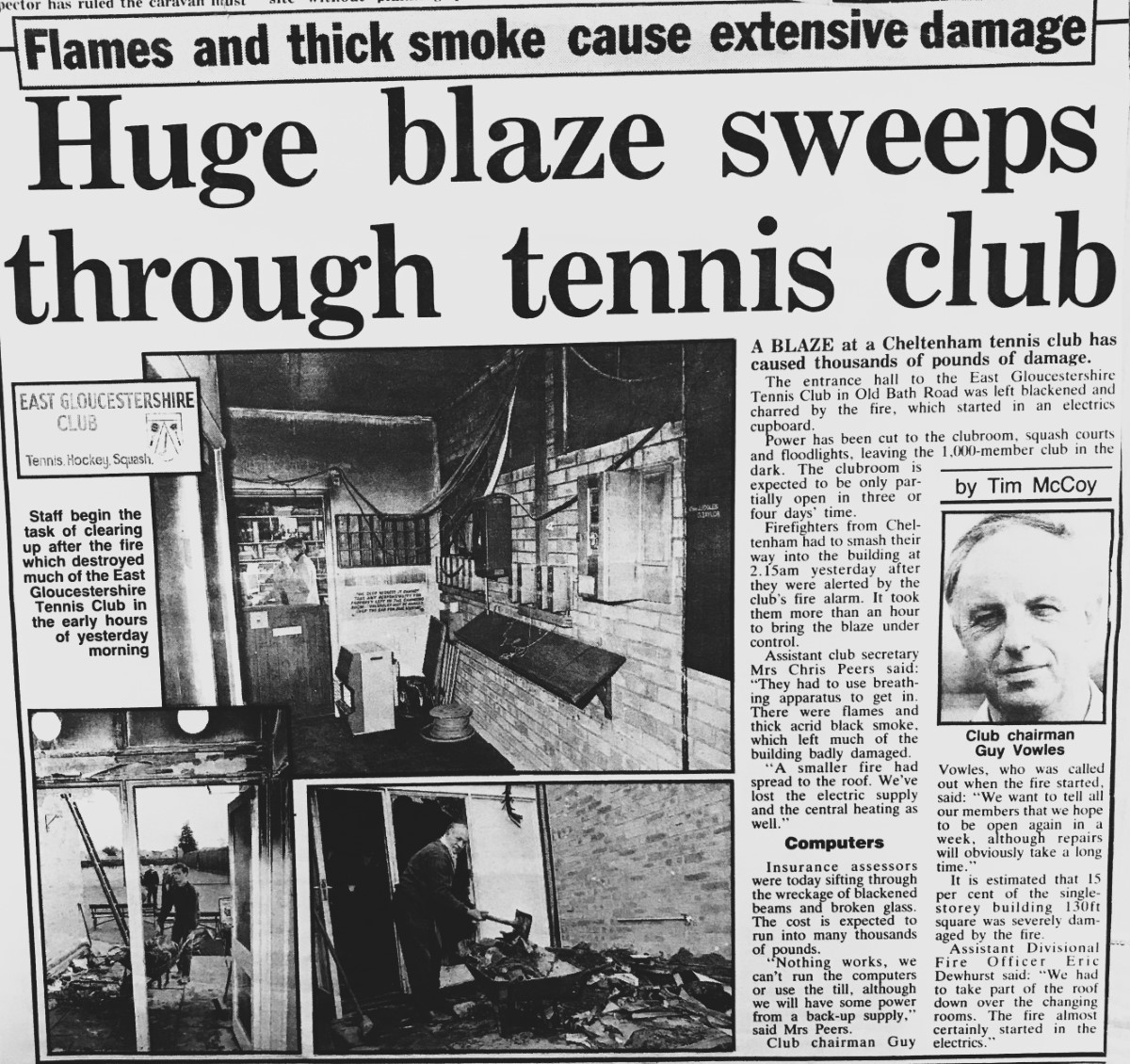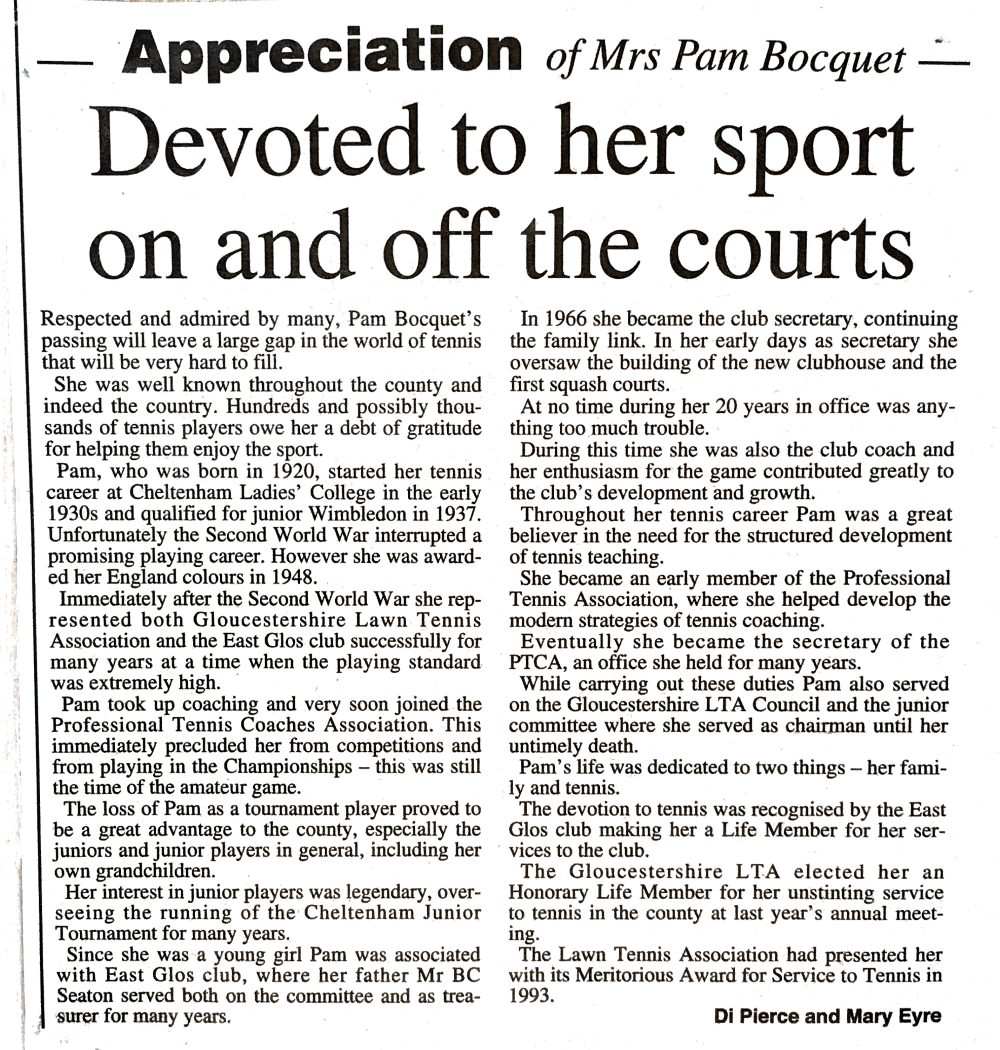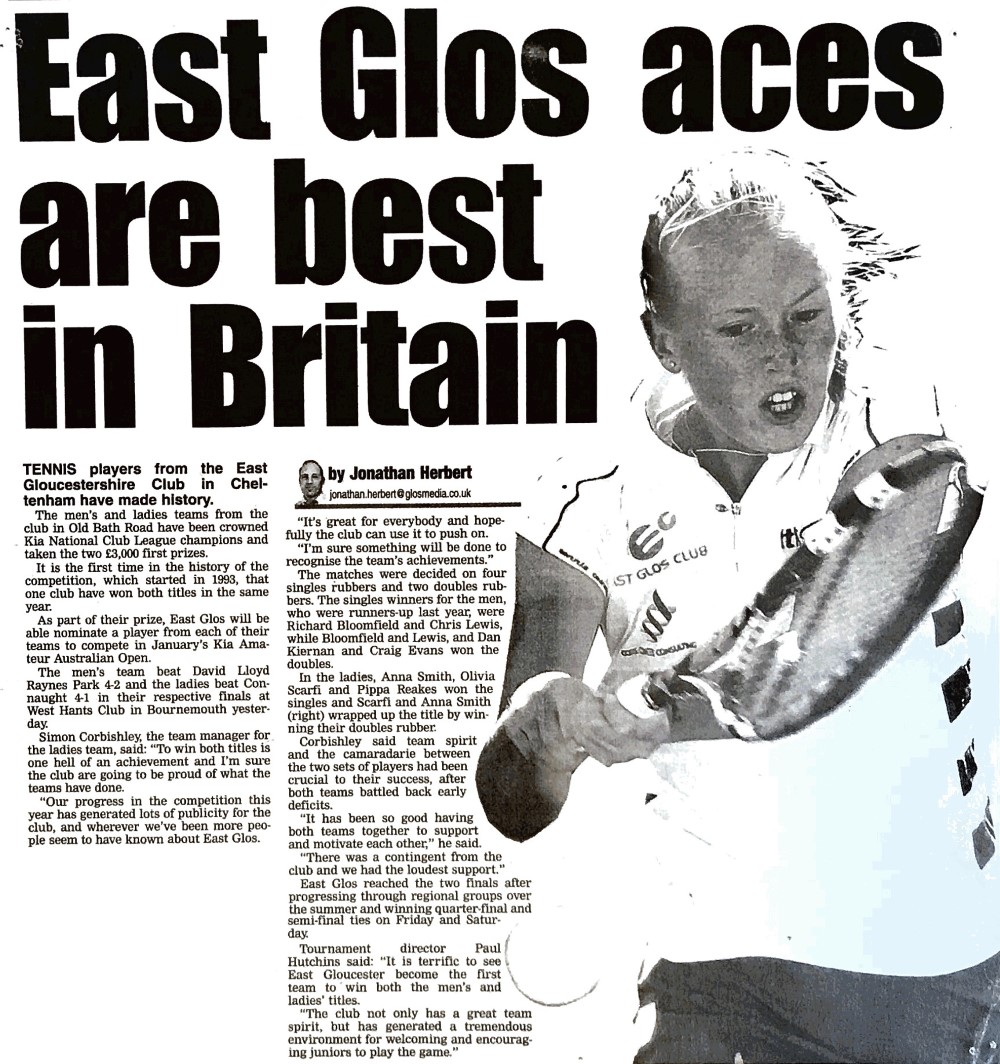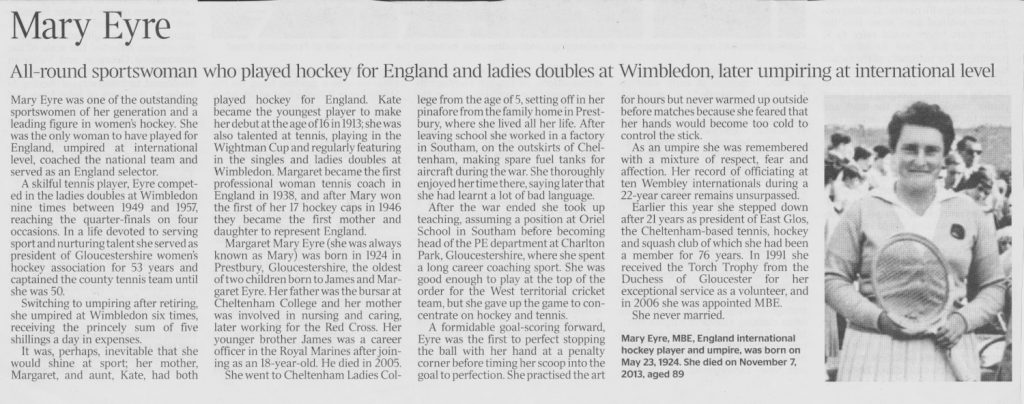The history of East Glos Club, Cheltenham
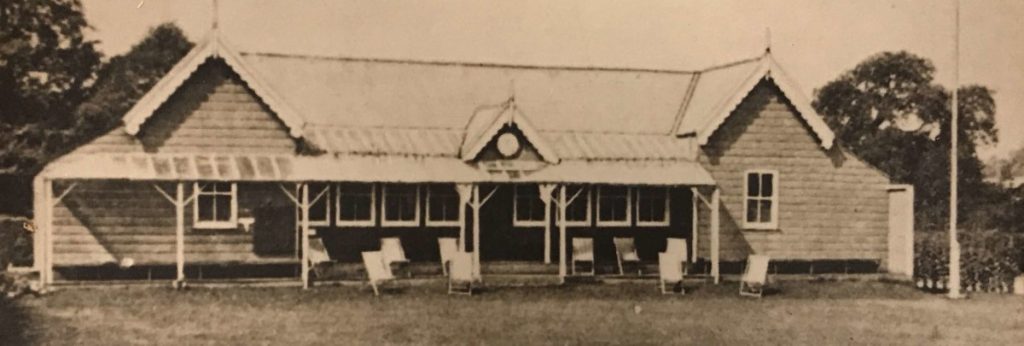
Photo: The former clubhouse
East Glos Club was founded during the reign of Queen Victoria. The club has survived the challenges of two world wars and a global pandemic. Today East Glos is stronger and more vibrant than ever, with its four racket sports enjoyed by over 1800 members. Below you can explore the club’s fascinating history.
Researched and written by Julian Wellings, January 2023.
Author’s notes
1. The club was known as “East Gloucestershire” for many years. The shortened version, “East Glos”, became more commonplace later in the twentieth century. For simplicity, where I mention the club’s name, I have used the term “East Glos” from the outset.
2. I have used pre-decimal currency terminology for all years before 1971 when decimalisation was introduced in the UK. There were 12 pennies in a shilling and 20 shillings to a pound. So, for example, 10 shillings equals 50p; 2 shillings equals 10p; 1 shilling equals 5p.
3. Sources
Much of the early history was sourced from the British Newspaper Archives. There were four local newspapers serving Cheltenham, which reported on club AGMs and events in great detail. The club’s office manager Barbara Hawkins and I also discovered a treasure trove of old minutes books, tournament programmes and press cuttings in the Portakabin behind court 8. These documents range from the late 1800s to the 1990s. Finally, we have an archive of E-News editions from 2003 onwards, which proved very informative.
I am grateful to Nigel Lawford for his insights into the founding of East Glos and the first instance of ladies’ cricket being played. Nigel, an accomplished historian, is a distant relative of Herbert Fortescue Lawford, who, in 1880 was ranked among the top four players in the British game.
4. There is so much history to East Glos that there is a lot of content on this web page. Viewing is recommended on a desktop computer or a tablet rather than a mobile.
5. Finally, I thank the East Glos Board for supporting this fascinating project.
Updates to this page
This page will be updated occasionally as new information comes to light. You can see the edit history here.
 The history of East Glos is
The history of East Glos is
now available in book form
from East Glos reception.
You can easily navigate specific groups of years using these links.
1882 – 1899 1900 – 1925 1926 – 1950 1951 – 1975 1976 – 2000 2001 – 2010 2011 – 2020 2021 – 2023
1882 to 1899
1882
On Saturday, 27th May 1882, some 40 gentlemen gather at the Queen’s Hotel for a meeting to launch a new cricket club for Cheltenham.
The Reverend Percy Hattersley-Smith is one of the principal founders of East Gloucestershire Cricket Club and is present at the meeting with Lord Fitzhardinge of Berkeley Castle, Sir Brook Kay, and William Hicks-Beach. Hattersley-Smith describes the steps taken to procure grounds for the new club. The owner of Charlton Park has been approached and has agreed to make available eight acres of land in Charlton Park on a lease not exceeding 21 years.
An estimate of start-up costs is given, and the opinion is expressed that the club could be launched with a capital of around £450. The first resolution of the meeting is that a club should be formed. It is carried unanimously.
In September 1882, advertisements are placed for tenders for the enclosure and levelling of the grounds in Charlton Park.
1883
A previous version of the club’s history, detailed in the 1985 centenary booklet, describes the club having come into being as a result of a group of players called the Cheltenham Nomads renting the present site due to not having their own home ground. It is of course possible that the Cheltenham Nomads is the same group described above and that this was an informal name for the team, but there is no evidence of this from newspaper articles from the time.
Following a further meeting at the Queens Hotel in March, a committee is appointed. The club is officially named East Gloucestershire Club. The first match is played on the new ground in Charlton Park on 7th and 8th May 1883.
How did the name East Gloucestershire Club come about?
In an earlier version of this history, I suggested that the club’s name may have come about to avoid confusion with the West Gloucestershire Cricket Club (WGCC). That name was adopted in 1846 when Mangotsfield Cricket Club merged with WGCC and existed until 1867 when the name was changed to Gloucestershire County Cricket Club. The latter was wound up in March 1871, and its chief officials accepted positions in the hierarchy of Gloucestershire.
Club member Michael Hare, a keen historian, has been in touch with a more plausible explanation.
Michael writes, “I suspect that a major factor in the choice of name was the existence of a parliamentary constituency of East Gloucestershire (returning two members) from 1832 to 1885. There was, of course, also an East Gloucestershire Railway at one stage, though it ran nowhere near Cheltenham. In 1866 and 1872, there was an East Gloucestershire Provident and Friendly Society and Benefit Club. In 1880 there was an East Gloucestershire Lodge of the Good Templary (a temperance movement). In 1870 the North Wilts Herald proclaimed itself (among other things) as the East Gloucestershire, Berkshire, and West of England Advertiser.
“There are probably other examples to be found. Such names will have created a sense of belonging to East Gloucestershire. The choice of the club’s name would have come naturally to the minds of the founders of the club if they had a broad catchment area in mind.”
In May, the club plays a team from the Berkeley Hunt. The fantastically-named newspaper The Cheltenham Looker-On describes the club as having a spacious new ground which has been re-laid, levelled and fenced in. The Berkeley Hunt team includes Dr E. M. Grace, the elder brother of the legendary W. G. Grace.

1884
Enjoy great views of East Glos for £250 per annum
In an edition of The Field, The County Gentleman’s Newspaper, the mansion and grounds known as Charlton Park are advertised to let for £250 per annum. As well as “stabling for twelve horses and four packs of fox hounds within easy reach”, a key selling point is that the front rooms overlook the magnificently timbered park, which is the East Glos cricket ground, with a private entrance to the club for the mansion’s residents.
A county cricket team plays for the first time at East Glos as the Gentlemen of Gloucestershire.
1885
Tennis is played for the first time
Tennis is first played in 1885 when the bored wives of the cricketers have a court marked out and start playing.
1888
W.G. Grace plays at East Glos
William Gilbert “W. G.” Grace is recorded as playing for Gloucestershire v Nottinghamshire on 15th June. Grace was an English amateur cricketer who was influential in the development of the sport and is widely considered one of its greatest-ever players. Nottinghamshire wins by an innings and 28 runs.
1890
Drive for more tennis members
The committee tries to attract new members by providing better facilities for lawn tennis. Four new courts are laid during the winter, making eight in all. The family subscription is set at five shillings.
Ladies cricket is played
On Saturday 27th September, The Cheltenham Chronicle reports on an East Glos Ladies v Glamorgan cricket match.
The writer comments, “That cricket is now rapidly growing in popularity amongst the fair sex may be seen by the number of ladies’ cricket clubs which have been successfully established during the past few years, in spite of much unreasonable prejudice. This prejudice against the playing of cricket by ladies, which, in fact, was most to be observed in the sex itself, is now happily dying out, and few grudge them the right to participate in the noblest and most invigorating of all outdoor sports.”
The East Gloucestershire Ladies’ Cricket Club is established early in the 1890 season, captained by Mrs W Bradish. During the season, although proceedings have been carried out quietly, the club has had some excellent practice, under the able coaching of Mr W A Woof. On Wednesday 24th September 1890 the team encounters the Glamorganshire Ladies’ Club and gains a decisive victory.
The match is not played at East Glos but on the home club’s ground at Ryeworth Farm, Charlton Kings. The home team is arrayed in white flannel skirts and blue shorts, and wore straw hats displaying the club ribbon (a white zig zag on a blue ground).
The Chronicle writer concludes, “The play throughout the match was very interesting – to a great extent perhaps, on the score of novelty – but it certainly must have convinced any sceptic who was present that there is something good, even in ladies’ cricket. Their weakest point lies in their bowling; but then, as Alfred Shaw once said, a female bowler would be too great a natural phenomenon.”
1891
The expansion of tennis and a change of name
On 12th March, East Gloucestershire Cricket Club holds its annual general meeting (AGM) at the Queens Hotel. Compared to current times, the meeting is covered in detail by a local newspaper, The Cheltenham Chronicle. Numbers have fallen slightly since last year, with 201 subscribers (as they were then called) versus 206. By comparison, in 1885, there were 253 subscribers. The accounts show a deficit of £10 with total receipts at £223 18s. The rent of the field is £39 2s 6d.
A question arises whether the names of defaulting subscribers should be read to the meeting; however, it is decided to name and shame them by posting in the pavilion instead.
The committee wishes to curtail expenses in light of the reduction in numbers. Measures include discontinuing free teas, which cost the club £5. Stroud, the groundsman (referred to by his surname only), need not be retained during the winter, thus saving £15.
It is reported that little advantage was taken of the enhanced facilities for tennis approved at the previous AGM. If the meeting approves, then the improved membership offering will be advertised. It is proposed to call Thursdays “The Ladies Day” when all courts will be available for members and their friends, with refreshments as well.
It’s also reported that hockey has been played during the winter with a subscription of 2s 6d for cricket members and 5s for others. 38 members joined, with six matches played, half of which were won.
A rule change is proposed to change the club’s title to East Gloucestershire Lawn Tennis and Cricket Club (previously, it was cricket only). The rationale is that something must be done to make the club more popular due to the reduction in cricket members. Major Young, the club secretary, says, “The number of cricketers is limited, but the number of tennis players is practically unlimited, so it wise to launch out in the general direction of tennis”.
Other resolutions at this AGM include a proposal by Nevile Wyatt that when there is no man in the family, the subscription should be 10s 6d for each lady. The motion is defeated by a large majority.
Tennis player becomes winner and runner-up of the Cheltenham Open on the same day
In June, H.S. Barlow achieves the apparently impossible feat of being the winner and runner-up in the Cheltenham Open Tennis Tournament on the same day.
How did he do it?
In 1891, there are two rival tennis tournaments, each calling themselves the Cheltenham Open, one held at East Glos, the other at Montpellier Gardens. This situation arises because the previous year, the Webb brothers had arranged the event to take place at Montpellier; however, the tournament committee decided to transfer the event to East Glos as the ground was not playable. The Webbs were out of pocket to the tune of £100, and a court case ensued, with the jury finding in favour of the tournament committee.
Many of the players and officials feel the Webb brothers have been shabbily treated and set up a rival tournament under the auspices of Gloucester County Lawn Tennis Club. Many players enter both tournaments, including H.S. Barlow. He loses in straight sets to Ernest Lewis at Montpellier. Then he rushes to East Glos to play his other final versus T.D Cummins. He wins in straight sets, 7-5, 6-3, 6-2.
There’s more background to this dispute and Barlow’s incredible feat in the book Tennis’s Strangest Matches by Peter Seddon. In the book, Seddon remarks, “When all the dust had settled, the tennis journal ‘Pastime’ summed it up with admirable circumspection, befitting the true gentility of Cheltenham, as ‘this most unfortunate squabble’ “.
1892
Comedy performance raises funds
In April, a fundraising amateur comedy performance for East Glos is advertised in the local press. To be held at the Assembly Rooms, Cheltenham, there will be three performances of “The Dowager” by Charles Mathews. It will be preceded by the Laughable Farce of Advice Gratis. The event is billed under the distinguished patronage of The Right Honourable Lord Fitzhardinge, the Most Honourable the Marquis of Worcester and the Officers of the Royal Gloucestershire Hussars. Ticket prices range from 1s to 3s.
This is one of many examples of a significant fundraising ethos at the club. For many years, even up to the 1980s, fundraising by members is seen as necessary to bolster income from subscriptions and tournaments.
1893
Tennis continues to grow
The Cheltenham Looker-On reports on the club’s AGM held in March. There are 196 members on the books, excluding debenture holders. 18 members have been lost by death, resignation or removal. There are 57 new members, which the committee believes is due to the better tennis facilities, meetings and prizes. Fortnightly tennis meetings will be held in the coming year, with a three-day tournament in July.
The accounts show receipts of £266 3s 3d and expenditure of £248 17s 11d. There is a deficit from the previous year of £9 8s 11d and a favourable balance of £7 19s 5d.
1894
“Club in a satisfactory condition”, reports local newspaper
31st March, The Cheltenham Chronicle: In the “Cheltonian Chatter” column, the writer remarks that he is in receipt of the club’s annual report, and the club appears to be in a satisfactory condition. The accounts show a balance of £29 6s 9d which will pay off a £21 debenture and carry £8 to a maintenance fund. Subscriptions income is £266 0s 6d.
In July, in its “Sayings & Doings of Cheltenham” column, The Cheltenham Looker-On comments on social movements for the coming week. These include the three-day lawn tennis tournament at East Glos. The writer remarks that with most of the contests, except for mixed doubles, open to members only, this gives “the charm of privacy” to the event. He adds, “it keeps the club out of those difficulties which so often arise in what may be described as Open Cup Tournaments”. Whatever did he mean?
1897
Visiting county team unhappy at exclusion from pavilion
According to the book Cricket Grounds of Gloucestershire by Douglas Miller, a touring side, the Gentlemen of Philadelphia, plays a Gloucestershire county team at East Glos. The Philadelphians are victorious by 168 runs.
Sadly the match is marred by the behaviour of Mr Rolph, a member of the county club. He is aggrieved at being excluded from the East Glos pavilion enclosure. The Gloucestershire secretary Dr E.M. Grace led Mr Rolph to believe he would be welcome. However, the East Glos secretary Mr H.C. Willes posts a notice reserving entrance to club members only.
The outcome is that the county committee feels no proper notice was given and decrees that if East Glos does not capitulate, they will no longer entertain proposals to play at the club. It will be four years before the county plays again at East Glos with a championship match against Nottinghamshire.
1899
Croquet is introduced
Cheltenham Croquet Club was founded in 1869, playing in Montpellier; however, it becomes part of East Glos in 1899.
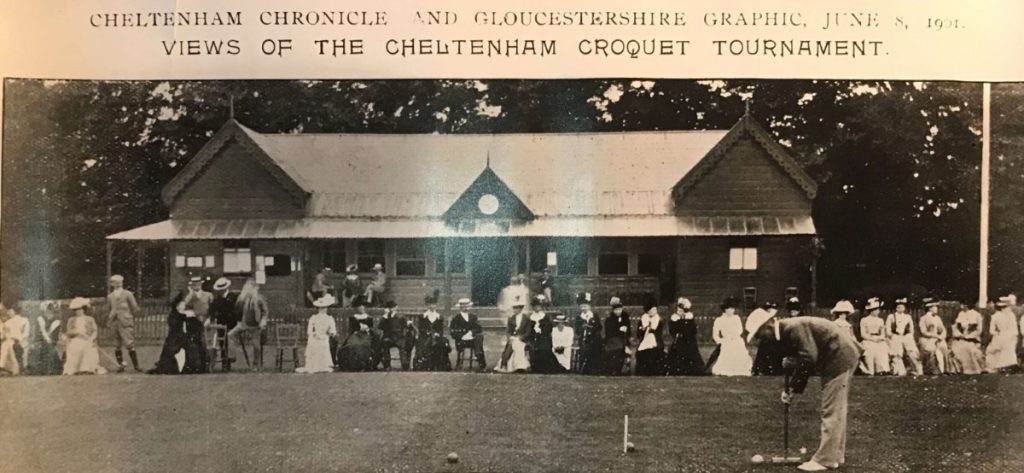
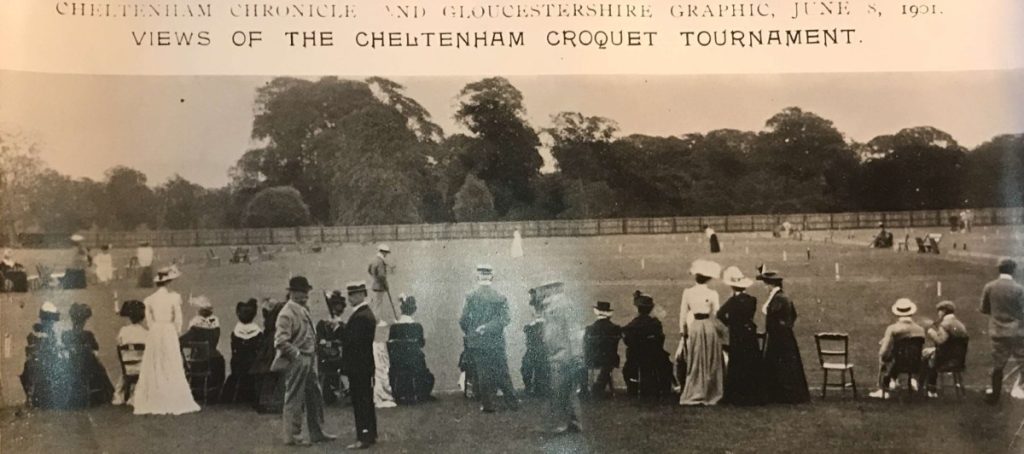
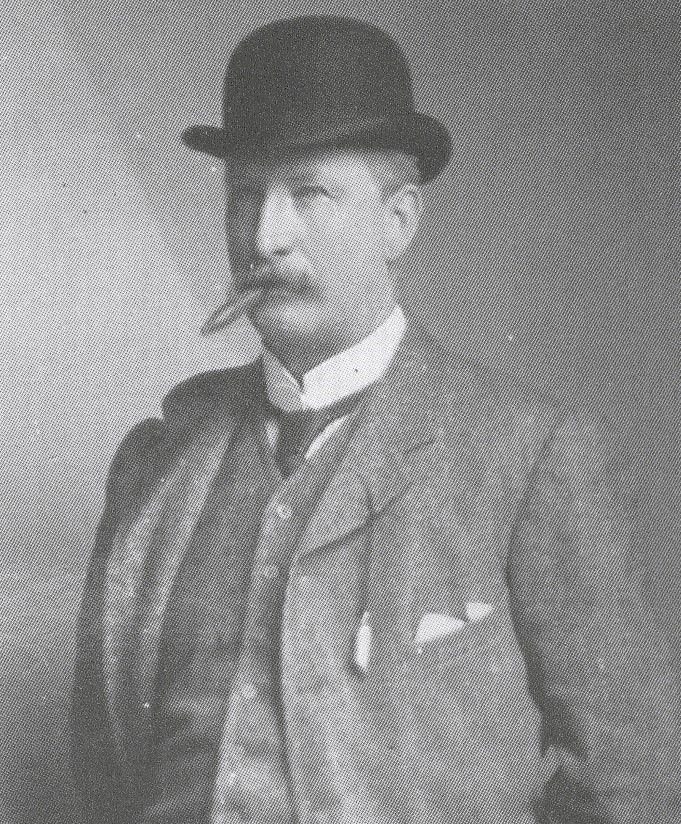 The arrival of Colonel William Leir
The arrival of Colonel William Leir
Colonel Leir was one of the most important influencers in the growth of women’s hockey locally and a driving force in forming the Western Counties Associations. He was a member of the influential Somerset Leir family, a long line of rectors of Ditcheat Priory near Shepton Mallet.
On arrival in Cheltenham at age 50, he becomes secretary and treasurer of East Glos, then to Gloucestershire and the west. By all accounts, he is a brilliant and charming administrator and press cuttings of the period are full of complimentary reports of his skills.
There are no records of where he came from in 1899 or why he was so dedicated to liberating Edwardian belles into what was considered a rather shocking unladylike outdoor activity. Neither is there any clue where he went after his involvement ended in 1914.
1900 to 1925
1903
New lease agreed with landowner
At the AGM, once again held at the Queen’s Hotel, there are 303 full members, 101 nominated members, 14 non-playing and 28 temporary. Subscriptions income is £39 more than last year at £435 5s, with £13 6d 6d from other sources. Cricket appears to dominate the proceedings, with no mention of tennis.
The buildings are in good condition, but a considerable outlay on fences and railings is anticipated. The honorary secretary Colonel Leir presents a draft of the new lease with the landlord, Mr Brassey. The rent will remain as present for five years with subsequent increases of £10 per year.
Under the lease, the committee is unable to allocate any part of the cricket ground for croquet, but the landlord has agreed that an extension of an additional three acres solely for croquet will be possible at £13 per year. The croquet members express concern that they will be unable to meet their obligations unless a grant of £25 can be allocated for fencing costs.
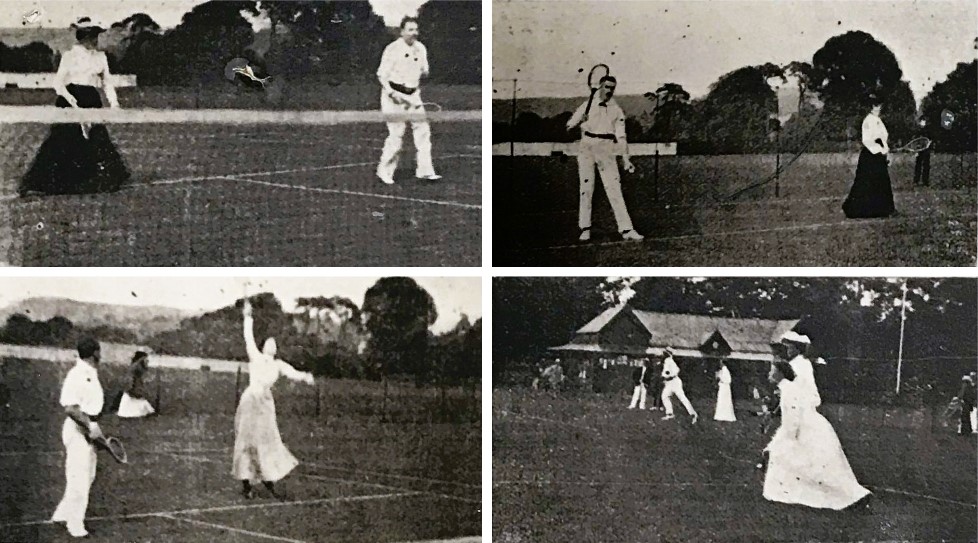
July 1903. East Gloucester Lawn Tennis Club Tournament.
1904
First ever England call-up for club hockey player
Barbara Kelly is selected to play for one of the earliest England teams in 1904. She becomes the first of 19 hockey internationals produced by East Glos in the ensuing years.
1905
“Induce others to join the club”, says club president
At the AGM, it is reported there are 418 members. Receipts are £386 9s 3d with costs of £378 6s 7d leaving a surplus of £8 2s 8d. Concern is expressed about a decrease of 15 members versus last year. The president, Mr J. T. Agg Gardner MP, feels there is only one way this decline can be addressed: inducing others to join the club. Nowadays, of course, we would describe such inducement as “marketing”.
An EGM follows immediately after the AGM to discuss a proposed rule change. The term “membership” will now denote those paying an annual subscription of one guinea (21 shillings / £1.05). Those paying a lesser amount will be denominated “subscribers” and will not enjoy the full rights of membership.
1906
“We’re the cheapest club in Britain”, asserts club secretary
At the AGM, Reverend P Hattersley-Smith is voted in as chair. At the previous year’s close, the club had 231 members, 74 nominated subscribers, 46 non-playing subscribers and 25 temporary subscribers. While the pavilion is in good repair, the drains are found to be outdated and useless. New drains are laid using “the most modern system.”
Income is £395 10s 4d and expenditure £374 16s 1d with a balance on hand of £20 14s 3d. To a round of applause, it is explained that expenditure has not increased due to the diligence of the honorary secretary Lieut-Colonel Clarke who has worked with his own hand to save on labour costs. Six members are approved as the committee, all of whom are men.
Lieut-Colonel Clarke makes two points where he asks for the assistance of the press to communicate to the broader community. The first is the myth that the club is a rich organisation and does not need financial support. He says that the club owes a few pounds more than it has in the bank, and by the end of the year, he had hoped it would make ends meet. He suggests this deficit can be addressed by many more non-playing members. He says there must be dozens of old cricketers in the town who, if they knew what the club had to offer, would love to come and spectate.
He wishes to correct the second perception that East Glos is an expensive club. On the contrary, he believes it to be the cheapest club in England, considering members can play tennis, croquet, cricket in summer and hockey in winter for a trifle more.
The thanks of Webb, the groundsman, are conveyed to the meeting for the sum of £23 raised by members to help him with his illness.
1907
The groundsman, Mr Gould, hurts himself at work, and a doctor, who is also a club member, is called. In these pre-welfare state times, he charges a fee appropriate to a club member. The committee, which is presumably footing the bill, is appalled because Mr Gould should have been charged as a “domestic”.
1908
A healthy surplus and croquet concerns
The AGM takes place once again at the Queens Hotel. There are 268 members, including nine debenture holders. Receipts are £521 19s 8d and a healthy balance of £119 19s 3d driven by new members and a decreased expenditure. A discussion arises on how to use the club’s surplus, with the treasurer suggesting £50 be put aside “for a rainy day”. However, Mr Pruen argues it should be used to pay off debentures. A motion for the latter is put forward and agreed by a large majority.
Lieut-Colonel Clarke, the honorary secretary, expresses concern about the croquet club endeavouring to cut adrift. He had prepared an alternative, but he says the croquet club appear to have everything so cut and dried that they do not wish to listen. He expresses concern that if they decide to cut adrift, it would mean ruin to their club. Clarke outlines his scheme, which would mean by amalgamating, the two clubs could raise an extra £100 per year, and the debentures easily paid off. A motion is proposed that it is undesirable for the two clubs to separate, which is unanimously carried.
However, later in the year, in July, the Cheltenham Examiner reports that there is to be a voluntary separation of the two clubs. Croquet will be free to develop on its own lines, unhampered by restrictions, however mild the parent organisation might have been inclined to impose.
1909
The club continues to grow
The club now boasts six tennis courts, a cricket pitch, two hockey pitches, and a tea room. The first county hockey match for ladies is played, and the club is also the venue for a county cricket match.
1910
Farewell to a founding father
The AGM takes place, and by now, it is being reported in much less detail by the press, particularly concerning finances. The balance in hand is £84.
In December, The Cheltenham Examiner reports on the death of one of the founding fathers of East Glos. Captain H.C. Willes dies at the age of 73. He took a leading part in the club’s foundation and was honorary secretary for its first seven years. The Examiner comments, “It was largely owing to his initiative and administrative ability that the club was placed in the front rank of local sporting clubs”.
1911
A healthy surplus and worst-ever cricket season
There are 278 members and a healthy bank balance of £84 19s 10d. Subscriptions income is £425 12s 1d. The croquet club contributes £14 13s for the use of the pavilion.
In March, according to The Cheltenham Looker-On, the club records the worst cricket season in the annals of the club. The weather significantly interfered with play, with 12 first eleven matches drawn.
1912
Plans for an open tennis tournament gain momentum
On 12th October, The Cheltenham Looker-On reports how a suggestion for a proposed open tennis tournament for Cheltenham is coming to fruition. Five challenge cups have already been promised, but three more are required to make the tournament successful.
According to the website A History of Charlton Park, on 13th July, there is a landing and take-off by Lieutenant Fox of the Royal Flying Corps in his plane on the East Glos grounds. The Gloucestershire Echo provides further details in that he is carrying out a qualifying flight from Salisbury Plain.
A novelty cricket match takes place with a team of 11 ladies beating an East Glos men’s team. The Cheltenham Examiner reports, “It is only fair to the vanquished to say they submitted to the disadvantage of batting and bowling left-handed, and to the further handicap of using round broomsticks instead of blades for striking purposes”.
On 27th December, The Gloucester Citizen carries a report of gifts donated to Cirencester Cottage Hospital. East Glos plays its part by donating an illustrated book and gifts from others, including crackers, eggs and chocolates.
1913
Players from all parts on the kingdom descend on East Glos
In June, The Cheltenham Looker-On reports on a successful inaugural open lawn tennis tournament. They write, “The entries include players of repute from all parts of the kingdom. Some fine play has been witnessed, and the excellence of the courts has called forth general praise.”
1914
Cricket, hockey and tennis continue to be enjoyed by members
There are now 269 members, 64 nominated subscribers, 35 non-playing members and 31 temporary and summer holiday members. There are 50 winter hockey members.
Income is £462 19s 3d with a deficit of £6 5s 10d. The club’s financial position is improving, though, as liabilities are £51 versus £98 last year.
Despite World War I having broken out in July 1914, the club has an excellent season, with the grounds being used more than in many previous years. The final instalments of the debt on the tea pavilion are paid off, and the cricket season is one of the most successful for many years.
The tennis section reports a “large accession of members, and the 14 courts are in great request”. The open tournament is a great success, but it is noted that grandstand accommodation is urgently needed. The ladies’ hockey section wins all 17 of its matches with 144 goals scored.
1915
Cricket fixtures and tennis tournament are cancelled
The annual report records 274 members. Total income is £536 10s 4d with expenditure of £476 13s 3½d and a deficit of £7 0s 5d.
It is decided there will be no cricket fixtures this year and no annual tennis tournament. A question arises about members absent due to serving in the forces. It is decided that subscription requests will not be made to such members.
1917
Subscriptions fall, but reduction in expenditure creates surplus
Despite the disruption of World War I, the club has a balance of £27 10s 8½d. There is a great falling off in subscriptions. Total receipts are £169 compared to £262 for 1915 and £536 for 1914. There has, however, been a reduction in many items of expenditure. The chairman, Sir James T. Agg Gardner MP, hopes there will be an accession of members in the coming year.
The sudden death is announced of former club secretary Lieut-Colonel Barrington Piers at his home, Overtonlea, in Parabola Road. He served in the Bombay Staff Corps for many years taking part in the Afghan War of 1879-80.
1918
The passing of the Rev. P. Hattersley-Smith at Glenfall Lawn casts a gloom over Cheltenham College circles. He had been associated with the college for nearly half a century. As an accomplished cricketer, his chief work for the sport was done at East Glos, which “owed much to his initiation and guidance on the business side as well as to his prowess on the sporting side”.
1919
Ladies permitted to join the committee
The AGM takes place at Messrs. Winterbotham, Gurney & Co. Ltd, a firm of solicitors, whom I assume are the club’s lawyers. Sir James T. Agg-Gardner MP presides. Income is £136 4s 6d with a fall in subscriptions income of £8. The year started with a deficit of £6 18s 3d and ended with a negative balance of £20 8s 8½d. Major Brassey, the leaseholder, had generously reduced the rent by 50% for the past season and has now removed the rent entirely for the current year.
A lengthy discussion ensues on the need to raise subscriptions if the club is to be carried on satisfactorily. New rules are then adopted, meaning members who joined before 1912 continue to pay 21s (a form of loyalty discount, it seems). Those who joined after that will pay 25s, providing they kept up their subscriptions during the 1914 – 1918 war. New members will pay 30s but with no entrance fee.
Another amendment to the rules is the decision to appoint ladies to the committee, albeit with a maximum number. It is resolved that the committee shall consist of nine gentlemen and three ladies. Miss Dorothy Hattersley-Smith, Miss Foster and Miss Grassett are duly appointed.
Lieut-Colonel Clarke steps down as secretary. He is praised for the admirable manner in which he has managed the club’s affairs, bringing it from “the depths of despair to a flourishing condition, and during the war worked it most economically”.
1920
Buy it or lose it: Committee has foresight to purchase the club’s land
The AGM takes place at Cheltenham College. The club has lost many prominent members over the past five years. At the last AGM, subscriptions were raised, and 145 have joined during the year. The accounts show receipts of £489 18s 4d and a deficit of £20 8s 8½d.
A considerable amount of extra labour was necessary in 1919 to get the cricket ground and tennis courts into order which had been untouched during the war. The groundsman, Ford, is to be commended for his efforts. Hockey had been restarted following the war, with men’s and ladies’ teams doing very well. No tennis matches were played, but a successful local tournament was held. Capt. R.B. Brassey is thanked for his generosity in waiving the rent of £51 for the 1919-20 financial year.
The committee has learned that Capt. Brassey is selling the Charlton Park Estate, but they hope to secure the ground in perpetuity for the club. The committee says it will only be possible for the club to remain viable if a considerable increase in income is provided for and has agreed to recommendations for subscription increases.
A discussion ensues on the club’s financial position. In the coming year, expensive repairs will be necessary, and an additional £700 will be needed to carry on with ease. There is no doubt the ground will be for sale, and to keep it, the club will have to purchase it, which will involve much more expense than the current rent. The committee’s recommendations on subscription increases are approved with a figure of £2 12s 6d for playing members, covering cricket, tennis and hockey.
On 19th June, The Gloucestershire Echo reports on the sale of Charlton Park by Capt. Brassey. Representations had been previously made to Capt. Brassey who has now agreed to sell the 8.5-acre ground to the club for £1800 (£63,800 at 2022 prices). The committee deliberates at considerable length and eventually decides to accept his offer. The question of how the money should be raised will be left to a future meeting.
The adjoining croquet club ground, which also forms part of the Charlton Park Estate, is also on the market. The tenants are in negotiation to purchase the property and are likely to become the owners.
In September, a private company is formed to purchase the ground. The money is raised by the issue of debentures, generously subscribed for by club members and others owning property nearby. The club will pay the interest on whose behalf the ground is held by the company. It is expected the debentures will be gradually repaid out of surplus funds.
The committee of the time must be congratulated for having the courage to make a decision which meant the club could survive. If they had taken the easy option and continued leasing its land, it is unlikely that East Glos, with its nine acres in the middle of a prime housing area, would exist today.
1921
Tennis proves popular for younger members of the community
The AGM takes place at the Plough Hotel. The meeting chair Lieut-Colonel T.S Clarke says there have been problems with the teas, but it has now been settled, and members can obtain tea for 1s per head. The membership now stands at 280, and the balance sheet shows a deficit of £15. Income is £820.
The meeting is not without controversy as it debates the matter of members who go on holiday in August for an extended period (as many did at the time) having to pay the full subscription. 20 members have resigned; however, subscription income has increased overall. An intermediate subscription is proposed, but the proposition is defeated following a lengthy discussion.
In a piece on the state of tennis in Cheltenham, the Gloucester Journal remarks on tennis’s popularity among younger community members. Every bit of available space in both Montpellier Gardens and Pittville has been “monopolised by its votaries”, not to mention the numerous courts at Charlton Park [East Glos] and at smaller enclosures dotted about the town.
1922
Tennis committee is formed
The first tennis committee is formed. Its first task is to raise £220 to lay the club’s first two hard courts.
1923
Tennis land grab
The tennis membership grows to 234, yet there are only 15 cricket members remaining. A controversial resolution is passed to use part of the cricket pitch for tennis.
1924
Winter tennis played for the first time; the end of cricket
Two hard courts costing £110 each are laid, enabling winter tennis to be played for the first time. The cricket section is struggling for members and is disbanded.
On Saturday 14th June, a tennis match between Gloucestershire and Wales takes place as part of the County Championship of Great Britain. In a similar fashion to our current County Week, Gloucestershire is part of a group comprising Wales, Somerset and Devon, with the counties playing each other.
The Gloucestershire Echo reports that the courts are described as being in splendid condition and that “East Gloucestershire Club has reason for thinking they are entitled to claim to be possessed of twenty-five of the most perfect courts in the country”.
1925
Local newspaper columnist impressed with ladies’ tennis
In June, at Cheltenham Police Court, William C. Clapham, 42, of no fixed abode, is charged with breaking into the croquet club’s canteen and stealing about 1lb of cake and a box of matches. He then broke into the East Glos secretary’s office and stole a pair of brown boots and a tin of tobacco valued at one guinea.
In a statement which reflects the desperate poverty many experienced in these times, Clapham admits the charges. He says he came out of Cheltenham Workhouse without any money and walked to Newport but could not get work. He pleads for leniency on account of his wife and seven children. He says if the magistrates give him a chance, he will never return to Cheltenham again. Clapham is committed to the Quarter Sessions.
In his Echo tennis column in May 1925, Clinton MqIlquham celebrates an improvement in local standards of tennis at Montpellier, Pitville and East Glos. He seems particularly impressed with how ladies have adapted their play. He writes, “This has been less noticeable in some cases than others, but nonetheless, there has been an improvement. Ladies, who a year ago would volley only – and then with a furtive giggle – of necessity, when caught out of position and unable to scuttle back to their baseline, now go boldly to the net with the avidity of a duck for water”.
Even as late as 1925, those employed by the club certainly know their place. The club professional is expected to clean both the shoes and the changing rooms.
1926 to 1950
1926
Play continues during the general strike
After a lengthy discussion, the committee decides that club matches should continue to be played despite the general strike. The general strike lasts nine days, from 4 to 12 May 1926. It is called by the General Council of the Trades Union Congress (TUC) in an unsuccessful attempt to force the British government to act to prevent wage reductions and worsening conditions for 1.2 million locked-out coal miners. Some 1.7 million workers strike, especially in transport and heavy industry.
The AGM takes place at the YMCA. There are 231 members, with 50 new members elected. Mrs Margaret Eyre is elected as hockey secretary. She would become a loyal servant of East Glos for many decades after that.
1927
Opportunity for talented young players to be coached by “really first-class men”
The inaugural annual club ball is held at Cheltenham Town Hall. It is described as one of the chief social events of the season. Mrs Margaret Eyre is chair of the ball committee. Geoffrey Goodhart’s London Band provides the entertainment. The event is such a success it will probably become an annual feature.
An advert for May half-term tennis lessons by the club’s resident professional appears in The Gloucestershire Echo. Under 18s can enjoy six lessons for 18 shillings. For those aged 19 to 24, the fee is 30 shillings.
The Lawn Tennis Association (LTA) adopts a new initiative whereby young players across the country will have the opportunity of being coached by “really first-class men”. There will be two local centres – Redland Green in Bristol and East Glos. The scheme aims to improve the standard of lawn tennis and encourage talent wherever it can be found.
In August, the death is announced of Mr Herbert Vivian Page, aged 64. Practically all his life was devoted to Cheltenham College; however, his services to local cricket, particularly at East Glos, cannot be measured. He started East Gloucestershire Hockey Club to keep the club’s cricket members in trim. Hockey was then in its infancy, but the club made rapid strides during his tenure.
1928
Used tennis balls advertisement in local newspaper aids fundraising effort
In April, the death is announced of Frank Tibbits of Leicester Terrace. An accomplished cricketer, he had previously worked as a groundsman at the club for many years.
11th August sees the death of former club president Sir James Agg-Gardner MP, aged 82. The local press describes it as a great demonstration of public sorrow. He is laid to rest beside his parents and sister in the family vault in Prestbury churchyard.
Also in August, the club advertises several dozen used tennis balls in the For Sale or Exchange section of the Echo at 5s per half dozen. This appears just above an advert from a lady who has some useful left-off dresses. She states they are “suitable for working women – cheap”.
1929
More tennis courts constructed
One of the hockey pitches is converted to provide more tennis courts.
1930
First Cheltenham Junior Open
The first Cheltenham Junior Open tennis tournament is held. It develops into one of the best-known events in the country. Many of the young stars use it as a warm-up for the National Junior Championships held soon afterwards. The annual hard court tournament is also held in October this year.
On 15th November, The Cheltenham Chronicle and Gloucestershire Graphic reports on the passing, aged 84, of Lieut.-Col Thomas Sydenham Clarke of Sandown Lane, Albert Road. In 1903 he became the club’s honorary cricket secretary and later club secretary and vice president. When World War I broke out, he took over management of the club’s affairs so that these might be in order on the return of its many members serving with the forces. In a long and distinguished military career, he saw service in the Afghan War (1878-79) and served in the Boer War in 1881.
1931
Sunday tennis is permitted
It is decided that members are allowed to play tennis on Sunday afternoons, but only until 6pm.
1932
Club asked to engage ball boys to ease unemployment
At a meeting of the Cheltenham and District Employment Committee, amongst other matters discussed, the chairman suggests a letter be sent to the club urging that to give slight relief to some of the unemployed, ball boys be engaged for the forthcoming tennis week. This is the time of the Great Depression, with 3.5 million unemployed nationally. In Cheltenham, 21 per cent of men and 9 per cent of women are out of work.
1933
Extra horsepower for groundsman
A pony is purchased for the groundsman at a cost of £30.
1934
Archery is introduced
The Cheltenham Archers had always shot at Montpellier, but in 1934 these gardens become open to the public and shooting there becomes impracticable, which brings about a move to East Glos.
1936
Wimbledon success for club members
Club members D.R. Bocquet and Mis P.M. Seaton win the Mixed Doubles Junior Championships at Wimbledon. Great credit is given to their coach Col. Berger.
1937
Most successful Cheltenham Open
The Cheltenham Open Tennis tournament held at East Glos is heralded as one of the most successful so far. The Davis Cup player Kho Sin Kie of China wins the men’s singles, doubles and mixed.
1938
Margaret Eyre becomes the UK’s first-ever female professional tennis coach.
The groundsman’s pony sadly becomes injured. Rather than replace it, a motor chassis is purchased and converted to a motor roller which is used to roll the hockey pitch.
1939
Critical situation as World War II breaks out
In May, in the Olympian column of The Gloucestershire Echo, the writer highlights two junior tennis players of exceptional promise – Miss Mary Eyre and Wyndham Calvert. Mary Eyre, a member of the well-known Lidderdale family, did very well in the handicap doubles at Cirencester the previous year. Mary, of course, played a significant part in the organisation of club tennis and hockey in later years.
An advert appears in The Cheltenham Chronicle for a “competent woman” to take charge of the catering department from April to October. It appears in the “Situations Vacant – Females” section – obviously long before the Equal Opportunities Act.
At the committee meeting on 5th September, two days after the outbreak of World War II, the treasurer Mr Seaton says the club is in a very critical situation. It is agreed that expenses should be reduced in every possible way. At the October meeting, Seaton recommends that the club be carried on for the present. The building society will be asked if the redemption payment on the club’s loan can be waived for the duration of the war. This is agreed for the current year, to be reviewed.
In December, the groundsmen apply for a wage increase due to rising food prices. They are awarded an additional 2s 6d per week.
1940
Committee strives to keep the club open
At a special general meeting (SGM) in March, numerous letters from members are read out offering suggestions to help the club get through this difficult time. Two motions are made to change the secretary’s role from paid to honorary and to reduce subscriptions. Both are defeated.
At the AGM in May, a rosier picture is painted by the treasurer, Mr Seaton. He says the club has progressed well in the last year despite the reduction in income due to the war.
In June, the groundsmen receive a rise of 8s per week due to the increase in the minimum wage for agricultural workers. Unfortunately, Leach is to be let go with a month’s notice due to the club’s financial state. It is also agreed that Thatcher should not work on Sundays and have one afternoon off weekly. Members will be asked to help with court preparation in further cost-saving measures. The committee agrees that the club should remain open for as long as possible.
1941
Tea room remains open, but members to bring their own tea
At the AGM, the meeting chair Col. Miller says the financial position is satisfactory, primarily due to decreased wages due to staff dismissal.
Despite being 20 months into World War II, club activities appear to have some semblance of normality. Junior and American tournaments and exhibition matches are a great success. However, due to the petrol scarcity, keeping the courts in good order will be difficult.
It is decided to keep the tea room open; however, due to food rationing, members will need to bring in their own tea and have it made for 2s 6d, including milk. Those bringing their own Thermos flasks and milk will pay 1s each for a cup and saucer. Members are also asked to contribute any tea they can spare as a reserve.
1942
Club participates in Holidays-at-Home programme
In August, an American tournament is held as part of a week-long series of events forming part of the Holidays-at-Home programme. The programme is to prevent unnecessary travel during World War II. Local authorities are encouraged to draw up a schedule of amusements for the summer months. The events are designed to save space on trains for troops and keep people at home.
In September, it is reported that there are only 118 entries for the junior tennis tournament instead of the usual 200. This is due to petrol restrictions and because some of the older juniors find national work that can be done in the holidays. The situation does not improve in later years, with only 34 entries in 1947, followed by an increase to 61 in 1948.
1943
Americans forces turn down offer of baseball facilities
Notices are sent to senior officers of the US Army at the various hotels that have been commandeered. A subscription of £1 10s is offered to service men and women for the rest of the year. The same is offered to the “American girls at the War Office”.
The club secretary regrets that because no petrol is allowed for her motorcycle, she will not be able to use her bicycle to come to the club twice daily. She hopes members can help by being in charge in the mornings or evenings.
It is suggested that the hockey pitch be let to the Americans for baseball to raise funds with a lump sum paid for the season. Captain Smool of the US Army subsequently declines this offer as they have made other arrangements. He later returns with an offer of £10, which the club rejects and asks for £25 until October. This is rejected.
At the May AGM, the chairman, Col. Douglas, describes the club’s state as critical, and he hopes members will encourage others to join. Advertising flyers have been distributed to local firms and hotels. However, by September, the club’s finances are described as satisfactory.
1944
Blacked out bar
Some members request that the tea room be blacked out when used as a bar. This is agreed providing the members bring their own suitable material.
1945
Indoor tennis courts and squash are first mooted
At a committee meeting, it is suggested that a hangar be put up on the grounds for badminton. Enquiries are to be made on where such a hangar can be purchased.
Later that year, the committee discusses the courts’ unsatisfactory state and laments that the groundsman takes no interest in his work. After a discussion, the committee is unable to come up with any solutions. At the same meeting, Dr Cowan suggests that the ladies of the club do more work in helping with the teas and that the bar might be cleaned by them occasionally.
In October, having asked for a fees reduction, men’s hockey ceases at the club.
Miss Badham, the club secretary, tenders her resignation. The chairman says that the last six years have been challenging, and had it not been for her help, it is doubtful whether the club would have been able to carry on.
A suggestion book is introduced. Members suggest introducing squash courts and covered tennis courts.
1946
Archery membership begins to fly
In July, the Cheltenham Open tournament takes place for the first time since the outbreak of World War II, although with none of the 1939 title holders taking part.
The Cheltenham Archery Club, which shoots at East Glos, reports at their AGM that they have come through their first post-war season with every promise of re-establishing itself. When activities re-started after the war, there were only three members; now, there are 17. It is agreed that the archery section can erect two targets on the hockey pitch if they join East Glos as full members and pay £3 3s each.
The committee receives a request for a double allotment, but it is decided that no more ground can be dug up. The existing allotment, which is presumably part of the World War II Dig for Victory campaign, is located at the site of the current practice wall.
In the first mention I can find of squash, the local Owe 40 club defeats a team from East Glos by 3-2. The Owe 40 Lawn Tennis and Squash Club was founded after World War I by Henry Holgate Yolland and his wife, Katherine. They bought some land on Old Bath Road and built a house and four tennis courts. The house was named Longuenesse after the place in France where they had worked together on the Commonwealth War Graves Commission. After Yolland died in 1939, the courts and the club declined, but in 1944 Major Ted Millman set about restoring the courts and reviving the club. Read more about this in The Cheltenham Book of Days by local author Michael Halsted.
1947
England hockey call-up
In October, club hockey player Joan Arkell is part of the England team, which scores its third successive victory in the United States versus Philadelphia, 3-0. She scores one of the three winning goals.
1950
Aspiration to make East Glos the best tennis centre in the west
In March an advert appears for a club secretary. The role will be suitable for a retired person with organising ability. There is a salary on offer plus participation in profits.
In June, The Echo reports on development plans for East Glos. The newspaper is told the aim is to make East Glos the best tennis centre in the west, and probably the best outside London. It is hoped to build two centre courts and stands to attract international players to the open tournament and stage first-class exhibition matches. At this time, the club has already enlarged its facilities with “cut-in” grass courts proving successful and bringing about many membership applications. A cut-in court is where the grass in cut to normal height but the area outside the white lines is left longer.
In July, The Gloucestershire Echo reports that the annual tennis tournament has attracted many names famous in the tennis world. 15 grass and five hard courts will be used for the event. These include A.G. “Paddy” Roberts, a former junior champion, and Howard Walton, an RAF champion included in last year’s Davis Cup trial list. Club members Mary Eyre and Pam Bocquet, fresh from their Wimbledon successes, should provide lively play in the women’s singles. On the Tuesday of the tournament, Mrs Bocquet’s car catches fire, and the flames are extinguished with promptitude by the club secretary Mr. “Topper” Brown.
1951 to 1975
1952
Wimbledon warm-up attracts top talent
In the 1950s, the club’s Open Tennis Tournament attracts national and international players. With the event played on grass, these top players find the event an ideal warm-up for Wimbledon. Over time the players come to expect hotel accommodation and expenses rather than the hospitality of members, and the club’s finances end up in a sorry state.
1957
Vickers saves archery from extinction
Since 1934 the archers had shot at East Glos, but membership remained low. It is not until 1957 that an appreciable number of new members join, among whom is Lieutenant General Vickers, under whose tutorage the club begins to undergo a new renaissance. The club equipment is repaired, and Vickers takes on the instruction of new members and almost all the day-to-day running of the club. He is largely instrumental in saving it from extinction.
1959
Decision to run the bar with voluntary help is unsuccessful
A finance committee is set up and holds its first meeting in April. One of their first decisions is that no overtime be paid to the groundsmen and that they should work alternate Sundays with time off in lieu. Income for the year is estimated at £1878 and expenditure at £1796.
At the 1959 AGM, a decision is made to run the bar with voluntary help. During the summer season, the system falls down and generates a surplus of only £50. It is agreed that paid help must be obtained for the 1960 season.
The potential for the sale of land arises at the AGM. Further discussions would take place with the planning officer, but no change is expected in their decision, and the authority’s attitude is very discouraging.
1960
The birth of Thursday social tennis
Club evenings, as social tennis was called then, will take place every Thursday starting in May.
A 1s 6d charge for entry to the bar on Saturday evenings proves unpopular. It is decided that only members who are actually dancing and still present at 11pm will be charged.
The question of publicity is raised at a committee meeting. It is agreed that the club’s activities are not reported by the local press often enough. For example, there was no report on the annual fancy dress dance.
The year closes with an income of £1,862 and expenditure of £2,091. There has been a fall in subscriptions of £100. The treasurer reports that if it wasn’t for volunteers’ various activities, subscriptions would need to be doubled. One of the fundraising efforts is a football scheme which generates £105.
At the AGM, it is reported that of four original club trustees, two have sadly died, and one wishes to resign. Miss Eyre, Col. Robinson and Mr Jones join Major McKay as trustees.
1961
Potential for sale of land gains momentum
The potential for the sale of land is back on the agenda, with the key benefit being it would fund a new clubhouse. Two options are discussed. Plan A is to have 14 plots, 32 x 100 feet along Old Bath Road, with a road running by the side. Plan B is for 16 plots on the north side but ten grass courts instead of 12 in Plan A. No decision is reached, and the trustees will be consulted.
At the AGM, subscription levels are increased to £6 6s for full playing members. There is also a husband and wife membership at £5 5s.
£12 is stolen during a hockey match despite the clubhouse being fully locked. The police are extremely helpful. In a true sign of different times, they suggest that a sergeant attends future games in plain clothes.
1962
Committee rejects land offer from Boys’ College
Subscriptions income increases by £100 year over year. The membership is 300, but surprisingly only 88 are full playing members. The budget has been balanced, but this is only by virtue of £300 of donations. Members are urged to play their part in introducing new members. A proposal for country membership to increase to 20 miles is carried at the AGM.
Cheltenham Boys College offers £10,000 for 1.9 acres of land to be used for a road to connect Old Bath Road with the new Charlton Park Estate. Because it would cost £4,000 just to replace the courts, the committee decides to reject the offer. It is felt the land is worth more than £10,000 should planning permission be obtained at a later date. It is assumed the land in question is the site of the overflow car park, behind courts 8 to 11.
In the Birmingham Daily Post, tennis correspondent David Talbot reports on the forthcoming pre-Wimbledon tournament at East Glos. Two of Britain’s leading players, Angela Mortimer and Ann Haydon (later Jones), are competing. Talbot says the only sad note is the lack of a strong local challenge. Without establishing the cause, he speculates that maybe the absentees did not feel it was worth entering, only to be beaten in the first round. He writes, “If this is true – and one hopes it is not – it is a sad commentary on the spirit of contemporary lawn tennis in Gloucestershire”.
The club continues to look at ways of raising funds in addition to subscription income. A notice advertising bunches of holly for sale will be placed at the club’s entrance, and Leach, the groundsman, will sell them.
The floodlighting of two hard courts is explored for the first time. Miss Eyre reports that an estimate of £400 plus posts has been provided. It is decided that with discussions reopening on the sale of land and money continuing to accrue, it would be better spent building a squash court.
The rent for the archery section is increased to £35 per year. In return, the pitch behind the targets will be mown weekly. Archery members will be included in the club’s membership list and be encouraged to use the facilities and help out with catering.
The courts are damaged by cattle which stray into the club from the adjacent Reeves Field, which belongs to the college. Before the construction of Charlton Park Drive in the 1970s, the field abutted the club’s land.
1963
Gloucestershire LTA laments lack of junior enthusiasm
The financial situation improves with a surplus of £500. Subscriptions increased by £47 the previous year, but by far, the most significant contributor was the Open Tournament which made a profit of £430.
In this year’s open tennis tournament, the top men’s singles seed is A. Palafox of Mexico, one of the few players to beat Rod Laver in his last year as an amateur. In the women’s singles Ann Jones, who went on to become Wimbledon champion in 1967, is defending her title.
The Gloucestershire LTA is a little perturbed at the seeming lack of enthusiasm for tennis amongst county youngsters. They ponder perhaps the talent exists but has yet to be discovered. Accordingly, the selectors arrange junior trials at East Glos in April.
Discussions on the potential sale of land rumble on. The college wishes to reopen negotiations, and it is decided no less than £14,000 will be acceptable. By March, there are no further developments as the college is considering alternative means of access to the new estate. By December, it is reported that the college’s planning application for blocks of flats eight or nine storeys high has been rejected.
1964
Discussions begin on new clubhouse
The club’s accounts report a loss of £227 and a decrease in subscriptions of £150; the bank account was never out of the red during the last season. No further progress is made on selling land for a new road (see 1962 above), so no income can be expected from this source. The finance committee agrees to recommend a reduction in full playing subscriptions to £4 10s, to be trialled for one year. The aim is to gain at least 32 new members. Once again, members are asked to help with recruiting new members.
In January, it is agreed that a new pavilion is necessary due to the constant repairs needed on the current building. The finance committee recommends that £10,000 should be spent on the project. Finance committee member Mr Stone suggests the siting of the new building must leave enough room for building (I.e. houses) along the Old Bath Road should this be necessary to cover repayments and subject to planning permission. It is also proposed to investigate the potential for a skittle alley to provide winter activities.
A Ministry of Education grant of £3,480 materialises for the new clubhouse, necessitating a further £8,000 loan. It is also agreed to approach the local planning officer for views on the potential for land sale. If the approach is favourable, an application for outline planning permission will be submitted to develop the frontage to Old Bath Road for housing.
In an arrangement which would be unthinkable nowadays, W.D & H.O Wills, whose brands include Woodbine and Capstan Full Strength cigarettes, sponsors the Open Tournament.
1965
Financial recovery; noisy children; LTA focus on indoor courts funding
The finances recover with a healthy surplus of £872, the best result for 15 years. The committee’s aim for 1964 had been to cut expenditure to a minimum and explore every possible fundraising scheme. Successes include £150 from Miss Eyre’s Grand National draw and £158 from Mrs Bocquet’s summer fete. The reduction in membership fees in 1964 has proved most successful.
At the AGM, the chairman says to run the club effectively needs voluntary help from 120 people, meaning every active club member has a job to do. He asks members to consider which committee they could serve on or help with.
The new clubhouse project continues to take shape. The estimated cost is now £10,000 plus £1,000 for a skittle alley. The grant offer from the Ministry of Education is now 30%. It now transpires that the Owe 40 Club is closing down, leaving Cheltenham with no squash courts. The committee is now considering converting the main room into a badminton hall and adding a squash court. This will increase the cost to £14,000 with the potential for a 50% grant.
The committee deliberates on how the £7,000 can be raised and is wary of taking out loans with guarantors as money would still need to be found to back the guarantors. Therefore, they recommend that part of the club’s land be sold for building. The best area would be the front gate up to the pavilion, which is currently used as a car park. At the AGM, the members are asked for permission to sell any part of the land should it become necessary and apply for planning permission. The motion is carried.
Also, at the AGM, there is a discussion on providing facilities for members’ children. The club is being inundated with children who make quite a lot of noise. Miss Eyre proposes a children’s corner with parental supervision. This goes back to the committee to elect a sub-committee to consider it.
Col. Grimley is appointed as part-time secretary at a salary of £3 per week for 20 hours.
The LTA announces a scheme to allocate £150,000 for building covered courts in selected towns. The committee suggests Cheltenham should stake a claim, and Mr Jones is asked to apply accordingly.
1966
Best financial year ever; construction begins on the new clubhouse
The AGM reports the best financial year in the club’s history. The club now has enough spare funds to invest some of it in a building society account. Mr Jones, chairman of the open tournament committee, advises that the event is the fifth most successful tournament in the country yet spends less than any other tournament on players.
A motion is carried to form a table tennis section with an additional subscription of 10s for club members. Non-members can join for £1.
Approval is given to engage Mrs Pam Bocquet as the club’s tennis professional. She says she will organise some mornings for lady members and get clothes from sports firms to put on a model show. Mrs Bocquet’s father Mr R.B. Seaton was treasurer and then chairman in the 1930s and her mother was an honorary life vice-president.
At the September committee meeting, the chairman says that if the new clubhouse goes ahead, every endeavour must be made to maintain the source of income derived from social members. Rather surprisingly, these form the bulk of the membership.
In November, it is agreed to engage Messrs. Russell to build the new clubhouse, who have provided the lowest quote of £10,969 (£167, 000 at 2022 prices). Construction starts in the latter part of 1966. Many of the older members regret the disappearance of the old clubhouse, saying it had character. It also had dry rot, one bath and outside toilets.
1967
New clubhouse opens
The new building is opened by the mayor on 24th June.
Despite a couple of good years financially, the treasurer says this year’s profit is not enough. He says profit must continue to rise, and fundraising efforts must continue. He says the hockey section does not pay its way and suggests they have separate accounts to see if they can make a profit. It is decided to ask the bank for an overdraft. On the fundraising front, there is some good news as a jumble sale raises £60.
Those pesky kids. A notice is displayed warning juniors not to play on or in the new pavilion.
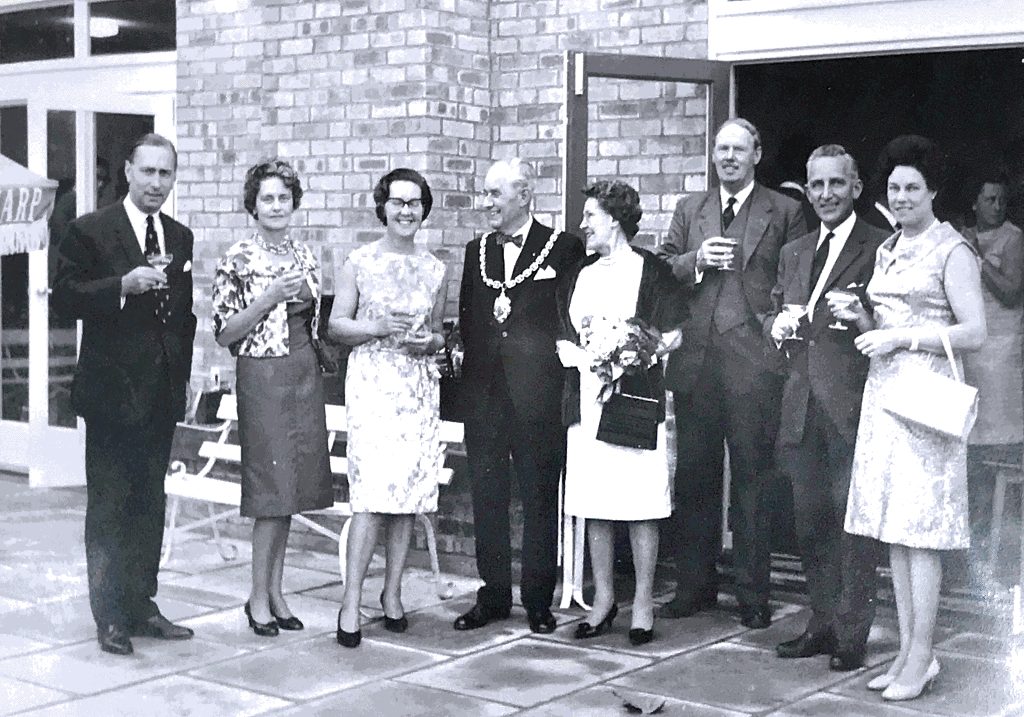
24th June 1967. The new clubhouse is opened.
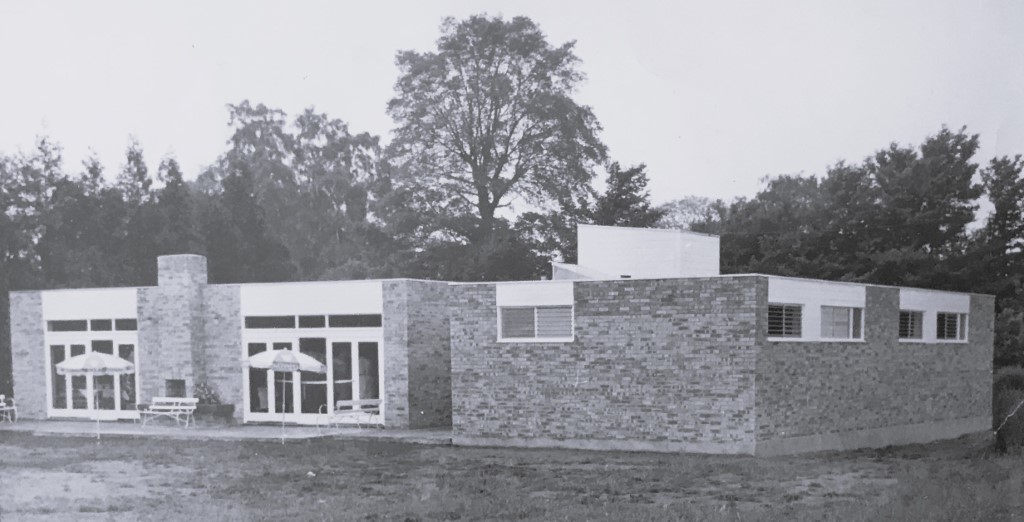
1967. The new clubhouse.
1968
Recognition for 60-year member
The first AGM takes place in the new clubhouse. Consideration must now be given to improvements in playing facilities and “non-attention” or even covered courts. We take “non-attention” to mean low maintenance, all-weather surfaces. Mrs Margaret Eyre is presented with a bouquet to recognise her contribution over 60 years of membership.
1969
Top stars expected at pre-Wimbledon tournament
A selection of top English and overseas tennis stars is expected at the pre-Wimbledon tournament at East Glos in June. These include Ram Krishnan of India and Richard Crealy, the Australian number four. It is also hoped the Truman sisters, Christine and Nell, will be competing.
1970
Tennis and hockey not self-supporting, says club chairman
This year’s surplus is £600, but subscription income is down due to fewer junior and hockey members. The treasurer Mr Hewitt says the £600 is not enough to cover loan repayments. The bar and fundraising keep the club going, as tennis and hockey are not self-supporting. He says there are several significant expenditures in the coming year, and we must increase income.
The chairman, Mr Maxwell, congratulates the fundraising committee for its efforts and says if the fundraising income is not up, it is due to the apathy of most of the members who do not support club events.
A discussion takes place about adding another social tennis night. Most people think it would be good to have an organiser; however, Mrs Kerr says one cannot force people to mix. A motion is proposed and carried to introduce the additional session.
Mr Malvern reports it has been a good table tennis season but is leaving the area, so he cannot continue to run the section. With teams dropping out of the league, he is worried about the hire cost of the table if no one will take his place to run things. The treasurer says the section is an expense to the club, and a motion is carried to end the section and send the table back.
In August an international tennis match takes place. The British women’s professional tennis coaches’ team takes on Holland.
1971
Squash courts and new tennis courts get the go ahead
At the AGM, Mr Hewitt, the treasurer, says 1970 was a year for returning to normal. Membership is up, tournaments have done well, and there has been a decrease in ground expenditure. He comments that the bar and social events generate the club’s profit and are run by 20 volunteer members.
Social events were varied and numerous during the previous year. These included a wine and cheese party, a fashion show and the Arthur Negus Show. Negus was a well-known TV antiques expert who lived locally.
It is evident from the minutes of AGMs from this era that detailed discussions took place on topics such as social tennis organisation, with votes and decisions being taken at the meeting instead of being referred to the relevant committee to consider.
A proposal is carried to introduce an entrance fee (or joining fee) of £2 for all full playing members. This is paid only once but acts as a penalty if the subscription is not paid by 1st June.
An EGM is held in July to discuss building two squash courts and two Tennis Quick all-weather courts at a cost of £14,700. The project was approved at the AGM in March, with a members’ loan scheme started.
1972
The advent of squash; all-weather play; limit on members
The first two squash courts are opened. Major Ted Millman, who had previously run the now-disbanded Owe 40 club nearby, is appointed the official coach. It is soon that both the men’s and women’s teams are making their mark and are among the top in the country.
Two new Tennis Quick courts are opened, making tennis possible all year round for the first time. The courts are floodlit later in the year.
In June, club chairman Mr Earland outlines his thoughts for the club’s long-term plan. These include a covered link to the squash courts; four more squash courts; a covered tennis court; a swimming pool; floodlighting the hard courts; resurfacing the shale courts; a bungalow/staff quarters. A sub-committee is proposed to look at all of this.
Full-playing membership is now 350, but to limit numbers, it is agreed new members can join at the start of the season up to a 350 limit until the following August. Despite this cap on membership numbers, the year ends well with a surplus of £1000 more than expected.
A committee discussion takes place on the white-only clothing rule. Mrs Kerr says that even county players are playing in tracksuits now. Miss Smith proposes that coloured tracksuits and trousers are worn only between 1st October and 30th April, which is carried 10-1. The committee agrees to help with the enforcement of the all-white clothing rule.
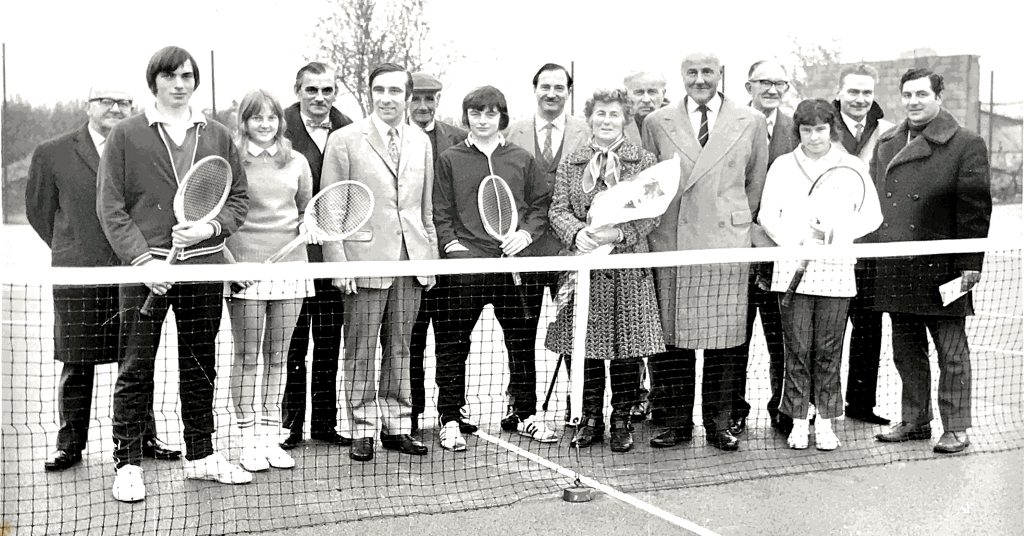
1972. Opening of the new Tennis Quick courts
1973
Club chairman dreams of indoor courts and swimming pool
At the AGM, the treasurer, Mr Hewitt, is upbeat, reporting the club’s largest surplus ever, despite expenditure continuing to rise. The chairman, Mr Earland, says if this year goes as well as last, he hopes to see his dreams come true one day with a swimming pool, indoor tennis courts, two more squash courts and full-time paid staff.
Len Horder and Dick Garstang are thanked for their voluntary efforts, which saved the club hundreds of pounds in labour costs. It is felt the club cannot continue to rely on voluntary labour, and it should expect to double its wage bill in the future.
The subscriptions are set at £8 for full playing tennis members and £7 for squash.
The club experiences its first streaker. It is unknown if they were protesting about something or whether more streakers followed in later years.
1974
Ambitious proposals floated at EGM; three-day-week impacts court usage
The financial situation continues to improve, with a surplus of £3,500 for the year ending in March. Planning permission for two more squash courts and an air hall for tennis is turned down.
The staff wages are reviewed. Mr Newman will be on 75p per hour, Mr Leach 50p and Brian Wright (described in the minutes as “the new boy”) will get 30p until he is 16, then an increase. The secretary will be paid £710 per annum.
The two new floodlit courts are only used for one month in the 1973-74 winter season due to the energy crisis and the three-day week, which lasted from 1st January to 7th March 1974. The three-day week is one of several measures introduced by Edward Heath’s Conservative government to conserve electricity, the generation of which is severely restricted owing to industrial action by coal miners and railway workers.
All the paid staff continue to work on a part-time basis. At the AGM, the club chairman feels this must be addressed and that the wage bill will need to increase. Ted Leach, one of the groundsmen (now no longer referred to by his surname only), completes 50 years of service with the club and is given a present.
Mr Selby for the tennis committee reports it has been a challenging year with a large playing membership but few courts available. He says it is tournaments that raise money for the club, but the committee has taken steps to lessen the effect of tournaments by scheduling them over a longer period and not having an open event. Volunteers are sought to help get the shale courts ready. The shale courts were on the site of our current hard courts, 28 to 31.
In an early example of transparency, following a question from member Mr Chambers, it is agreed that a summary of executive committee meetings will be posted on the notice board.
A complaint is made about sweaty squash players in the bar. It is suggested a can of air freshener or deodorant be placed on the bar counter.
An EGM is held in October with ambitious proposals for two more all-weather courts; relaying of two shale courts; an air hall; staff accommodation above the clubhouse, and additional changing rooms. It is unclear whether the proposals were for all these or just a selection. The EGM approves two more all-weather courts. It is hoped to raise funds through a members’ loan scheme and to ask the LTA how they can help.
1975
Auditor recommends club needs to be more forward-thinking financially
A more professional approach to staff management is introduced with all staff now having terms of reference and conditions of employment.
At the AGM, the chair, Mr Stapleforth, comments on the professional standing of various club members. Major Millman is secretary of the Professional Squash Coaches Association; Pam Bocquet is secretary of the Professional Tennis Coaches Association; and Lionel Jones was Gloucestershire Tennis Association chair for 25 years. In sporting achievements, Tess Lawrence and Deanne Murray are international squash players and Mary Eyre, and Shelagh Davson are the two top hockey umpires in England.
Concerns over the financial management of the club are expressed. Mr Sanger Davies, the auditor, suggests that the committee be more forward-thinking, maybe seven to eight years ahead. A forward budget should be presented to the members with the annual accounts. He says a minimum £2,000 contingency fund should be built into the budget and that day-to-day problems must work by budgeting monthly.
Mr Macauley for the squash committee says there are now 240 members and 100 off-peak. Due to the high demand for courts, he wonders if membership numbers should be reduced through natural wastage. He adds the situation is not helped by members who book courts and don’t turn up.
Len Horder is made an honorary club member for his tremendous contribution over the years.
Cheltenham Archery Club holds a 24-hour sponsored shoot at East Glos in aid of cancer research and Gloucester boys’ clubs. Organiser Mrs Pat Herboldt says, “We have rigged up gas floodlights, and the 12 people taking part expect to shoot 7,000 arrows”.
1976 to 2000
1976
Court manufacturer En-Tout-Cas visits the club to promote padel
In January, court manufacturers En-Tout-Cas visit the club to promote “paddle tennis”, as it is described in the minutes. The chairman asks if anyone would like to try the game in Leicester. “It is a mixture of tennis and squash”, he explains.
There is a huge turnout for the AGM, with 158 members present. Following a request that a common subscription is looked at, the chair, Mr Stapleforth, reports the subject has been thrashed out at three consecutive executive committee meetings, but 11 to two were not in favour.
The AGM votes to increase subscriptions by 10% and light fees by a whopping 50%. In any other business, Mr G Coates says he feels anyone serving on a committee should be completely unbiased and, if not, should step down. It is unclear in which areas he feels committee members should be unbiased.
Club ties are now on sale at £2.50. The ladies ask for scarves and badges to be procured.
An archery and darts social event is held, with the archers shooting with bows and arrows, not darts. Prominent notices are put up warning members of the danger. Social events at the club continue apace, although some continue to lose money. These include a fashion show, barn dance and dinner dance.
Compared to the present day, when our board mainly focuses on major topics, from the meeting minutes, it seems that even the most minor decisions seem to have to come through the executive committee, including topics such as requests to book the meeting room.
1977
Squash stalwart recognised with honorary membership
Full playing subscriptions are now £17.50. There was a previous proposal from the committee that the number of tennis members is reduced from 350 to 300. A revised proposal is put to the AGM that this is deferred by 12 months, carried unanimously.
In a discussion on rule changes, one committee member feels the club chairman should be elected at the AGM rather than decided upon by the executive committee afterwards. He is voted down on this.
Also, at the AGM, Major Ted Millman is granted honorary life membership for his help during his many years of association with the club. It is also proposed that Ted Leach, the groundsman be given a pension of £6 per week when he cannot continue working at the club. This is carried unanimously. Nowadays, of course, such personnel matters would be considered confidential and not discussed at an AGM.
1978
Difficult financial year drives large subscriptions increase
1978 is a year of landmarks for longstanding members and staff. Ted Leach, the groundsman, retires after 55 years of service, starting in 1923. Brigadier Percival, a long-time member and former president and chairman, is granted honorary membership. Pam Bocquet decides to retire as club tennis coach after 18 years. She will continue at the club working full time as secretary. Mrs Hilltout is appointed as her successor.
Mr Phelps, the treasurer, reports on a challenging year financially, and caution must be given to expenditure. There is a small surplus, but this has been used to pay back loans. Subscriptions will need to be increased mainly due to paying for full-time staff and pension contributions. Full playing tennis membership will now be £25, representing a 42% increase over the previous year. The club is expected to only tick over at this level, and further increases may be necessary next year.
Some members are unhappy about dogs on the grounds and feel they should be banned. After discussion, the existing bye-law remains, permitting dogs on leads but not in the clubhouse.
1979
£45,000 expenditure approved by members for development
The yo-yo financial situation persists, and the finances are viewed as satisfactory, driven partly by the bar and the social side of the club.
Discussions take place on future developments. A sum of £45,000 expenditure is authorised by the members. £30,000 is for two more squash courts and the rest for hard tennis courts. Assumptions include a 50% increase in squash membership. A postal referendum had taken place regarding the preferred surface for the new tennis courts. Only a small number of members voted. Interestingly 42 members voted for shale courts and 59 for all-weather.
1980
Squash expands with two more courts
Two new squash courts are opened to complement the existing two courts, which opened in 1972. However, progress has stalled on developing the tennis courts. The squash courts, which were previously a standalone structure, are linked up with the clubhouse.
At the AGM, it is proposed that a full-time manager be appointed to enable the club to be run more professionally. The committee feels they could “get one for £6,000”. Despite some opposition, the proposal is carried 42 to 11. The following year, a lack of funds prevents this appointment from going ahead, but staffing is increased by appointing a part-time assistant to the secretary.
In other business, Mrs Margaret Eyre donates £10 to the club in gratitude for her 70 years of membership.
1981
Social committee resigns en masse
This year sees more floodlights installed. At the AGM, Malcolm Sainsbury reports that 11 social events have been held in the past year with £162 profit. However, he expresses disquiet about the lack of support for these functions and says the social committee are all resigning.
A junior assistant groundsman, Stuart Dominey, is taken on. Stuart will later become head groundsman.
The committee again considers the possibility of selling land but is unanimous that this will only be regarded as a last resort.
1982
The end of archery
During a county match an archer shoots an arrow which falls onto a tennis court, narrowly missing a player. It is decided that the club is no longer big enough for the sport. Because of the apparent danger, it is stopped, and a year’s rent is returned.
The Cheltenham Archers find themselves homeless and end up leading a somewhat nomadic life sharing grounds with other clubs until, thanks to the Herculean efforts of the then committee, a home at Cheltenham Racecourse is found, which they continue to occupy today.
The annual auditor’s report states that loan repayments and capital expenditure have exceeded the cash generated. The liquidity position has worsened, and the club should focus on increasing operating profits to see some return from the considerable capital expenditure in recent years.
At the AGM, there is a proposal to reduce the size of the executive committee because the large number of committee members is resulting in lengthy meetings. The motion is carried 84 to 4. There follows a long discussion on the subscription levels proposed by the executive, which are due to future demands on capital expenditure and heavy borrowing costs. In 1982, interest rates are sky-high at 14%. Some members feel the increases need to be even higher. The proposal is amended to allow for increases 10% higher than those proposed by the executive and is carried 72 to 20.
Martin Horder proposes that the club installs a TV set. The motion is defeated 9 to 37.
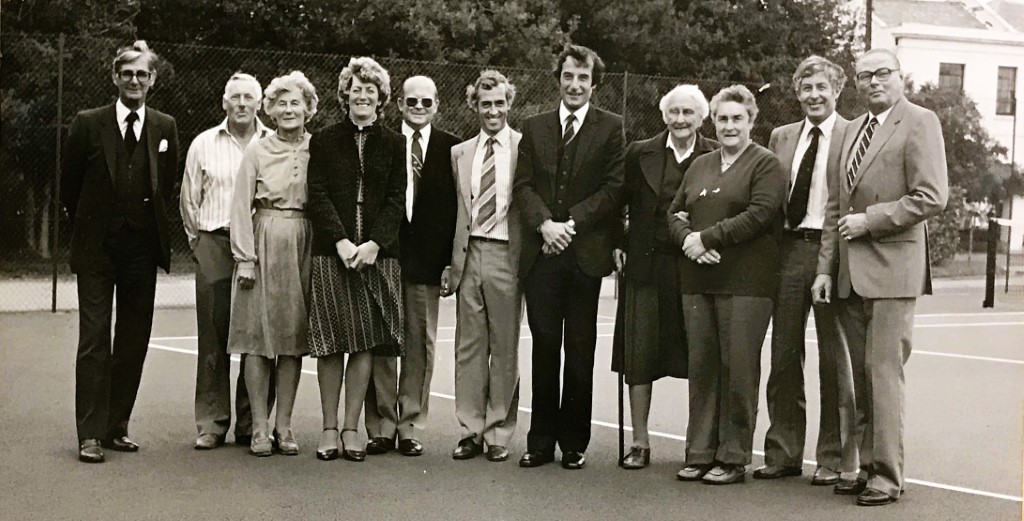
1982. Opening of the new Pladek courts.
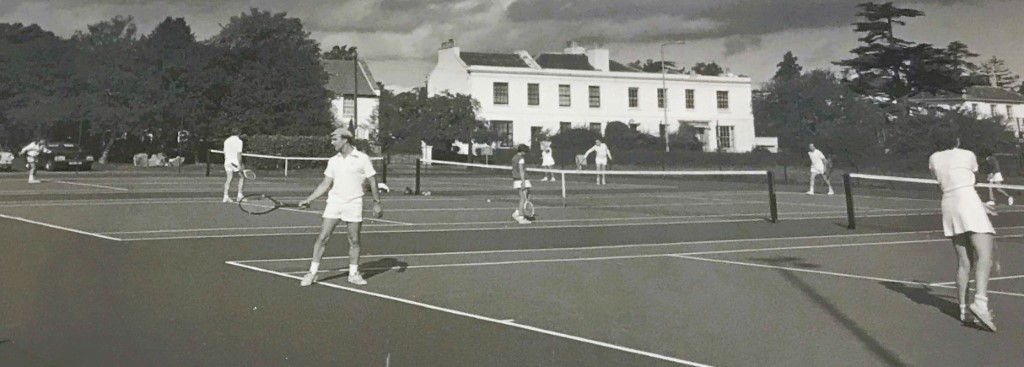
1982. The first games on the new Pladek courts.
1983
AGM inefficiency: Proposals, amendments and riders
At the AGM, Mary Eyre becomes the new club chair taking over from Gordon Thomas, who has served for the previous two years. By this time, Mary had already been a significant contributor to club life over many years.
Membership fees are set at £60 for full playing tennis and £43 for squash, with an entrance fee of £10. Miss Seekings feels the junior hockey subscription is too high at £21. Junior tennis is only 50% of the adult fee, whereas hockey is 77%. An amendment to the AGM proposal is carried by a large majority, and the subscription is reduced to £12.
The debate around membership fees doesn’t end there. In what must have been a very lengthy meeting, a further three proposal amendments are put forward, and two riders are then attached to those by others. The proposal in its final form is defeated by 24 for and 36 against. This is a far cry from how the club is managed today, where the board is entrusted to manage the club’s affairs without recourse to the members, except for major financial decisions and other fundamental changes.
Gordon Proctor is appointed as the club tennis coach.
1984
Steps to avoid lengthy AGM debates on subscriptions proposals are thwarted
Mrs Margaret Eyre, who is now an honorary vice-president of the club, celebrates 75 years of membership, having joined in 1909 at the age of 18.
The full playing membership is now 380 for tennis and 270 for squash. 53 are dual members. A rule change is proposed at the AGM for the adoption or rejection in their entirety of subscription proposals recommended by the executive committee. The rationale is to avoid undue disruption of their budget projections caused by counter-proposals requested at the meeting, as has happened in recent years. The proposal is defeated as there is not a two-thirds majority, although 50 are in favour.
In other business, the topic of buying a “coloured TV” is raised again; however, most members are against it.
1985
Club celebrates its centenary
The four shale courts (current courts 28 to 31), which existed for 60 years, are resurfaced and include an automatic watering system. They are the venue for an England v Wales international match in September.
Income is down once again despite an increase in subscriptions. This is due to a fall in squash membership. Due to the economic climate, a freeze on capital expenditure is implemented.
1986
Treasurer concerned over financial future of the club
At the AGM, Mr Brooke, the treasurer, says he is concerned about the club’s financial future. He feels it has been underfinanced and undercapitalised for some years. The club has no reserves or contingency funds for unforeseen problems. The proposed subscriptions are £78 for tennis full playing and £45 for squash.
In other business, a member asks about better ventilation for the clubhouse because the smell from smoking is awful.
1987
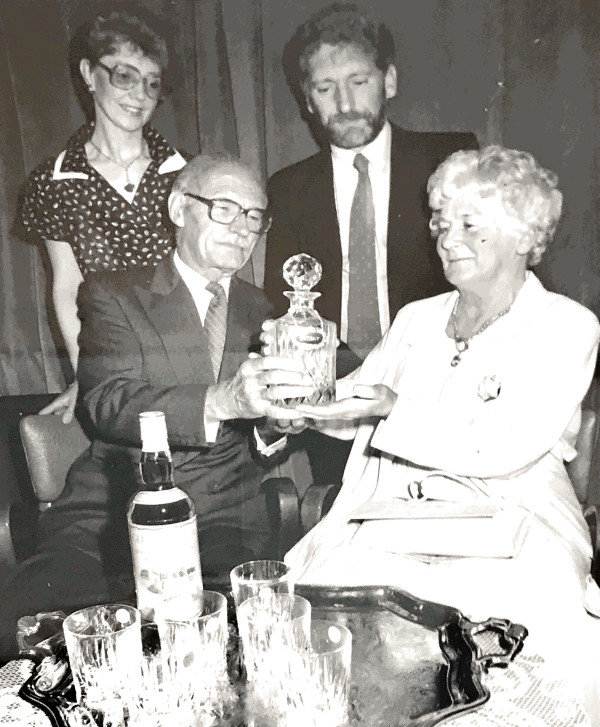
1987: Pam Bocquet receives her retirement gifts from club president George Marshall, watched by Christine Peers and club chairman Malcolm Sainsbury. Click for larger version.
Covered tennis courts and potential land sale back on the agenda
At the AGM, the topic of covered tennis courts arises again, along with the potential for the sale of land to fund this. It is agreed there is much to be looked into. Malcolm Sainsbury becomes club chair taking over from Mary Eyre, who held the post for three years.
Pam Bocquet retires after 22 years of service as club coach and, latterly, club secretary. She is granted honorary life membership. Christine Peers takes over as secretary.
There is now a contingency fund which totals £2,500. The treasurer feels the club can feel confident that it is on the way to a healthy existence and certain survival, although there is some way yet to go. Net income is £9,787. Full playing tennis subscriptions are set at £101. Squash continues to be significantly lower at £60.95.
1988
AGM resolution to approve sale of land in principle is heavily defeated
At the AGM, the potential for selling land to finance covered tennis courts and additional squash courts is discussed. A resolution to approve in principle the sale of half an acre of land is defeated 20-66. A key reason is that this is a general proposal to raise funds instead of a detailed proposal on how the funds would be spent.
Mary Eyre is awarded honorary membership in recognition of her tremendous contribution during 50 years of membership. This follows a letter signed by 80 members recommending such a move.
1989
Major capital improvements canned due to low likelihood of planning permission for houses
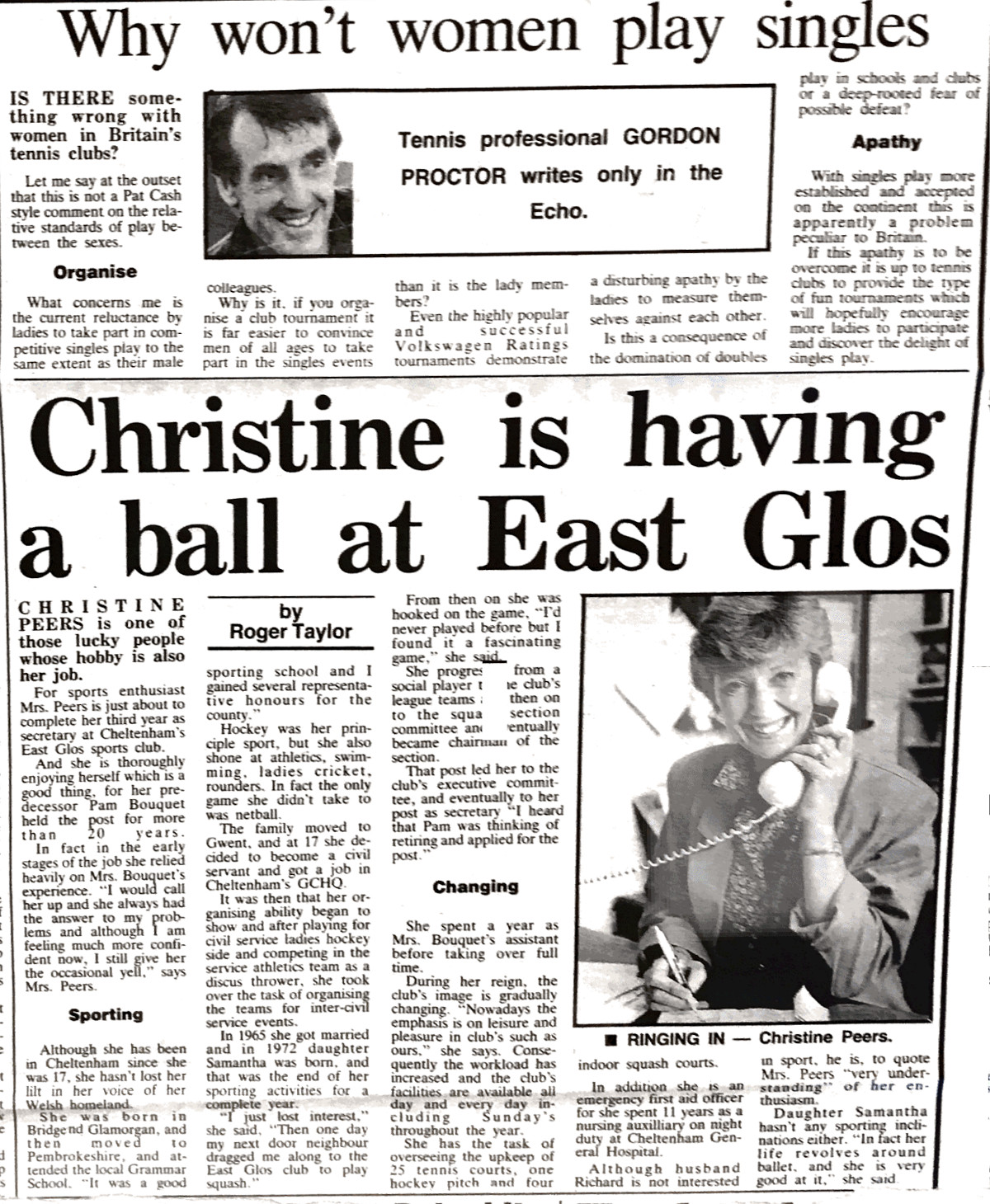
Late 1980s: Gloucestershire Echo feature on club secretary Christine Peers. Above that, the weekly tennis column from club tennis coach Gordon Proctor.
At the AGM, club president George Marshall stresses the importance of maintaining a good balance. Some clubs have better facilities, but many have a lot less. He says with commercial giants investing so much in the leisure industry, private clubs will find life more challenging, and many will struggle for survival. The surplus is £10,000 although this is down on the previous two years, mainly driven by increased staff costs of 22%.
Also, at the AGM, a report is presented by the development committee. A major exercise has been carried out to look at future club developments and how these could be funded by grants, loans and selling land. It is estimated that some land could be sold for £287,000; however, the various initiatives could cost around £500,000. These include two covered courts, a squash court, and major clubhouse improvements.
The planning officer had visited the club, and although not opposed to the concept of covered courts and clubhouse improvements, he is doubtful about building houses because the club is in a conservation area. In light of this and the difficulties in pursuing significant capital improvements, a reduced proposal to floodlight three hard courts is carried 89-18.
The majority-white clothing rule is abandoned as it is proving difficult to enforce. From now on, members will be asked to wear recognised tennis clothing.
An evaluation commences regarding implementing a computer system in the club’s office. The anticipated cost is £6,000, with an annual cost of £1,000.
1990
First club manager is appointed
The word “racketball” is added to the club rules in recognition that it is now a permanent sport at the club.
Chris Peers ends her time as club secretary. Anne Sadler, former deputy manager at the Northern Tennis & Squash Club, is appointed as her successor but as club manager. The club decides to create the role to encompass broader responsibilities. There is disquiet among some members that with the disbanding of several sub-committees, the club’s democracy is being eroded.
New club treasurer Peter Coutts reports that still no reserves have been set aside. Although the balance sheet is not in a healthy state, the financial position of the club can be held in the coming year. He says he has undertaken a review of the club’s banking and that the club had seven bank accounts. He rationalised these two, a current and a deposit account.
Unusually at the AGM, there are two candidates for president, Gordon Thomas and Mary Eyre. It is a close-run election, with Gordon winning the vote by 48-45. Malcolm Sainsbury steps down as club chairman, and Guy Vowles is voted in.
The full-playing subscription rates are passed unanimously at £133 for tennis and £78 for squash, which is a 10% increase in line with inflation.
The Gloucestershire Echo features an article on club squash coach Liz Elgood and her recently achieved county squash record.
1991
Feast or famine financial situation persists with £10K year-end deficit
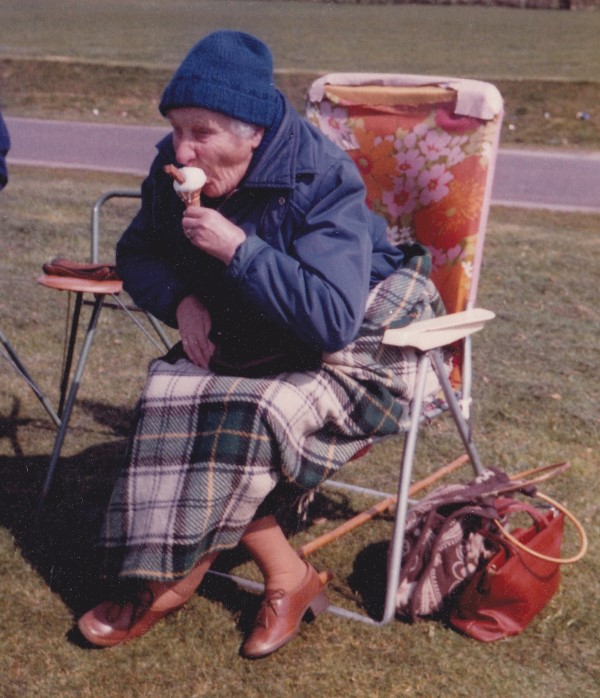
Margaret Eyre watching a ladies hockey match.
Margaret Eyre passes away aged 99. A former hockey international and top tennis player, she joined in 1908. She was a loyal contributor to club life over many decades.
A computerised accounting system is introduced. The role of the treasurer becomes more of a financial adviser, with bookkeeping carried out by the club staff.
At the AGM, George Marshall, chair of the development committee, explains that large-scale developments such as indoor courts and a second storey on the clubhouse have been replaced by more realistic priorities of maintaining the high standards of the current facilities. Phase one is proposed as the floodlighting and resurfacing of the four Tennis Quick courts and creating a viewing area behind squash court three. This is passed at a subsequent EGM in August. The projects are funded by a 5% levy on subscriptions.
There is also talk of a larger £180,000 project to build 12 floodlit tennis courts, which could also be used for hockey, on the grass hockey pitch at the back of the club; however, it appears this never progressed.
A new rule that freezes the subscriptions of all members 70 years old and above comes into force. Less than a dozen members will fall into this category which presumably means that compared to today, not many older members were playing at the club.
Two new rules are introduced. Direct debit subscriptions payment will be allowed for the first time, and the executive committee is permitted to raise subscription levels by up to 10% without the authority of members. This is considered a sensible measure as budgets are drawn up three to four months before the AGM. It will also remove the lengthy debates and counter-proposals prevalent at AGMs in the past. It is felt that the elected executive committee should be allowed to manage the club.
Chris South is appointed club manager, replacing Anne Sadler. The club mourns the passing of longstanding former groundsman Ted Leach, aged 90.
There is a continued emphasis on fundraising by members. Events include a sponsored walk which raises £400, and a car boot sale which raises £50.
By December, the club is running at a deficit of £10,000. Severe budget restrictions come into play to reduce costs. The club manager advises the office will need to reduce its hours and that some work will need to be carried out by committee members.
1992
Fire breaks out: Clubhouse is partially rebuilt
The clubhouse is partially rebuilt following a fire. At 2:15am firefighters have to break into the building and it takes over an hour to bring the blaze under control. Assistant Divisional Fire Officer Eric Dewhurst says, “We had to take part of the roof down over the changing rooms. The fire almost certainly started in the electrics”.
At the AGM, club chairman Guy Vowles outlines significant issues surrounding the costly exercise of appointing two successive club managers and large catering deficits. The late discovery of a shortfall in tennis membership was not discovered until the previous summer, along with the same for squash membership later in the year. The projections were for a shortfall of £10,000; however, it was discovered that losses were running at £1,000 per month, which leaves no option but to discontinue the club manager’s role. Mary Eyre is elected as club president.
Questions are asked about the installation of a cigarette machine. One executive member feels it encourages smoking, particularly among the young. The stated benefits are that the club no longer needs to hold stocks of cigarettes and receives a small return on sales from the machine.
In January, the club manager resigns, and discussions occur about the structure and whether the club manager’s role is justified. On an interim basis, the club chairman becomes acting manager, with the office staff working as a cooperative.
Longstanding head groundsman Don Newman retires. In November, Stuart Dominey is promoted to Head Groundsman.
1993
Proposal to lease land for car parking to Chelsea Building Society is heavily defeated
At the AGM, it is reported that the previous year’s deficit of £12,500 has seen a turnaround with a surplus of £6,730. This is achieved through savings on managerial and grounds staff salaries.
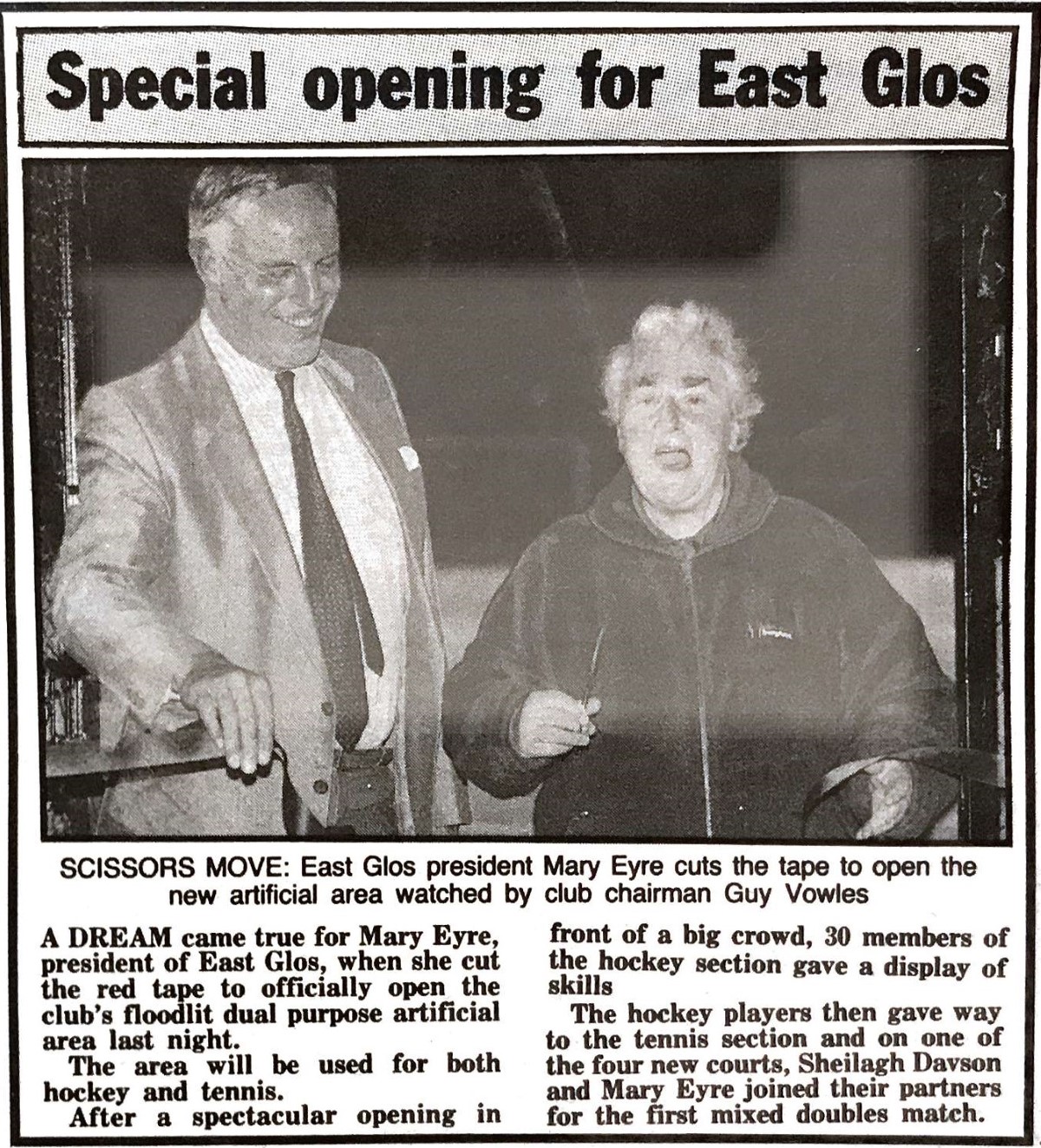
1993. Opening of the new astroturf courts, 14 to 17. Guy Vowles and Mary Eyre. Click for larger version.
A uniform subscription renewal date of 1st January is agreed upon. Previously the various sections of the club had different seasonal renewal dates.
A proposal is put to the AGM to make the whole club a non-smoking area. This is carried by a narrow margin of 36 to 31.
A special general meeting (SGM) is held in July, the key purpose being to vote on the development plans. The executive wishes for all the proposals to be voted on as one entity; however, after lengthy discussions, amendments are made, splitting the broader plan into separate elements. Yet more amendments are then made to at least one of those proposals.
Agreement is reached to resurface what are now courts 14 to 17 as astroturf and install floodlights at a cost of £72,000. This will enable dual use by the tennis and hockey sections. It is also agreed to resurface Tennis Quick courts 8 to 11 at a cost of £25,000, with the surface to be decided by the executive at the appropriate time. £20,000 will be spent on a new insulated roof over the squash courts, with insulation also for the main walls. Court 4 will be converted to glass-backed.
A more contentious proposal is to lease the grass area behind courts 5 to 10 to the Chelsea Building Society, whose headquarters at the time was on Thirlestaine Road. A new entrance and exit would be created on Charlton Park Drive. This would cost £35,000, generate an income for the club, and become a capital asset in ten years. The proposal is defeated by 24 to 91 votes. The key objections are that the rental is not high enough, the car park would be an eye sore, and concern is expressed about associated membership being offered to Chelsea employees. It is, however, felt that a new entrance would improve safety.
The smoking ban, which came into being at the March AGM, creates bad feelings among the smoking members. At the SGM, a proposal is made to the members for smoking to be permitted in the main bar after 8pm. The inevitable proposal amendments then follow with variations on the main proposal. The main proposal is defeated but by a narrow margin of 62 for and 69 against. The smoking ban in all indoor areas, therefore, remains in force.
1994
“Club can no longer drift along and needs to become more profit-oriented”, says outgoing club chairman
Guy Vowles steps down as club chairman, and Tony Matthews is voted in at the AGM. Several rule change proposals take place at the AGM. One of these is for junior members under 18 not to be able to vote at AGMs and EGMs. A member asks why 200 juniors will be deprived of a vote. The chairman says he has never seen anyone under 18 attending an AGM. Even if they did, the executive feels they may not fully understand the policies.
In a heartfelt address to the AGM, outgoing chair Guy Vowles reflects on the ethos of East Glos as a members’ club and how it has changed in the past ten years with a shift from volunteers to paid staff. He feels East Glos cannot just continue to drift along; it has to become more profit-oriented. This doesn’t mean higher prices and higher subscriptions, just making more of what we’ve got. He believes that if the club is to continue into the next millennium, the constitution will have to change. The club needs considerable extra finance, either from greatly enhanced profit achieved by greater utilisation of existing assets or increased capital injection.
Liz Thompson is granted honorary membership in respect of her service to the club over the years, including organising many tournaments.
Extra depreciation on the courts is instigated. Historically when the courts were all grass, depreciation was not permitted.
1995
Executive committee ponders full relocation of club following developer approach
In April, a letter is received from an agent of Crest Nicholson, a construction company, asking if the club would sell the grass hockey pitch. After discussion, it is agreed to reply saying the club is not willing to sell only the hockey pitch but to ask them what they would pay for the whole site and relocation of the entire club.
The matter rears its head again in August, and the executive committee deliberates the spectre of selling all the land and moving the club. There is a variety of views, some feeling the chance to move the club’s site would enable it to develop in a coordinated fashion. “It is encouraging people are attached to this place,” says one committee member, “but there may be an equally lovely location somewhere else in Cheltenham”. A vote is taken that no further negotiations take place, carried 5 for and 2 against.
The conversion of four grass courts in 1993 proves so popular that four more Tennis Quick courts (8 to 11) are converted to astroturf.
1996
Proposal to have paid organiser for social tennis is heavily defeated
The club mourns the death of longstanding club member George Marshall a significant contributor to club life over many years.
At the AGM, the treasurer, Mike Marsland, forecasts a surplus of £4,000 and £39,000 in the sinking fund. By the year 2000, he predicts the club will have cleared all its loans and have funds in the bank. Sue Edwards is voted in as club chair, and Margaret Pedrette becomes a trustee.
A proposal is discussed for a paid organiser for Thursday evening social tennis, at the rate of £20 per evening. The proposer, Martin Garside, comments that very few members are volunteering to help, and it is a shambles. There are various comments from the floor. Heather Birt feels it is a slippery slope. It is a members’ club, and if every social event has to have a paid organiser, it will be a very detrimental step. Two counter proposals then follow, and the motion ends up the same but at £15 per night. It is defeated 9 for and 39 against.
A discussion takes place on how new members are ratified. It is agreed that the office will continue to process new members but that a list of names will be read out at executive meetings, with the committee having the right to veto. It is emphasised that a veto is a rare occurrence.
1997
Proposal to increase size of executive committee to 17 members is heavily defeated
At the AGM, tribute is paid to Brigadier Percival. He was one of the club’s oldest and most loyal members. He was chairman from 1961-65 and president from 1966-71. Those present stand for a minute’s silence.
A proposal is put to the meeting which would increase the size of the executive committee from 13 to 17. The proposer feels there should be an additional representative from each sports sub-committee. The motion is defeated 6 for and 46 against. Another proposal involves installing a pool table in the main bar area. It is defeated 14 for and 39 against.
A presentation is made to Mary Eyre, reflecting her 60 years of club membership. A new pegboard system is introduced for social tennis, replacing the blackboard system.
Long before the days when everyone had a mobile phone, some members complain about the cost of using the club’s payphone. A central heating pipe is punctured by a stray dart from two junior members who are playing. It is decided the risk of a recurrence is high, and the dartboard is locked away.
1998
Gym, sauna and second-storey extension mooted in ambitious development proposals
The development committee presents its outline proposals and seeks authority for plans to be drawn up. There are three phases:
- A new entrance, integrated and extended bar.
- Second-storey extension, summer balcony and upstairs office.
- Fitness centre with gym and sauna.
The members are broadly supportive, although there is some concern about where the money will come from. The proposal is passed with 96 in favour.
In an early example of a focus on first aid, an ice pack is to be stored in the freezer for those who have sustained injuries on court. The ice will be stored in a red bag, and the staff instructed that this ice is only to be used for first aid.
Sunday social tennis starts. A small group of players start using the two courts that had been set aside for social play but never used. Within a few years, the popularity of the session takes off, with more courts being allocated.
1999
Financials bounce back with two record years
At the AGM, Treasurer Mike Marsland reports that 1998 and 1999 were record years financially. Income is up by £14,000, and net current assets have increased to £40,000.
Alec Cornish-Trestrail presents the updated development plans. These include a new entrance, a new reception area, a lounge extension and a partly-covered external balcony allowing fantastic views of the tennis courts. A loan of £40,000 could come from the LTA and £50,000 from club funds. The balance could be made up by increased subscriptions, short-term loans from members and “other novel ways of raising money”.
Notable deaths this year include former club coach and secretary Pam Bocquet and former squash coach Major Ted Millman, just short of his ninetieth birthday.
2000
Outgoing club chair congratulated for reducing duration of executive committee meetings
At the AGM, president Mary Eyre thanks outgoing chair Sue Edwards for her work over the past four years. She congratulates Sue on one “famous victory” in cutting the time of executive committee meetings to two hours. Helen Yates is presented with a gift as she leaves her administrative role after 14 years.
In his address, outgoing treasurer Mike Marsland questions an air of negativity because the club is thriving. Tennis membership is at an all-time high; the finances have never been stronger; the facilities are constantly being upgraded – in the last ten years, £200,000 has been spent on improving the facilities. He also urges caution about future developments, saying that as much money as possible should be raised beforehand as commercial borrowing is a recipe for disaster.
There are two nominations for club chair: Ian Reid and Darryl Wheeler. Darryl wins the vote by 92 to 30.
The club enters the digital revolution by creating its first-ever website, built by club members Julian Wellings and Doug Cartwright.
2001 to 2010
2001
Largest ever development in club’s history approved at AGM
The AGM approves the redevelopment proposals, the biggest in the club’s history. These include a new road entrance, new meeting room, office and reception area; refurbishing the lounge area and creating a single bar; converting the shale courts to clay; creating a Kidzone; and two new astroturf courts (courts 12 and 13).
Also at the AGM, a simplified and more attractive membership structure is approved. There will no longer be separate memberships for tennis and squash; instead, those wishing to play a second sport will pay a small premium. Junior tennis and squash memberships will be combined.
A proposal to abolish what is seen as the outdated system of country membership, where those living 15 or more miles away enjoy a 30% discount, is defeated by 13 for and 56 against.
With more members now using email, a weekly email newsletter entitled “East Glos E-News” is launched, edited by Julian Wellings. It starts with an initial 30 subscribers.
Steve Worsley joins the tennis coaching team as junior activity coach.
2002
Redevelopment work starts
The club is accredited as an LTA performance tennis centre, one of fewer than 100 in the country.
Work starts on the club’s largest ever redevelopment project, which completes in 2003. See photos of the transition.
2003
£500,000 redevelopment completed
A grand opening weekend takes place to celebrate the completion of the club’s £500,000 redevelopment. This includes a clubhouse extension and refurbishment and two additional astroturf courts. Squash legend Jonah Barrington performs the opening ceremony. Despite significant expenditure this year, a surplus of £50,000 is projected.
• Please excuse the quality of the video below. It was copied from a old VHS tape.
Simon Corbishley joins as head development tennis coach.
The exciting prospect of an online court booking system is investigated for the first time. However, it will be a further four years before a suitable system is found. New membership categories are introduced to attract younger members. Those aged 19-21 and 22-25 will now pay 50% and 75% of the full subscription rate.
The shale courts (current 28 to 31) are replaced with clay. The courts are laid in-house using clay imported from France. Unfortunately the clay does not bed in properly which creates an unpredictable surface, particularly in cold weather and rain. In October two of the courts are around “80% playable” and it is hoped to let some smaller children on there.
The year ends with 1370 club members.
2004
Motion for problematic clay courts to be replaced with astroturf is defeated
The new clay courts which replaced the shale surface, continue to cause issues.. They remain useable only by smaller children with no adult play for the rest of the year.
The club holds its first-ever closed racketlon tournament, organised by Ed Johnson – a combination of tennis, squash, table tennis and badminton.
Darryl Wheeler stands down as club chair after four years due to taking up a new job with the LTA. An article is inserted in E-News, appealing for a replacement. At the AGM, Ron Barney takes up the challenge. The club rules are amended to enable East Glos to be eligible for Community Amateur Sports Club (CASC) status. A motion for the troublesome clay courts to be replaced with astroturf is defeated.
Junior squash member Chris Tasker-Grindley becomes England U17 number one. The first MacMillan World’s Biggest Coffee Morning takes place with £399 raised.
2005
Major change to club’s coaching operation
A major change to the club’s coaching operation takes place. The club will now be responsible for the coaching programmes offered at the club and satellite venues. Before this, the coaching operation was outsourced to the Lorraine Ristic School of Tennis. Lorraine leaves the club after sixteen years of excellent service to take up a position at Painswick Tennis Club. Simon Corbishley becomes the club’s first tennis manager.
Di Pierce, who has been club secretary for over eleven years, is promoted to club manager to take account of the growing complexity of the club. Assistant club secretary Val Dickinson is appointed member services manager.
Astroturf courts 14 to 17 are resurfaced. St John’s Ambulance donates a £1,000 defibrillator to the club. Eight members of staff attend a course learning how to use it.
At the August meeting of the executive committee, which ends at 10:25pm, club chair Ron Barney apologises for his part in making the meeting extremely long. “It will not happen again”, he says.
2006
Double National Club League win for tennis teams
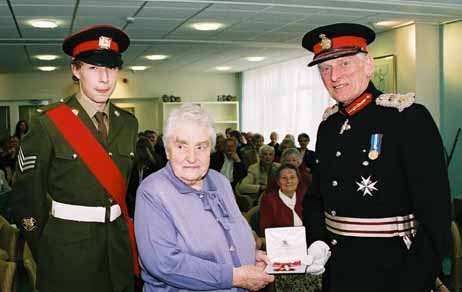
Investiture ceremony for Mary Eyre MBE. Jack Brown, Mary Eyre, Henry Elwes, Lord Lieutenant of Gloucestershire.
In January, club president Mary Eyre is awarded an MBE in the New Year’s Honours List for services to sport. At age 81, Mary decides she wants to avoid facing a long journey up to Buckingham Palace, so the investiture takes place in the more local and familiar setting of East Glos. An audience of over 50 welcomes Henry Elwes, Lord Lieutenant of Gloucestershire, to watch him present Mary Eyre with her MBE.
A decision is taken to outsource the club’s catering operation to put it on a more stable footing. Anne-Marie Willicot is the new provider and receives positive feedback from members.
Tennis member Felicity Thomas wins her first British veterans singles title, winning the Open Indoors Championships in Brierley Hill in her first year in the over 65s. She goes on to win many more singles and doubles titles over the following years.
The date of the AGM moves from November to April to enable an earlier view of the year-end accounts at the meeting.
A planning application for a car park extension made previously by East Glos was rejected by Cheltenham Borough Council. Following an appeal, planning permission is now granted, meaning 15 tarmac spaces can be created. One of the key contacts at the council is a Mr Volley.
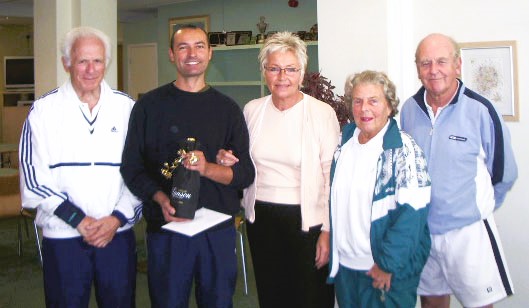
Head Groundsman Stuart Dominey (second left) celebrates 25 years of service. Also pictured: Ron Barney, Di Pierce, Maragaret Pedrette, Ian Flowers
Following the departure of squash coach Rob Shepherd, Jonathan Gallacher joins as his replacement.
Social tennis is renamed to club play. This is to avoid confusion with social (non-playing) membership.
Head Groundsman Stuart Dominey celebrates 25 years of service.
East Glos wins Club of the Year at the Gloucestershire Tennis annual awards.
The club mourns the tragic passing of popular and dedicated club member Ed Johnson, 33, who dies in a motorcycle accident. In his time as a member, he contributed a great deal to the squash section and launched the club’s first-ever racketlon event.
A group of members call an Extraordinary General Meeting. This is due to unhappiness with the executive committee’s wish to cancel the early payment discount for subscriptions and replace it with a 5% late payment surcharge and an 8% increase in subscriptions. There is also concern about a proposed increase in court booking fees. The EGM takes place in December. The motions to withdraw the abolition of the early payment discount and to cancel court booking increases are defeated. A third motion to require subscription increases up to 5% to be notified to members by the end of November is carried.
“East Glos Aces are Best in Britain” reports The Gloucestershire Echo in September. The East Glos men’s and ladies’ teams are crowned Kia National Club League champions and take the two £3,000 first prizes. It is the first time in the history of the competition, which started in 1993, that one club has won both titles in the same year.
2007
The day the rains came: Magic tap keeps the club open
With more members now owning mobile phones, a plea is made for consideration to other members. Members are asked to go to a quiet area to answer their phones. They’re also asked to be mindful of members on adjacent courts who might be distracted by the ringtone and conversation.
The club loses an appeal regarding its wish to fell the large Thuja trees which are causing damage to the courts.
In an update to members following the December EGM, Club chair Ron Barney asserts that the executive committee has been, and will continue to be, prudent with the club’s funds. He adds there has to be sufficient income with which to be prudent and that the committee believe we do not have that sufficiency, hence the increased cost of membership.
Wireless internet (known these days as wi-fi) comes to the club. The cost is £2 per session, and the password will be released on receipt of payment.
The topic of the sale of land arises once more. The trustees give the executive committee permission to look at the option of doing this if it is for the long-term benefit of the club, financially and otherwise. Club chair Ron Barney says, “I doubt if the trustees will give final approval without seeing a lot of enthusiasm from a large majority of the members.”
Steve Evans, who has been a club member for five years, joins the coaching team.
The inaugural Gloucestershire Junior Open Squash Championships are held at the club in May. The event attracts 180 juniors in five different age groups.
At the AGM, a proposal to abolish country membership is carried. This scheme allowed those living a certain distance from the club to enjoy a reduced subscription. A proposal to introduce a weekday daytime category for tennis membership is defeated.
On 20th July 2007, two months’ worth of rain falls across the county in just 14 hours. 350,000 people are left without water for 18 days. East Glos avoids closure thanks to the so-called magic tap. There is only a trickle from a single tap in the kitchen and no water in the toilets, bar or showers. County Week is called off, and the players go home. Over the following 18 days, the magic tap in the kitchen continues to deliver a trickle of water. This means a single toilet can be kept operational by constantly being topped up, and the club does not need to close.
Tony Jordan becomes acting club chair following the resignation of Ron Barney.
East Glos Club once again completes the double in the finals of the National Club League in Bournemouth, capturing both the men’s and ladies’ titles at the West Hants Club.
2008
Social tennis becomes problematic; clay courts to be resurfaced
In February, it is realised that the clay courts are not playable other than in the summer, and the club accepts it is not an all-year-round surface. Over the last three years, the club has liaised with the LTA. At one point, it was thought that they had accepted some responsibility for the poor surface that was laid and were going to financially support changing to an all-weather performance surface. It is unlikely any financial support will be possible. At the AGM in May, a resolution to convert the courts to an all-weather surface is carried.
In May, the executive committee reports on progress made by the development sub-committee, which was formed to look at options for selling land. This is in an attempt to move the club from being asset-rich but cash poor. A planning application is expected to be turned down, and an appeal could cost up to £100,000. An alternative option will now be pursued, looking at development partners willing to risk the funds to obtain planning permission.
Problems continue with social tennis, with members who consider themselves better players unhappy to play with those they deem to be of a lesser standard. Sometimes this leads to “fixing” of the pegboard selection process. A sub-committee is formed to look at ways of making social tennis more inclusive and enjoyable for all. A ratings system is introduced in an attempt to grade players to achieve balanced fours. However, it is short-lived due to flaws in the assessment process which is unsuited to recreational players.
After several months of the club having no treasurer, Richard Fraser comes forward and is co-opted onto the executive committee. Following Tony Jordan’s 16-month tenure as acting chair, Stuart Knee agrees to take on the role on a co-opted basis.
2009
New hard courts; online booking is launched
In an update to members, new club chair Stuart Knee comments on the wonderfully democratic nature of the club. He says, “A club for members, run by members, for the benefit of members, is wonderfully democratic, and if the East Glos falls short of our expectations in any way, then we have only ourselves to blame”. Despite the dire economic conditions caused by the 2008 banking crisis, the club’s current financial position is strong, with a healthy surplus forecast for the year just ended.
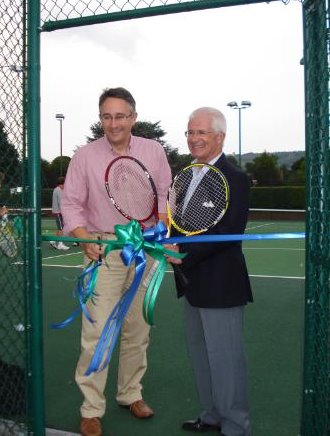
Opening of the new hard courts. Martin Horwood (Cheltenham MP), Stuart Knee (club chair).
The club benefits from an influx of new members due to the demise of the De La Bere Tennis Club. It was situated at the hotel of the same name in Southam (now Ellenborough Park).
Tiered seating is installed in the squash area to improve the experience for spectators. Sophie Lane joins as squash coach for the bronze, silver, gold and elite squads.
Honorary membership is granted to Margaret Pedrette in recognition of her lengthy and selfless contribution to the club.
Four new all-weather, floodlit hard courts (28 to 31) are opened, following major issues with the clay courts over the previous three years. An opening ceremony takes place in June, with Cheltenham MP Martin Horwood doing the honours.
The club mourns the passing of former club treasurer Mike Marsland.
40 people attend a social tennis forum. There is a general consensus that social tennis needs fixing but with less agreement about what needs to be done. A problem exists in arranging well-balanced fours, resulting in abuse of the peg system caused by people trying to avoid games with others. The most popular idea is that there should be an organiser and as such, organised play commences on Thursday nights later in the year.
The club joins the social media revolution with the launch of the club’s Facebook page and the creation of a Twitter account.
Online court booking is launched. The old paper-based system is discontinued.
2010
125th anniversary is celebrated; a bridge too far
An approach is made by Cheltenham Bridge Club regarding taking a 99-year lease on some of the club’s land to build new premises. After friendly discussions, the executive committee decides the proposal is not in the long-term best interests of the club, now or in the foreseeable future. To substantially change the ethos of East Glos and build a bridge club suitable for 400 members with the attendant parking issues, loss of tennis courts, and restriction on our own possible future building plans is felt incompatible with the majority wishes of our own members.
Floodlight charges are reduced to £4 per hour, having been increased to £6 in 2009 due to a 41% increase in electricity costs. A new supplier contract has been secured to enable the reduction.
Sophie Lane is appointed club squash coach, and Mark Lunn joins as head tennis coach. A new catering provider, Ginger Jam, begins operations at the club.
In June, a major event takes place celebrating the club’s 125th anniversary.
At the AGM in May, the position of club chair remained vacant. Gary Toyne comes forward and is co-opted to the position.
Tennis manager Simon Corbishley wins the Gloucestershire LTA Coach of the Year Award.
Club manager Di Pierce retires after 17 years of service, initially as club secretary. Simon Harmer joins us as club manager from the Bourne Club.
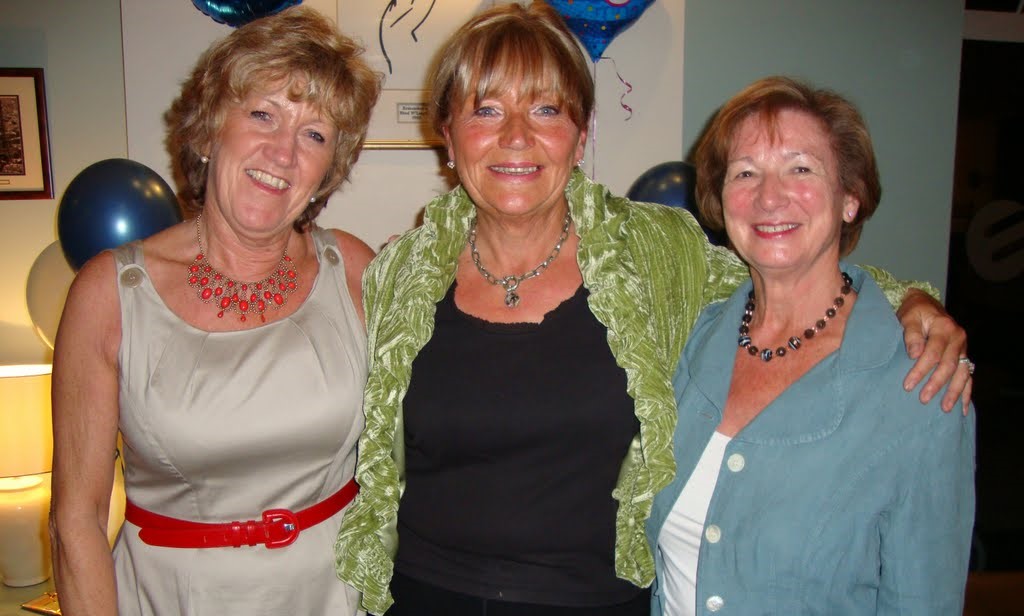
Retiring club manager Di Pierce (centre) with Val Dickinson (left) and former staff member Helen Yates (right).
2011 to 2020
2011
Funding approved to assess feasibility of indoor courts
Club member Nathan Lake wins the European Junior U19 Squash Championships in Switzerland. Later in the year, he turns professional.
A special general meeting takes place in November, with 177 members attending. Its purpose is to seek members’ approval to spend up to £25,000 investigating the feasibility of building indoor tennis courts and submitting a suitable planning application. The proposal is carried.
Grass courts 23 to 27 undergo levelling and renovation.
2012
Club hosts prestigious seniors tournament
Club tennis coach Steve Evans is picked for the England O55s veterans team for this year’s Four Nations tournament.
Shelagh Davson is presented with a lifetime award by the Gloucestershire Hockey Association in recognition of her 60-year involvement in hockey at East Glos and the wider county. At the age of 86, Shelagh continues to be heavily involved in running the junior section at East Glos.
Former East Glos member Ashleigh Ball is among the 16-strong GB Olympic hockey squad for London 2012. She was a club member for seven years until she was 16, before moving to Clifton Hockey Club.
At the AGM, a proposal to change the subscription renewal date from January to April is carried. This takes effect in 2013.
In June, Henry Marshall is co-opted as club chair following Gary Toyne’s resignation due to ill health.
Steve Worsley rejoins East Glos as head of performance support, a joint appointment with Oxstalls Tennis Centre.
East Glos is chosen to host the prestigious super seniors section of the Vets GB Tournament. The club is invited to host this prestigious event because Wimbledon is being used for the Olympics. Former Wimbledon referee Alan Mills runs the event.
E-News, the club’s weekly email newsletter, reaches 1,000 subscribers. Hard courts 5 to 7 are resurfaced as artificial clay.
The club mourns the passing of Sue Edwards, club chair, from 1996 to 1999. Ann McHattie and Lizzie Still assume responsibility for club catering.
2013
Club mourns passing of Mary Eyre MBE; Murray mania hits East Glos
Mary Eyre steps down as club president, a position she has held since 1992. Margaret Pedrette, a 50-year club member, takes over the role.
Andy Murray becomes the first British man since Fred Perry in 1936 to win the Wimbledon singles title. BBC Points West Gloucestershire reporter Steve Knibbs gauges reactions from club members.
In July, mass resignations hit the tennis committee as the chairman, and three other members decide to leave. Four members come forward to fill the void including former club manager Di Pierce as committee chair and Graeme Adams, Chris Nelson and Jane Tooley.
The club holds its first-ever racketball closed tournament. Racketball is now the country’s fastest-growing sport, which is reflected in the level of entries received.
The club mourns the passing of Mary Eyre, MBE, on 8th November. She was a member of East Glos for 76 years. Playing hockey and tennis, she served as ladies’ tennis captain, tennis committee chair, club chair, trustee, and until May 2013, club president. Totally dedicated to any roles she undertook, Mary became a leading international hockey umpire. She put her playing experiences into these duties in a total of 28 internationals, ten of which were played at Wembley Stadium.
She was a formidable goal scorer and was selected to play for England during the 1946-1949 seasons. Mary also umpired at Wimbledon for fifteen years and reached the quarter-finals in the ladies’ doubles. She coached generations of children in schools and continued to strongly support junior hockey, encouraging many schoolgirls into the game.
2014
Two EGMs called and then cancelled; clubhouse refurbished

Members enjoy the refurbished clubhouse.
The astroturf courts, 8 to 13, which date back to 1995, undergo rejuvenation. This involves extracting the current infill, brushing the carpet to lift the pile and redressing the courts with fresh, uncontaminated sand.
The clubhouse undergoes refurbishment, its first since the current building was opened in 2003. The project includes new carpets, bigger coffee tables, sofas and a new made-to-measure sports bag rack.
Sports consultancy presents £5.75m club development opportunity
In March, a presentation to members on the future strategy of East Glos takes place. Sports consultancy Knight Kavanagh & Page was engaged in 2013 to undertake an independent study of the potential for East Glos to develop its facilities, taking into account the initial support from members to investigate the construction of indoor tennis courts.
The executive committee believes the club has a significant opportunity to establish East Glos as the premier tennis, squash and fitness club in Cheltenham. Adding indoor tennis courts to the existing facilities would not be sensible, i.e. the club also needs to build a gym, fitness, soft play and junior facilities.
The executive proposes that the development can be funded by selling land and obtaining funding from the LTA, 50% as a grant and 50% as an interest-free loan. The section of land most valuable for residential development would be that fronting onto Old Bath Road. If planning permission can be obtained, a new clubhouse would be built on land adjoining Charlton Park Drive. The project also includes four new indoor tennis courts, retention of the 17 existing all-weather courts and at least four grass courts. A gym and fitness centre are also proposed. The estimated cost is £5,750,000.
A sum of £60,000 is provisioned for a planning application; however, subsequent estimates from architects increase this figure to £100,000. There is, of course, no guarantee of a successful outcome, so the executive considers that an expenditure of £100k would constitute an unacceptable financial risk to the club’s resources.
Later in the year, the executive committee decides not to move to the next stage of the major plan (detailed above). Having spent approximately £15,000 and carried out a great deal of work, they conclude that it is not possible to build indoor courts on a stand-alone basis. A new mandate will be required from members to take forward strategic plans.
Following the calling of two separate EGMs comprising proposals for rule changes (one called by a group of members, the other by the executive committee) both EGMs are cancelled and the proposals are debated at the AGM at the end of May. A record 177 members attend, and the meeting is held at Sacred Hearts Church Hall due to the high numbers. A key outcome is that members will now be able to request a postal vote for proposals at AGMs and EGMs.
Club member and pro squash player Tom Ford organises a pro-am squash doubles tournament, the first to be held since the event fell by the wayside several years ago.
In June, Lizzie Still ends her stint as the club’s catering provider. The operation is brought in-house with Sue Vincent in charge.
Club manager Simon Harmer leaves the club in July to take up a new position at the Cumberland Club in London. In October, Darren Morris joins as club manager from Oxstalls Sports Park.
A marketing sub-committee is formed. The first cohesive marketing plan in the club’s history is implemented with the key aim of raising awareness of the East Glos brand and attracting new members.
An ornate circular bench, designed by Gerry Dominey, is unveiled in memory of Mary Eyre, MBE, who died in November 2013.
The club mourns the passing of Roger Martin. He was club chairman between 1977 and 1980 and president in 1981 and 1982.
Following the cancellation of the major strategic development project, the executive committee launches a survey with 380 people taking part. The key priority from members is that astroturf courts 8 to 12 be resurfaced. Most club members would still like indoor courts; however, it is evident that most members are against the concept of a major redevelopment of the club’s site. The executive committee says whilst it remains firmly against burdening the club with very significant debts, it will continue to research any ways in which it might be able to deliver covered courts within these constraints.
For the first time, card payments are accepted at the bar for purchases of £5 or more.
Club member Helen Taylor takes a balloon flight and manages to snap a stunning aerial image of the East Glos grounds.
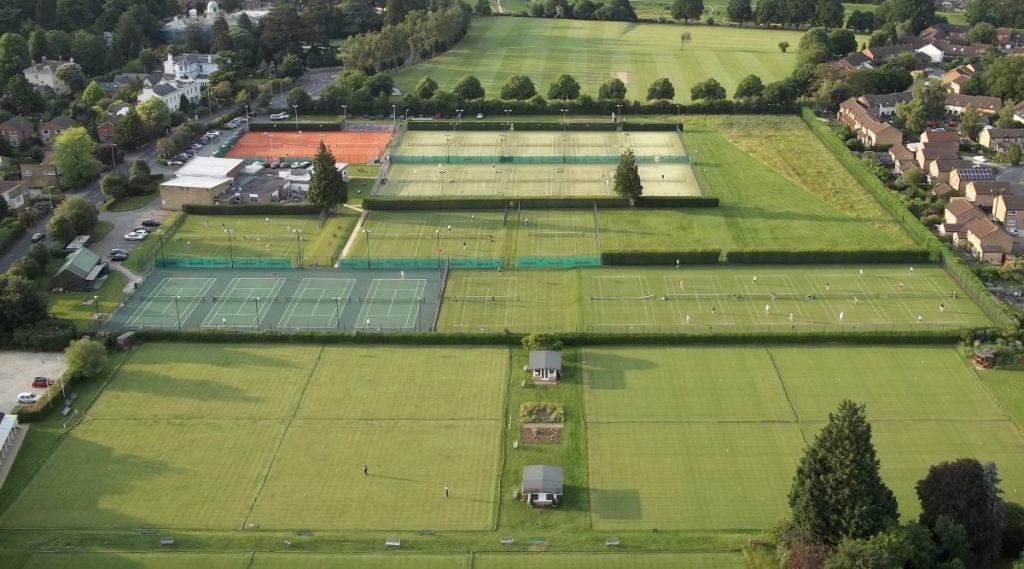
At the Seniors British Grass Court Championships, Felicity Thomas wins the Over 70’s Doubles title, partnered by Ruth Weston of Surrey. Ron Barney, with his partner Syl Pearson from Barton Club in Edinburgh, won the 85 Men’s Doubles.
In September, the club organises an 8 to 80 hockey club day in memory of Mary Eyre, MBE, who died in 2013. Former club member and Olympic 2012 bronze medallist attends and signs hockey sticks for the younger players.
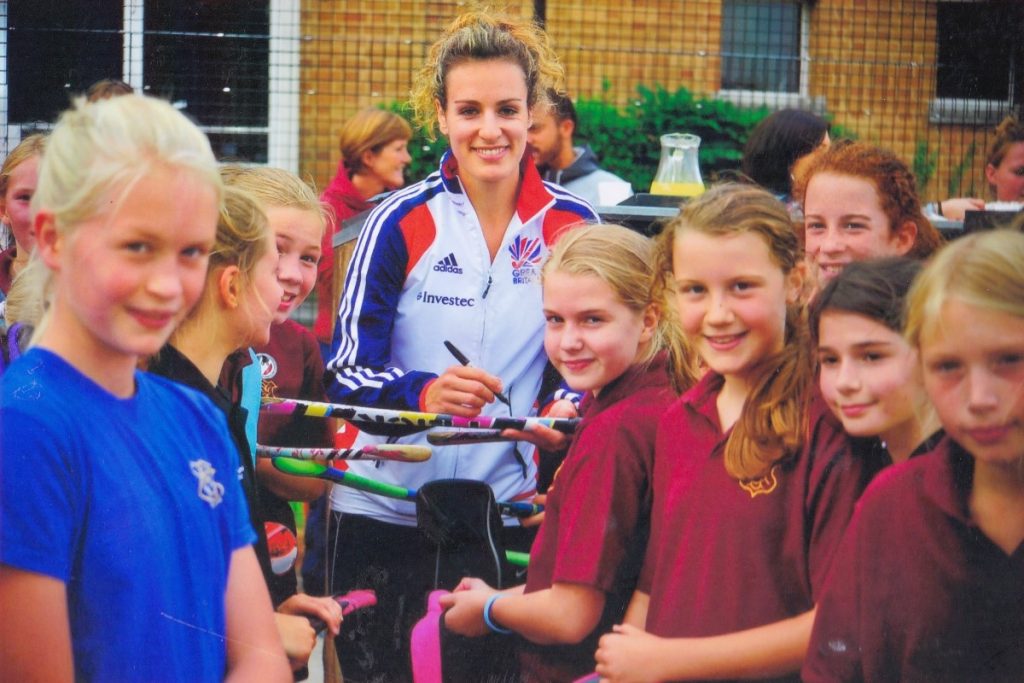
After ten years at East Glos, tennis manager Simon Corbishley leaves for a position at Pershore Tennis Club. Steve Worsley is appointed to the role.
The club mourns the passing of Len Horder. He was involved in a lot of the major development and maintenance of the club grounds over many years. As well as co-founding a successful building business, Len played more than 300 games for Cheltenham Town FC in the 1940s and 50s.
2015
Proposal to incorporate East Glos fails at first attempt; accolades at local tennis awards
The club welcomes its first-ever tennis apprentice. Josh Day starts a tennis apprenticeship thanks to LTA and government funding support.
An EGM takes place in February, called by the executive committee. The key outcome is agreement to resurface courts 8 to 11 with artificial clay and new lights on courts 8 to 12, up to a budget of £180,000. Another resolution is to abolish the frozen subscription rate enjoyed by members when they reach 70 years of age. There is concern that with an ageing membership, this will not be sustainable in future. The proposal is carried.
A third resolution is to introduce a fee of £50 in addition to subscription fees to act as pre-payment for use in the bar and cafe to increase footfall in those areas. Although there are 114 votes in favour and 88 against, the required two-thirds majority is not achieved.
A resolution to incorporate the club as a limited company is defeated at the AGM. A simple majority of 88 to 72 is achieved but not the required two-thirds majority. Club chair Henry Marshall draws attention to various misleading comments, leaflets and emails that have been sent around, alleging that the executive committee has been trying to slip this past members unnoticed. He asserts that this is definitely not the case and that the timing is entirely HMRC driven.
The rationale behind incorporation is that instead of the club being an unincorporated association with unlimited liability for each member, it would become a company owned by the members with the legal liability limited by guarantee to a maximum of £10. This would ensure that the legal liability of all members would be strictly limited. The executive committee continues to believe that it is in the club’s best interests to protect all members by incorporation but does not want to proceed unless it has the backing of at least two-thirds of the members. A period of consultation with the members now takes place.
500 people attend the club’s annual open day, with a record 60 new members joining.
The new artificial clay tennis courts (8 to 11) open in July. The courts are officially opened by Cheltenham MP Alex Chalk in September.
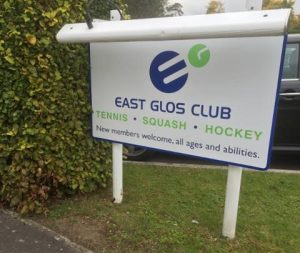
The new club signage.
As part of the improved marketing of the club, new signs are installed around the club.
The club mourns the passing of Liz Thomson at the age of 93. A former employee of Bletchley Park and GCHQ, she was given honorary membership of East Glos for her contribution to tennis, having been a member since the 1960s.
Former world number five Fiona Geaves joins the squash coaching team.
A reassuring email is sent to members by the club’s trustees, giving their backing to the proposed incorporation of the club.
East Glos scoops four accolades at the Gloucestershire British Tennis Awards: Club of the Year, Coach of the Year (Steve Worsley), Outstanding Achievement Award (Margaret Pedrette) and Mary Eyre Award, Junior Boy Player of the Year (Aaron Osmond).
2016
Proposal to incorporate East Glos successful at second attempt
An EGM takes place in April to progress the incorporation of the club. Previous concerns from the 2015 AGM regarding the proposal’s wording have now been addressed, and members have been reassured by attending consultation sessions. The motion is carried 102 to 9. The incorporation is completed in July with the formation of East Gloucestershire Club Limited. The coaching operations are transferred to a new wholly-owned subsidiary, East Glos Club Coaching Limited. This transfer is undertaken to comply with HMRC rules regarding the club’s Community Amateur Sports Club (CASC) status.
Members are reassured that East Glos will remain a members’ club owned by the members and run for the benefit of the members. The club’s freehold land will continue to be safeguarded by provisions requiring two-thirds of members to agree to any sale, mortgage or other disposition. The freehold will be vested in East Gloucestershire Club Limited (EGL).
In March, club member Rose D’Sa is selected to represent Wales in the O55s veterans team for the Four Nations tennis tournament for the fifth time. In December, club member Felicity Thomas becomes world number two in the over 75s singles International Tennis Federation (ITF) rankings.
Assistant club manager Val Dickinson retires after 16 years. A large contingent of members and current and former staff attend her farewell get-together at the club.
The East Glos ladies’ Aegon team is promoted to National Division. They finish the season in style with a 12-0 win over Royal Berkshire seconds. This win cements their place at the top of the league and secures promotion to the National Division.
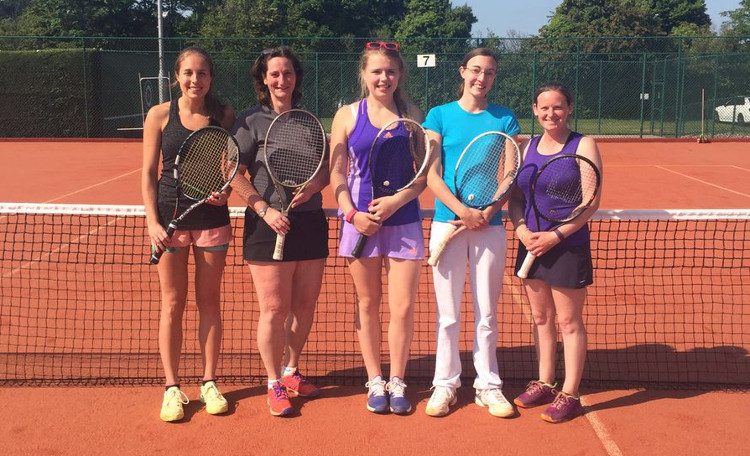
Ladies Aegon team: Kathryn Hole, Nathalie Vioules, Eleanor Findlay, Rachel Phillips, Esther Curtis
Hundreds of members and visitors are fortunate to see the historic Davis Cup Trophy when it comes to East Glos. After Great Britain wrote their name in history to lift the Davis Cup title for the first time in 79 years, the incredible trophy embarks on a memorable journey of its own, visiting over 100 venues across the UK.

Young tennis fans get a chance to see the Davis Cup as it comes to East Glos
The club hosts the prestigious British Closed Seniors Grass Court Championships covering age groups 60 to 85. The tournament is normally held at Wimbledon; however, East Glos is asked to host the event for two years while Wimbledon completes work on putting a roof on number one court.
The club mourns the passing of Mary Glenister at the age of 64. She was an active club member for over 25 years, playing regularly and running many successful junior tournaments, including the county closed and junior open.
In December, club member Felicity Thomas becomes world number two in the over 75s singles International Tennis Federation (ITF) rankings.
At the end of the year, club chair Henry Marshall stands down, having said at the AGM that he wished to serve for a maximum of 12 months until the incorporation process is completed. Club president Malcolm Sainsbury says, “I would like to express my admiration and thanks for the tremendous effort Henry has put into running the club over the last four-and-a-half years.
2017
Resurfacing of courts 12 and 13
At the May AGM, Roy Thorogood, who was co-opted as club chair last December, is elected. John King becomes club treasurer. A resolution to resurface court 12 as artificial clay and court 13 as astroturf is passed, and the courts are completed later in the year. A resolution to remove the option for written votes at general meetings is defeated.
Barbara Hawkins becomes the club’s office manager. She has worked as the club’s bookkeeper for 15 years and has significant knowledge of the club and its operations.
Felicity Thomas achieves the Grand Slam of Great Britain Championships in the over 75s category: Hard, clay and grass. She wins not only all her singles but the three doubles as well. All these are highly graded, two being open to all but Wimbledon being closed to foreign players. As far as we know, no other club member has achieved this.
2018
Personnel changes; development forums take place
As part of its ongoing review of hospitality at the club, the board appoints a hospitality manager. Scott Regan takes up the role. This new role, which will incur minimal extra cost for the club, will bring about improved staff training and a fresh approach to encourage more members to use the bar and catering facilities.
95 members attend two forums. The aim of the forums is to elicit members’ views on the future development of the club.
Mark Toseland takes over as squash manager, replacing Sophie Lane, who held the role for four years. Former world-ranked ATP player Pete Russell joins the coaching team developing performance juniors.
In January, club member Felicity Thomas becomes world number one in the over 75s doubles International Tennis Federation (ITF) rankings.
In December, the club holds two further well-attended development forums. Those attending hear an overview from the board on the exciting ways East Glos could develop in the coming years.
2019
Club board presents revised version of development plan: New sport of padel is proposed
In January, the club conducts a club development survey with 296 members responding. Key findings include:
- 78% would prefer a phased approach than a single large project
- 84% support the relocation of the entrance from Old Bath Road to Charlton Park Drive
- 66% say they would approve large capital expenditure on additional car parking as a first development step
- 61% would support the introduction of a new sports section at the club, such as padel tennis or pickleball.
A sub-group is formed to move to the next stage.
The club launches its first-ever sponsorship programme. By the end of the year, uptake is excellent, with many local businesses involved.
East Glos junior Harry Bloomfield achieves his first England cap. He is selected to represent Team England at the Five Nations tournament. Later in the year, he achieves a number-one ranking in the England U13s. Previously he was number 1 in the U11s.
The club receives an excellent 8 out of 10 rating for its grass courts as part of an annual assessment by STRI, the world’s leading sports turf consultancy. As a comparison, Wimbledon’s courts are rated 10 out of 10.
East Glos coach Steve Evans wins first ITF singles title. Appearing in his sixth final, he beats Canadian Mark Girdler 6-0, 5-7, 6-2 in the Over 60s final at the Everyball Seniors Tournament at RAF Halton Tennis Centre in Buckinghamshire.
Hard courts 28 to 31 are resurfaced, having first been laid ten years ago.
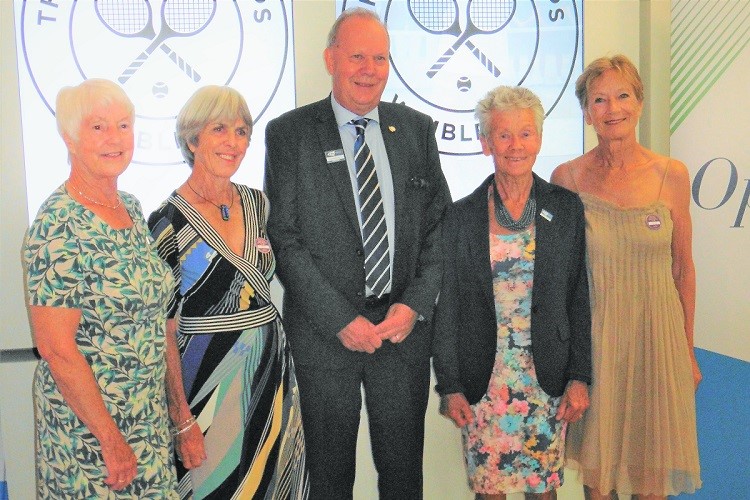
LTA reception in recognition of gold win at Queen’s Cup. Felicity Thomas, Jenny Waggott, David Rawlinson (LTA president), Jackie Boothman and Fran Maclennan.
In June, the LTA announces its intention to invest in a programme of indoor tennis centres across Great Britain. Research commissioned by the LTA has identified 96 priority target areas in England, Scotland and Wales. Cheltenham is one of the areas identified. The club contacts the LTA management team to discuss the phased approach to development at East Glos and the extent of financial assistance that might be available.
In July, club member Felicity Thomas is invited by the LTA to their cocktail party in the Wingfield Room, Centre Court, and is given Centre Court tickets to enjoy some excellent tennis beforehand. Together with her GB teammates, this acknowledges their achievement in winning gold in the Queen’s Cup at last year’s World Championships in Umag, Croatia.
The club tennis championships experience a resurgence with 433 entries. At the finals in September, attendances peak on the Sunday afternoon, with over 100 members, friends and families spectating.
A hugely successful Macmillan World’s Biggest Coffee Morning takes place with over £2,800 raised.
In October, club chair Roy Thorogood resigns. Having put together a template for the club’s long-term development with the pre-2019 board, the current board members now favour a revised plan. Club president Malcolm Sainsbury thanks him for working diligently on behalf of the membership and for his tremendous contribution to the running of the club over the past several years, first as treasurer and latterly as chair. Andrea Butland is co-opted as club chair.
In November, the board issues an update about the club’s future development. The major changes to the car parking and entrances envisaged initially are no longer considered feasible due to the costs involved. The latest proposals do not seriously compromise space for future long-term developments, and the major infrastructure changes as originally envisaged can still be implemented if appropriate at a future date.
The revised proposals are car park improvements; refurbishment of changing and toilet facilities; introducing the new sport of padel, which is predicted to boom in the UK. There is a positive case for installing additional tennis and squash courts, subject to costs and funding. The club also expresses interest to the LTA about their indoor community tennis scheme. This includes funding assistance for providing a covered framed building over existing courts or the erection of a stand-alone building dedicated to indoor courts and a gym.
Read our 2019 annual report.
2020
Club faces major challenges from global pandemic; padel gets the go-ahead
As the year starts, little does the club know it will face some of the biggest challenges in its history.
An EGM is held in January, with 153 attending. Members give the go-ahead for introducing the new sport of padel, car park improvements and upgrades to the changing and toilet facilities.
 On 12th January 2020, the World Health Organization (WHO) confirms that a novel coronavirus is the cause of a respiratory illness in a cluster of people in Wuhan City, China. By the end of January, the virus, now named Covid-19, is confirmed to be spreading in the UK. By March, concern is mounting, and the UK government moves to “delay phase” to limit its spread. At East Glos, this includes early measures such as no longer shaking hands at the end of matches. On 17th March, a decision is taken to cancel all coaching courses until 10th April.
On 12th January 2020, the World Health Organization (WHO) confirms that a novel coronavirus is the cause of a respiratory illness in a cluster of people in Wuhan City, China. By the end of January, the virus, now named Covid-19, is confirmed to be spreading in the UK. By March, concern is mounting, and the UK government moves to “delay phase” to limit its spread. At East Glos, this includes early measures such as no longer shaking hands at the end of matches. On 17th March, a decision is taken to cancel all coaching courses until 10th April.
Events begin to move rapidly, and on 23rd March, a legally-enforced Stay at Home Order, or lockdown, is introduced, banning all non-essential travel and contact with other people, and shutting schools, businesses, venues and gathering places. The club has no option but to close for the first time in its 135-year history. At this point, no one knows how long the closure will last or how the pandemic will pan out. The reality is that restrictions in one form or another continue for a further two years.
The timing could not be worse as it coincides with the start of subscription renewals on 1st April. While the club plans to take advantage of the financial help announced by the government and has a strong cash position, this cash buffer will be significantly reduced if many members choose not to renew their membership. The club asks members to renew their subscriptions and announces a system of credits for any period when the clubhouse and playing facilities are unavailable due to restrictions.
All staff apart from the club and office managers are furloughed for at least up to Easter. This allows the club to access the job retention scheme and reclaim 80% of the wage bill. Measures are taken to reduce expenditure by two-thirds however the club expects a loss of £25,000 per month of closure.
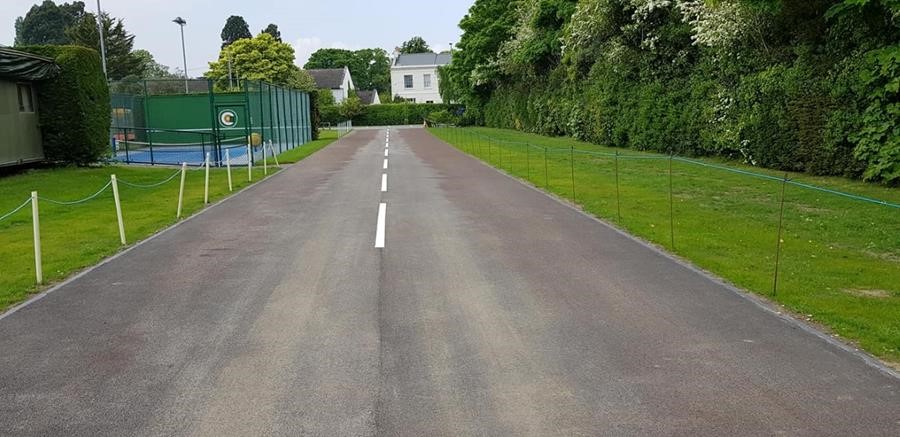
The car park extension
After Easter, members of the grounds staff return to work using appropriate safety and protective measures.
In May, restrictions are eased slightly, with singles play being permitted and doubles between members of the same household.
The club looks different to when it closed in March, with outside portaloos, hand sanitising stations and court gates left open. Members are also asked not to share tennis balls. Another key change is the arrival of squash players on the tennis courts, with most of them taking to it very well.
There is some good news, however. With outdoor construction work still permitted, the car park extension is completed.
In June, doubles play and the sharing of tennis balls are now permitted. In July, the clubhouse partially reopens. A one-way system is implemented, along with protective screens for staff and disposable cups and plates. Squash play is now permitted, albeit with significant restrictions.
During lockdown, a major refurbishment of the squash area is completed. The newly-refurbished toilets and changing rooms are also completed. However, no one is allowed to use them yet due to restrictions.
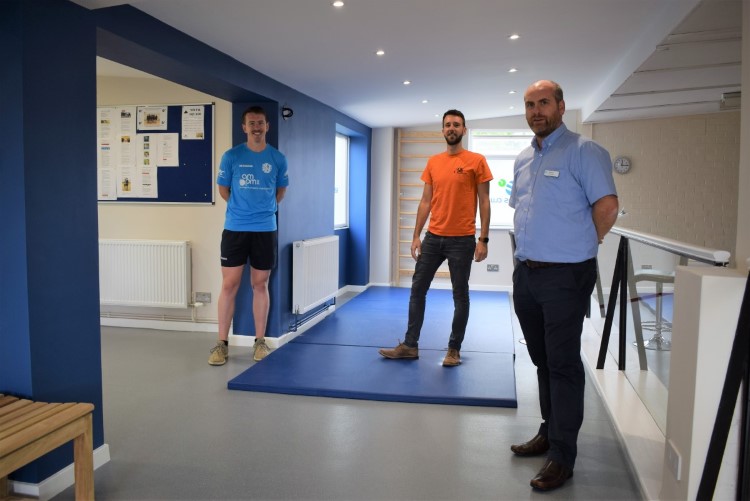
The newly-refurbished squash area. Nathan Lake (squash professional), Dan Heaton (AMPM247), Darren Morris (club manager)
In August, squash restrictions are eased further with the formation of squash bubbles. That allows up to six players to be part of a single bubble.
In September, 75 members attend an outdoor AGM (pictured below). Not only is this the first-ever outdoor East Glos AGM, but it is possibly the quickest ever, with all business completed in under 45 minutes. Members approve expenditure for three new padel courts.
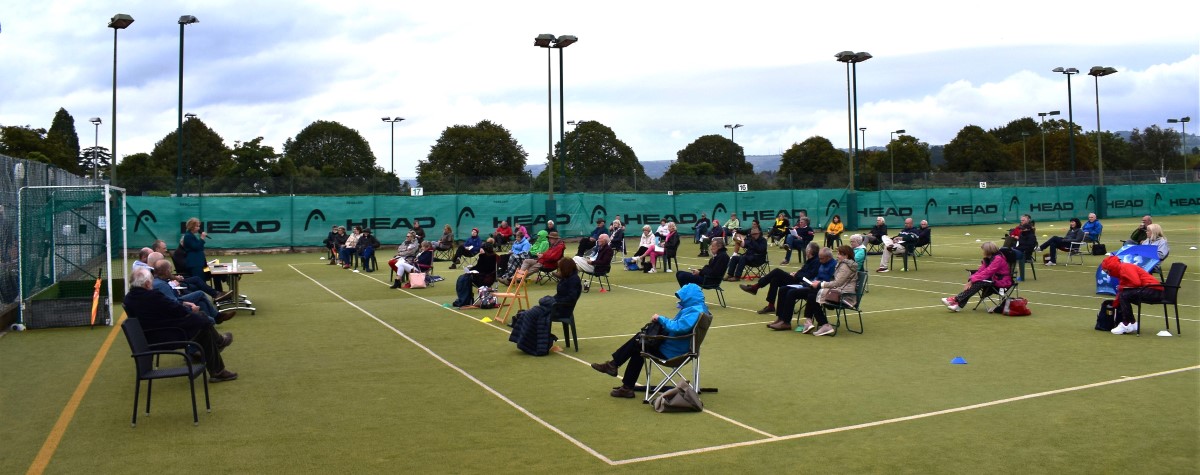
Limited seating is now permitted in the clubhouse but with gatherings of no more than six people. Furniture is spaced out to ensure social distancing.
Despite a difficult year, the club tennis championships go ahead with a record number of over 400 entries. Some of the winners are pictured below, with the requisite social distancing.
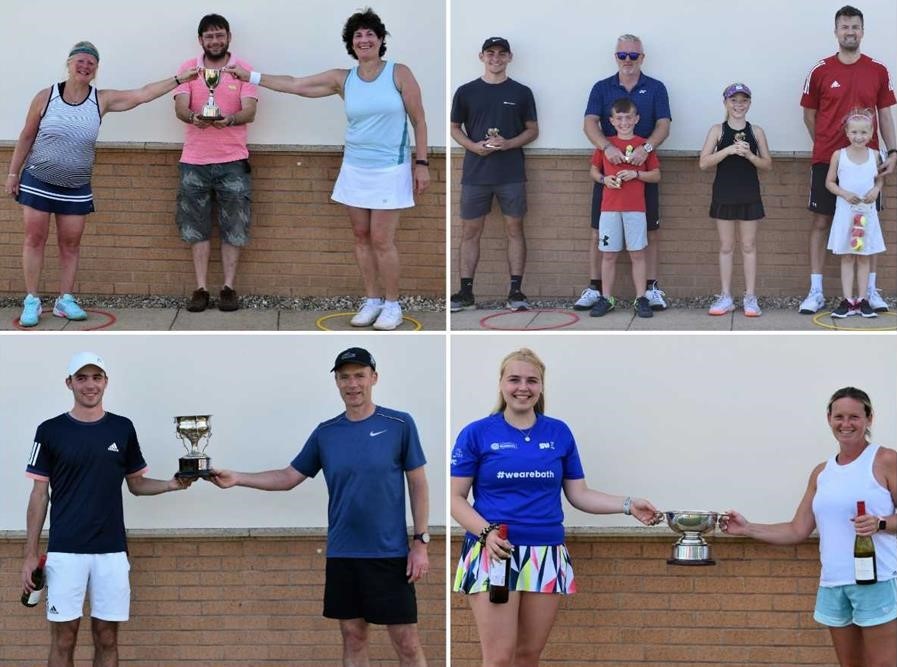
In late September, due to rising coronavirus cases, restrictions return with table service only and wearing face masks mandatory in all inside areas. There is also a new entrance and exit system for squash players, and members are encouraged to download the new NHS Test & Trace app.
After 23 years as a stalwart of the grounds team, Paul Dean leaves his part-time contract at East Glos to continue helping at Shurdington Nurseries, where he had also worked for some years.
On 5th November, East Glos closes for the second time due to another England lockdown. All indoor and outdoor sports centres close, and the lockdown is expected to last four weeks.
Despite the lockdown, construction work is still permitted, and work begins on the club’s three new padel courts. The project is 50% funded by the club, and 50% comes from the LTA’s interest-free quick access loan scheme.
On 2nd December, the club reopens. Tennis is allowed; however, squash can only be played as households or “sides”. Hospitality is allowed to reopen but with outdoor takeaway service only.
For most of 2020, the board meets virtually using Microsoft Teams. The governance and management of a club the size of East Glos, is a complex undertaking at the best of times. However, due to the pandemic, this complexity increases significantly, requiring discussion and decision-making on various challenging matters.

Board members at their final virtual meeting of 2020.
On 31st December, Tier 4 restrictions are announced for Gloucestershire. This means significant restrictions for club members, including no squash and singles tennis only. A four-tier system was introduced in England in the autumn (where 4 is the highest), with different regions in different tiers depending on Covid-19 case rates. By December, much of England is in Tier 4, including London.
Read our 2020 annual report.
2021 to 2023
2021
Pandemic challenges continue; new padel courts opened; new single rackets subscription
2021 sees the club continue to deal with the disruption and financial challenges brought about by the Covid-19 pandemic. Thanks to prudent financial management in the past and the generosity of members, the club weathers the storm while completing its major project of the year, the building of three new padel courts.
The relative freedoms of Tier 4, introduced on 31st December, are short-lived. Just days later, on 5th January, England goes into another full lockdown meaning the club is closed for the third time in ten months. The club’s losses reach £30,000 per month.
The board projects that if the current lockdown lasts three months, the total cost of lockdown credits offered to members could rise to around £200,000 by the end of March. The depletion of the club’s cash reserves means that the board now has to balance its duty to be financially prudent and its promise to offer lockdown credits to members for 2020/21.
While the club is not at risk of becoming insolvent, it has to dip into its financial reserves to cover monthly operating costs. The board asks members to consider if they can support the club by waiving some of their credits during the subscription renewal process in March. From April onwards, members start to answer the call. Their generosity ultimately delivers a £50,000 boost to the club’s depleted reserves.
With padel due to be launched in April, the board introduces a new single rackets subscription. This simplifies the membership offering and avoids the need for separate subscriptions for tennis and squash. More importantly, its aim is to bring about a “one club” ethos, with members able to play any of our four racket sports. A reduced rate for members under 30 years old is also brought in.
Head Groundsman Stuart Dominey is presented with a Lifetime Achievement runner-up award at the Gloucestershire Tennis awards. Stuart has worked at East Glos for 40 years, starting in 1981 as an apprentice.
On 29th March, the club reopens for tennis in the latest round of lockdown easing. There is a real buzz about the place as members resume playing for the first time in three months.
In April the three new padel courts open after four months of construction. This is the first new sport to be launched at the club since squash in 1972.
The club mourns the passing of much-loved 40-year club member David Roberts. Club video producer Julian Wellings creates a video tribute to David. Later in the year, court 17, David’s favourite court is renamed The David Roberts Court in his honour.
Further Covid-19 restrictions are lifted, with full squash now permitted. Indoor and outdoor catering is allowed but only in groups of six. The serving of alcohol is permitted only at certain times of day and with table service only. The newly refurbished changing rooms and showers are open for the first time. Only six people are allowed in at once, and only two in the showers.
In June, the AGM is held outside for the second year running. A key resolution is reducing the minimum voting age from 18 to 16, passed by 71 to 12.
BBC Points West Gloucestershire reporter Steve Knibbs comes to East Glos to report on the new padel courts.
In July, a sense of normality returns for the first time in 15 months. As Covid restrictions are fully relaxed on 19th July, members can enjoy the club’s facilities once again. The club commissions a new aerial photograph of the grounds to reflect changes in the courts footprint over recent years.
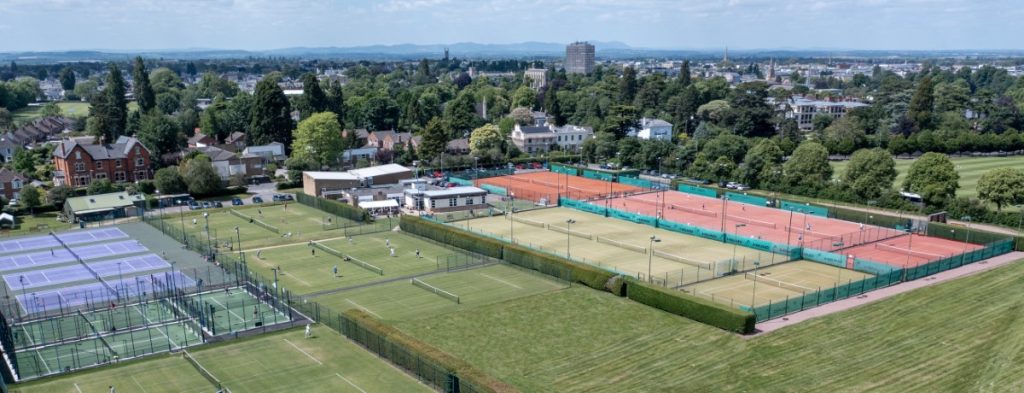
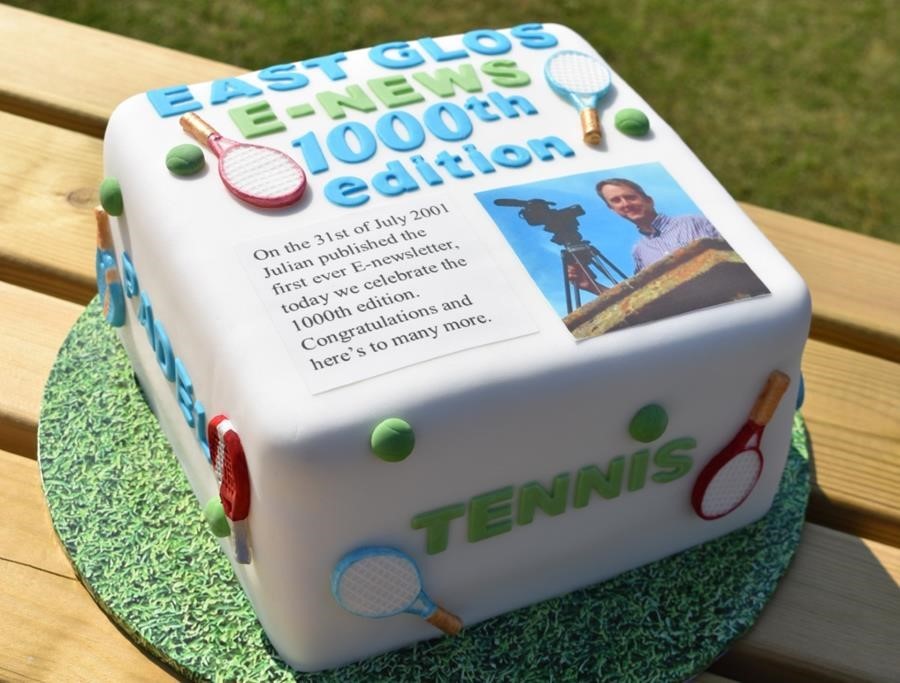 The Summer National Tour 2021 LTA Grade 2 junior tennis tournament takes place at the start of August. There is an exceptional standard of tennis on show all week as the club hosts one of only four grade 2 junior tournaments over the summer for ages U12 to U18.
The Summer National Tour 2021 LTA Grade 2 junior tennis tournament takes place at the start of August. There is an exceptional standard of tennis on show all week as the club hosts one of only four grade 2 junior tournaments over the summer for ages U12 to U18.
With the launch of padel in April, a padel committee is formed.
Launched in 2001 with an initial readership of just 30 subscribers, the club’s weekly email newsletter, E-News, celebrates its 1,000th edition. In celebration, bar and catering team member Louise Peachey creates a special cake, presented to Julian Wellings, who has edited E-News since its inception in 2001.
The club ends the summer with a record number of new members of all ages across all four racket sports who have joined since the club reopened in March.
Work is completed on the overflow car park to provide an additional 42 spaces.
In November, with rising coronavirus cases driven by a new Omicron variant, the government reimposes a requirement for face coverings to be worn in specific settings. This affects the Reception and pro shop areas.
A junior forum is formed to discuss matters and ideas important to junior members.
The club launches its first-ever environmental sustainability policy. As a major sports club with over 1700 members occupying a ten-acre site and playing a significant role in the local community, the club has important environmental responsibilities for climate control and biodiversity.
Read our 2021 annual report.
2022
East Glos recognised as one of top three clubs in the country; farewell to ladies’ hockey
A sense of normality returns to the club following the challenges brought about by the pandemic in the previous two years. The final set of restrictions is eased in January when face coverings in the reception and pro shop areas are no longer mandatory, as Covid cases caused by the Omicron variant continue to decline.
E-News, the club’s weekly email newsletter, reaches a record 2008 subscribers, the highest in its 20-year history.
In the annual LTA awards, East Glos is recognised as one of the top three clubs in Great Britain. The club reaches the final three in the club of the Year category from a field of seven finalists from England, Scotland, and Wales. Grantham Tennis Club wins, meaning East Glos is joint runner-up with Esher Tennis Club.
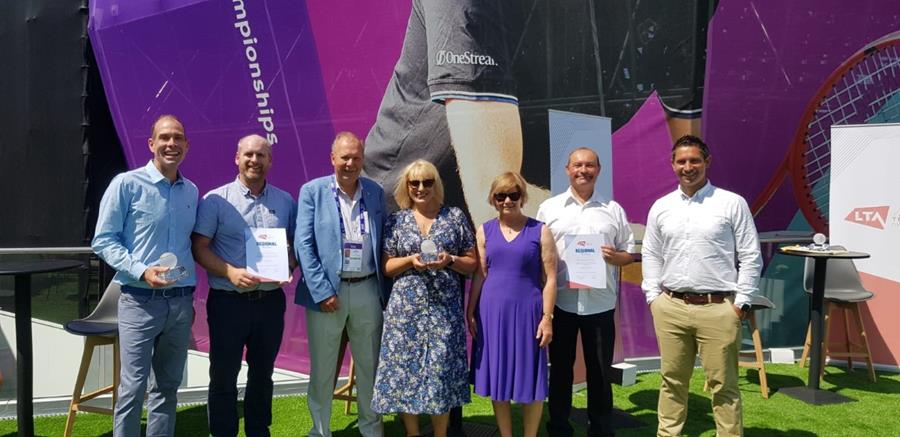
Presentation of the 2022 Club of the Year runner-up award. Simon Corbishley, Darren Morris, David Rawlinson (LTA President), Barbara Hawkins, Andrea Butland, Stuart Dominey, Steve Worsley
Scores of members enjoy a buffet fit for a queen as the club celebrates the Queen’s Platinum Jubilee. The prize for the best-dressed player goes to David Ball with his splendid red, white and blue hair. Janice Kent looks patriotic in her Union Jack flags. And Charlie Vivian wows us with an impressive Union Jack tennis top.

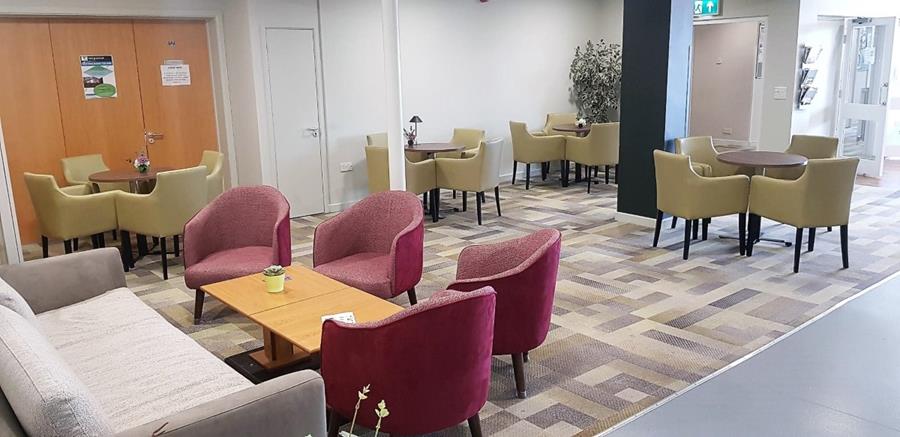 The club hosts its first-ever LTA Grade 1 Grass Championships for under 14s, with the top 32 ranked boys and girls in the country.
The club hosts its first-ever LTA Grade 1 Grass Championships for under 14s, with the top 32 ranked boys and girls in the country.
A clubhouse refurbishment is completed. New furniture is in place, along with upgraded flooring and painting.
The first-ever East Glos tri-rackets tournament takes place comprising tennis, racketball and padel; it is possibly the first tri-rackets tournament in the UK.
After much discussion, the hockey committee, with endorsement from the East Glos Board, reluctantly agrees that the future of hockey at East Glos is no longer practical or viable. A phased merger with Lansdown Hockey Club will be completed in September 2023.
Her Majesty Queen Elizabeth II passes away on 8th September aged 96. On the day of her funeral, 19th September, the club closes until 4pm.
Longstanding club member Peter Mitchener joins the East Glos Club Coaching Board as Director – Community Relations. His role is to foster greater community engagement for the club.
A successful audit is carried out by the Association of Community Amateur Sports Clubs (ACASC), ensuring the club’s compliance as a Community Amateur Sports Club (CASC).
Notable deaths in 2022 include former club chair Ron Barney and Keith Tarling. Ron was still playing tennis until nearly 90 and still looking upright and immaculate. Keith was a member for over 50 years, and his contribution was much more than simply as a player. He was a great believer in the club and a huge contributor to its development over the years, particularly the major redevelopment of 2002, which saw a redesigned clubhouse and significant improvements in court facilities.
Read our 2022 annual report.
2023
The club holds its first-ever PSA Satellite squash event. Squash manager Mark Toseland has had the ambition to run a PSA Satellite tournament for some time. His dream finally becomes reality at the end of February.
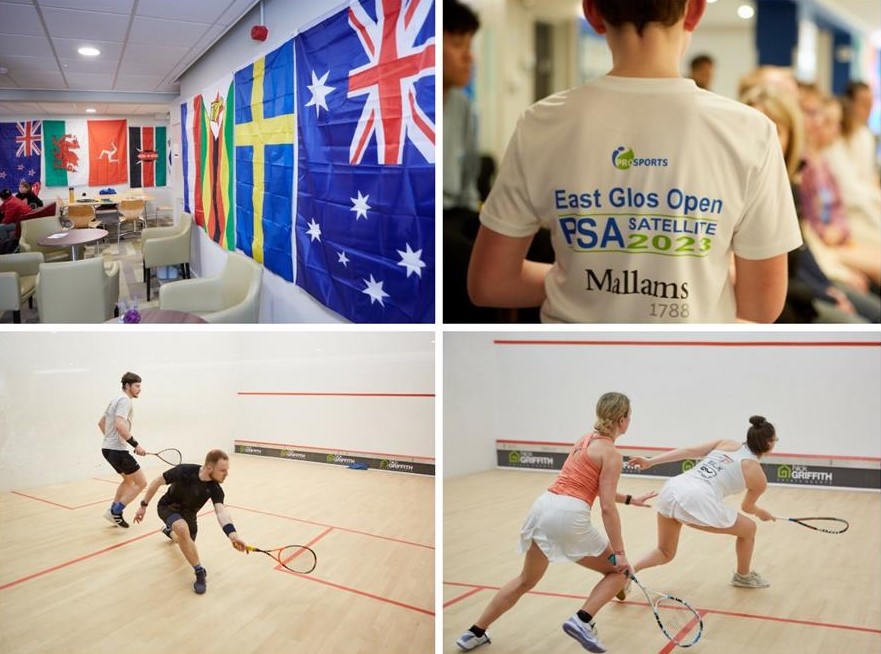
In February the board updates members on this year’s subscription rates. Due to the current high inflation rate, they decide not to pass on all the increased costs that will be incurred by the club during 2023. Subscriptions will rise by only 2%, with a projected income increase of 3.5%. The board says, “More efficient operations (for example, installation of LED lighting and a new gas boiler) and the club’s continuing healthy financial position will enable us to cope with the current 10% inflation rate.
In March, East Glos enters two under-12 teams in the final county hockey festival of the season. This is the last time these players would represent East Glos due to the merger with Lansdown Hockey Club. Therefore, it is fitting that both teams ended the afternoon undefeated. The Seals (first image below) draw four and win one, while the Dolphins (second image below) draw three and win two.
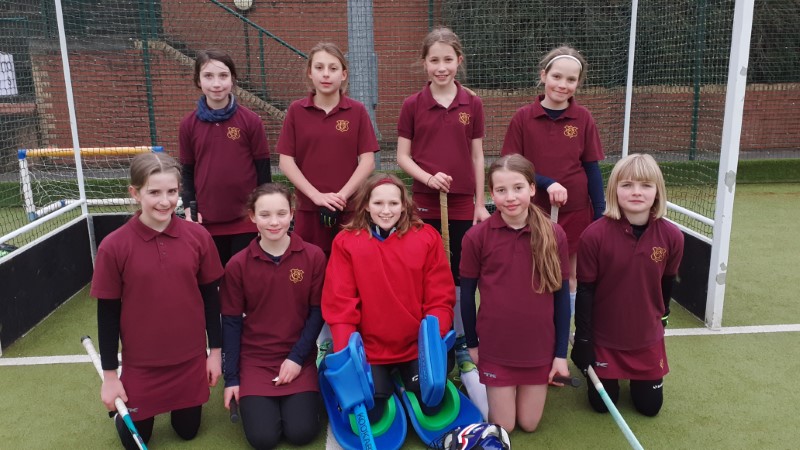
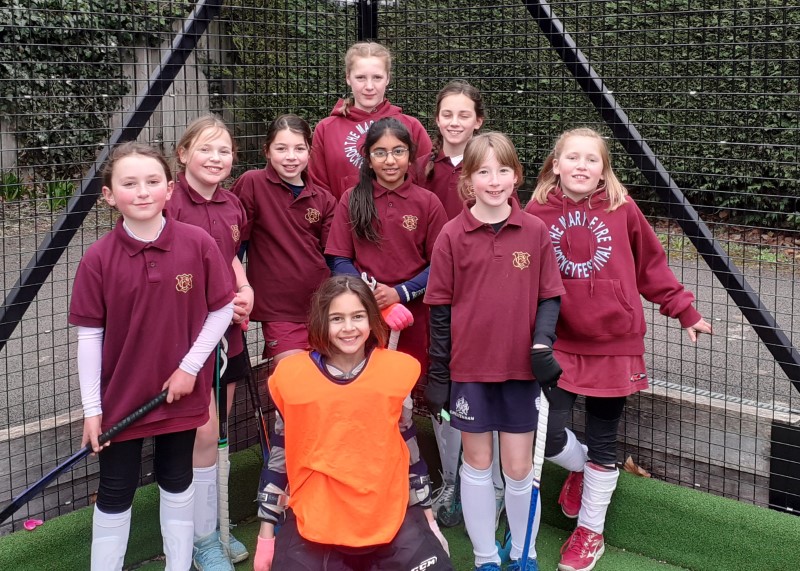
Pickleball taster sessions are held in March. It is America’s fastest-growing sport and is making waves in the UK.
In April, two years of East Glos padel is celebrated. An anniversary event is held with over 50 members enjoying coaching clinics and an exhibition match.
Also in April, the ladies’ A team wins the Gloucestershire winter league over 60s. Captained by Jacqui Matthews, the team finishes seven points clear of second-placed Cerney Lakes. The players representing East Glos are Anne Ewart, Chantal Ball, Vanessa Francis, Denise Kilgannon, Nicola Gadsby, Jane Hancock, Rosie Hartley, Fiona Smith, Sue Wood, Sandra Spackman, Sarah Watkiss and Liz Cowan. There is also success for the men’s A and mixed A teams in the over 60s league. In the Gloucestershire summer league success continues with the ladies A and men’s A team winning their respective Premier League divisions.
For the May AGM, a small group of members submits resolutions relating to all courts (other than hard courts) being available for social play; no new members to be admitted unless existing members leave or new courts are built; members to be given priority to book two weeks in advance with coaches booking one week ahead other than hard courts. The board responds, expressing serious concerns that these resolutions would jeopardise our Community Amateur Sports Club status. They also state that they are to the benefit of one small group of tennis players and against the interests of many other groups. There would be a negative impact on the club’s finances, necessitating an immediate and significant rise in members’ subscriptions. Following further discussions between the board and the proposers, the resolutions are withdrawn before the AGM.
At the AGM in May, the development committee outlines its medium-term plans. These are to build new padel courts on grass courts 26 and 27 (adjacent to the existing ones), ideally covered, and two new tennis courts next to existing courts 12 and 13. The committee is also conscious of the cramped office conditions some of the staff work in and will investigate extending the grounds staff building to provide additional office and storage space. The committee’s grand plan which would deliver its full wish list of indoor tennis, more padel and squash courts and a significantly improved clubhouse, including a gym is considered too ambitious due to the potential cost of £7m.
At the Gloucestershire LTA Awards, club member Eva Haynes is awarded Mary Eyre Junior Girl Player of the Year. Competition of the Year is won by the Gloucestershire County Championships hosted by East Glos and organised by coaches Simon Corbishley and Esther Curtis.
A robot line marking machine is used for the first time. It uses GPS to measure and mark all ten grass courts, taking seven minutes per court.
In June, members are enthralled as world-ranked squash players descend on East Glos. WR#4 and England #1, Mohamed ElShorbagy (pictured right), WR#32 Nathan Lake (pictured left), WR#249 Will Salter and Jordan Hardwick play a pro exhibition match at East Glos. Juniors enjoy getting on court with the pros for tips and pointers and the evening ends with a Q&A.
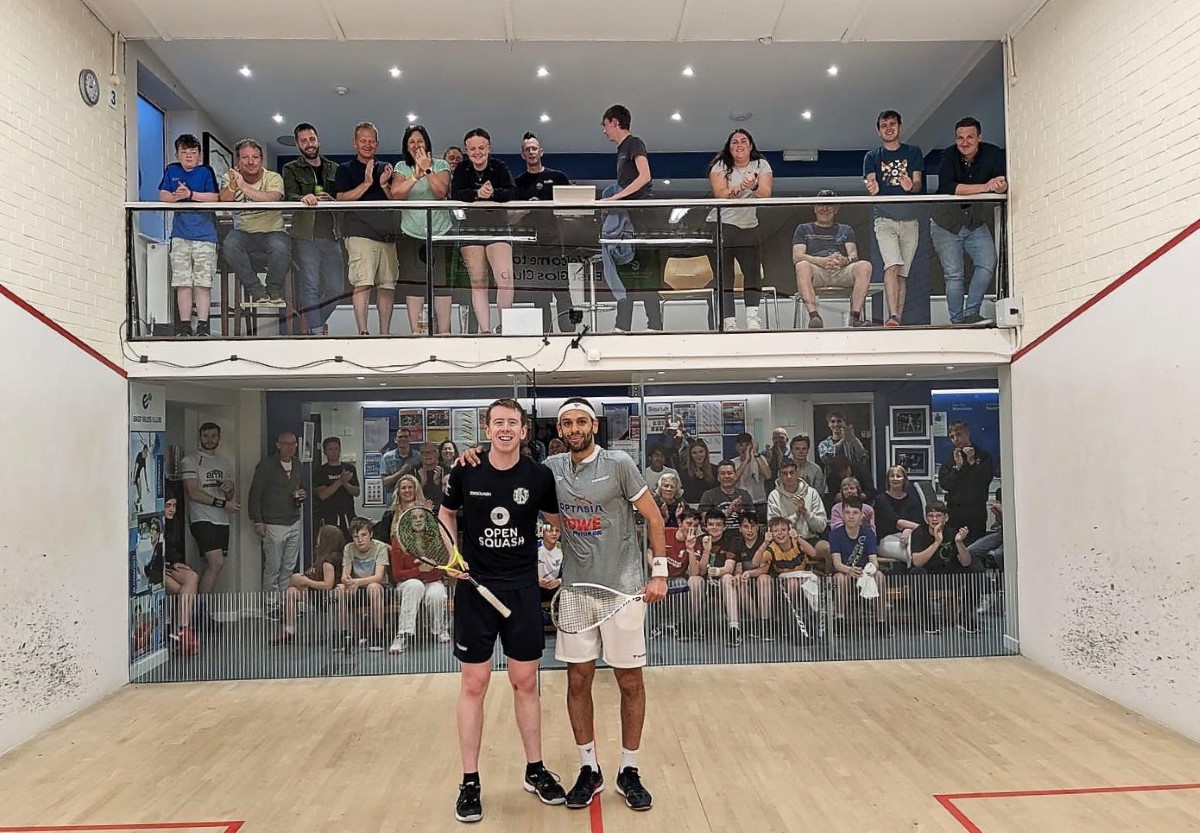
In a busy month for squash events, the annual ProAm Doubles Tournament takes place with the strongest-ever lineup. Members and visitors experience spectacular doubles squash, festivities, live music and more.
Outstanding tennis is on show as the club hosts the LTA Under 14s Grass Court National Championships for the second year. Many club members enjoy the excellent tennis on show, with over 200 people watching the finals on the Saturday.

Sarah Bowen is recognised with this year’s Mary Eyre Senior Bowl award. She wins this award for her volunteer work within the hockey section, a sport which has been played at the club since 1888. Sarah was the organiser of East Glos junior hockey for the last 20 years, coaching, arranging matches, managing membership, and inspiring many girls to play the sport.
At the end of June, the club mourns the passing of its longest-standing member, Shelagh Davson, aged 97. Shelagh joined the club in 1946 and played on the left wing for the club’s first XI, for Gloucestershire and the southwest. For decades, she worked tirelessly for junior hockey at East Glos for decades, coaching teams and organising training, matches and competitions into her late eighties. Read more about Shelagh’s life.

▲ Shelagh Davson (R) with Jenny Kean (L), niece of Mary Eyre. Pictured in 2014 at a hockey festival held in memory of Mary Eyre.
A gazebo is installed in the patio area. It expands the lounge capacity, meaning people won’t have to hunt around for a spare seat, and it will also be used for social events. Tom Wishart joins the staff as bar and catering manager.
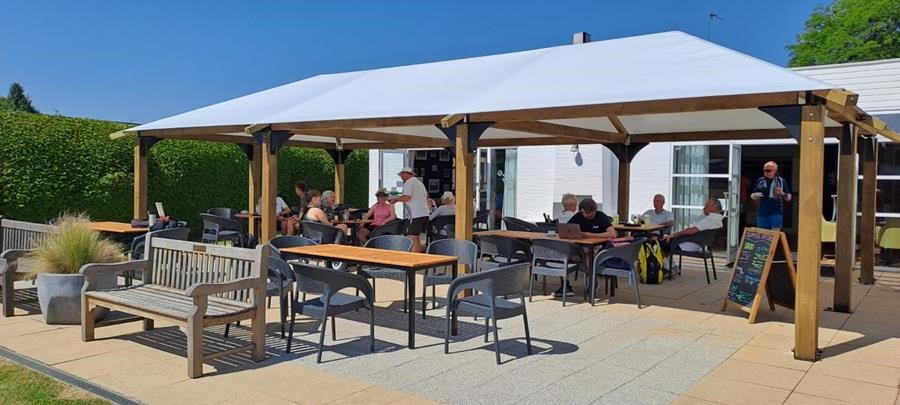
Club member Heather Sheridan receives an England call-up. She plays in an England seniors padel match versus the Channel Islands. Playing away in Guernsey and Jersey, the England team wins.
A schools tennis festival takes place at East Glos. In partnership with Move More, over 80 key stage 1 and 2 children from ten schools across the area participate. The aim is to get more kids playing tennis.
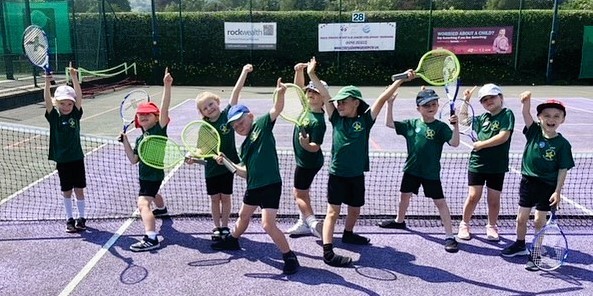
▲ Children from Northway Infants School
In July, following the publication of our 140-year club history on this website in January, it is so well-received that we produce a book version. The book is researched and written by Julian Wellings, with design by Neil Morgan.
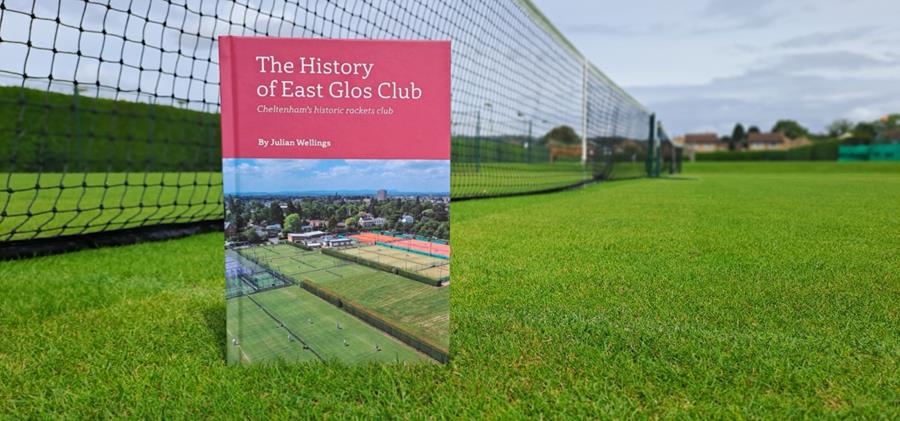
 The club logo is updated to remove hockey and replace it with racketball, having bid farewell to the ladies’ hockey section.
The club logo is updated to remove hockey and replace it with racketball, having bid farewell to the ladies’ hockey section.
A new sustainability working group is set up. Although the club has had an environmental sustainability policy since 2021, the board decides it should be doing more to promote the club’s activities on this front.
Simon Corbishley becomes padel manager, having carried out the role on an interim basis. Simon has a long association with East Glos and will manage the padel coaching and tournament programme.
New measures are introduced for rejoining members. If an ex-member wishes to rejoin within 12 months, they will be asked to pay their subscription arrears backdated to their leaving date. This is to deter people from treating their membership as seasonal rather than annual. For example, cancelling their direct debit in the autumn and resuming the following spring.
In August, with his partner Andrew Hutchinson, club member Neil Howitt wins the 55s doubles at the Senior Nationals Grass Court Championships at The All England Club.
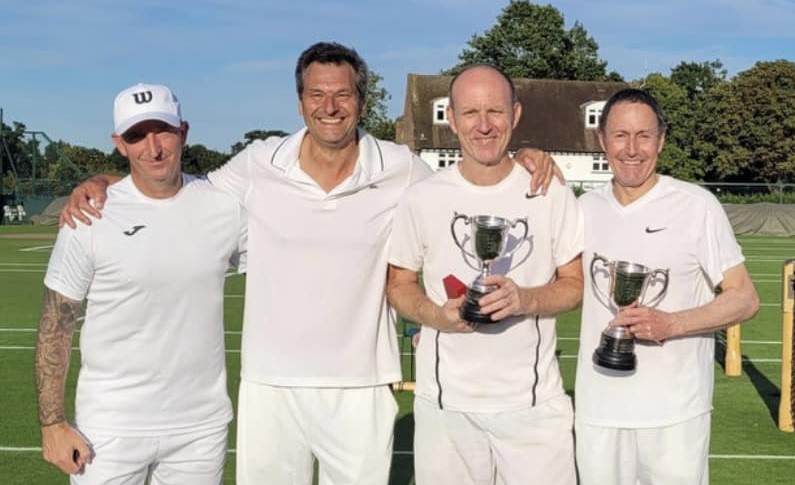
▲ Neil Howitt (far right) with Andrew Hutchinson and runners-up Mick Hooker and Greg Kaushar on the left.
In September East Glos participates in the Centenary Clubs Tournament at the All England Lawn Tennis Club. The participants are clubs which have existed for a hundred years or more. Participants are treated to a tour of the grounds and its secrets, the museum and playing on the championship courts.
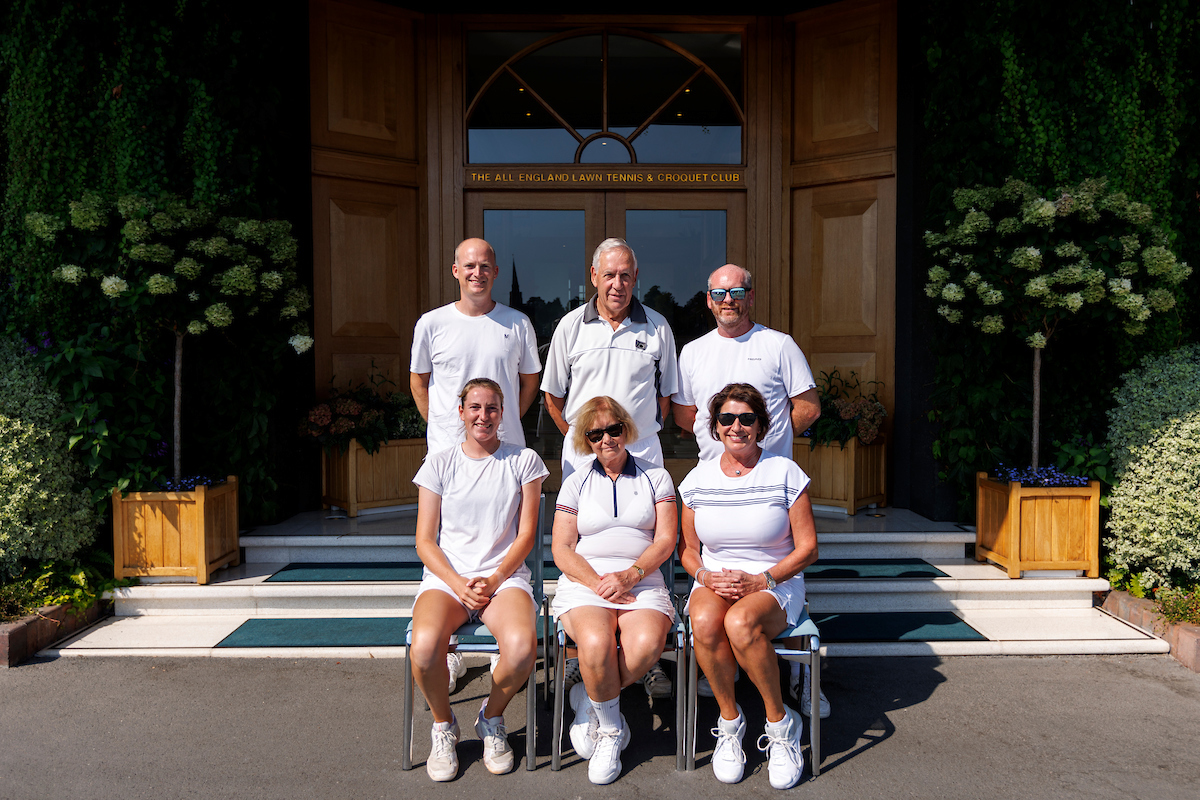
▲ Back: Mo Buescher, John King, Darren Morris. Front: Laura Eales, Andrea Butland, Clare Orman. Photo credit: AELTC/Chloe Knott.
Three-and-a-half months of play in the club championships come to a close, with 415 matches played, and 328 players participating across tennis, padel and junior tennis.
At the end of September, £1,122 is raised for Macmillan at World’s Biggest Coffee Morning. This includes a generous donation of £387 from HSBC. The event has been run at East Glos for over 20 years raising tens of thousands of pounds.
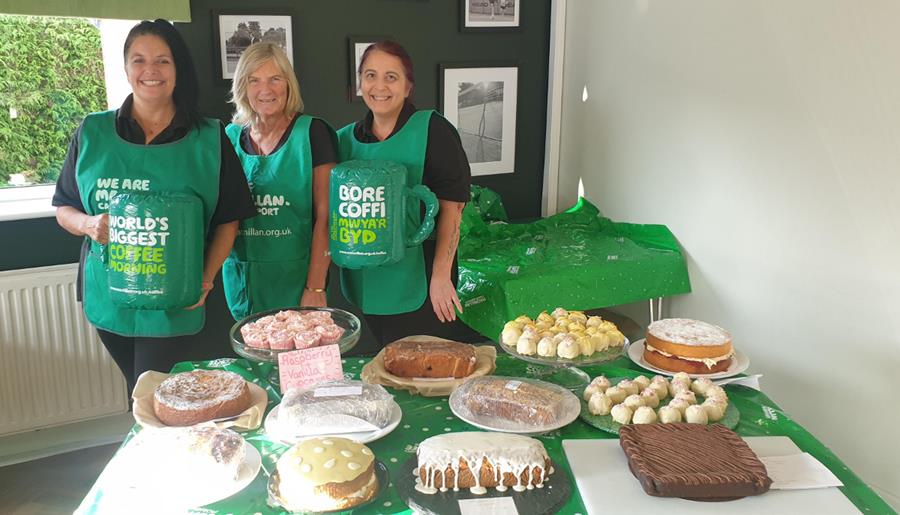
▲ Farideh Clifford, Michelle Vincent, Amanda Cronk from the club’s bar and catering team.
In October, to improve playing opportunities for club members, six additional 45-minute squash court slots on weekday evenings are made available using the courts at Cheltenham College Sports Centre.
November sees several junior successes. Fergus Franklin wins a grade 4 boys’ 18 tennis singles in Oxford. With his partner Evan Baker, he wins a men’s doubles grade 3 event in Cardiff.
There are notable performances from squash juniors Harry Bloomfield and Ronnie Hickling in the British Junior Championships in Sheffield. Harry finishes with a career-high at third place after beating 3/4 seed Ismail Khalil in the 3/4 playoff. In the quarter-finals, Ronnie set himself up for a semi-final spot on the Saturday.
Meanwhile, on the padel circuit, Ethan Holt wins a 12U padel tournament at Rocket Padel, Bristol, with his partner Travis Barber from Harrogate. He is also runner-up in the 16U event, playing with fellow East Glos member Charlie Aldred.

▲ Evan Baker & Fergus Franklin; Harry Bloomfield (far right); Charlie Aldred & Ethan Holt
In addition to these junior successes, squash manager Mark Toseland reports that East Glos is a central cog in the junior county development programme. Record numbers of juniors are representing the county with three boys u15 teams playing in the recent Junior Inter-county Championships, Southwest region.
Sumaya Dowling-Membrado is appointed as the club’s first marketing communications coordinator. She will play a key part in promoting the club and its activities to members, potential members, and the local community.
Club members Louise Dalglish, Sally Pendry and Heather Sheridan (pictured below) emerge victorious from a major super seniors padel competition delivered by GB Seniors Padel. Heather and Sally win the inaugural Legends Cup (women’s 59+ category). In the final, they beat GB team players Anthea Hunt and Audrey Henderson, 6-2 6-2. At the same time, Louise Dalglish wins the inaugural Phoenix Cup (women’s 69+ category) with GB team player Rosie Connell.
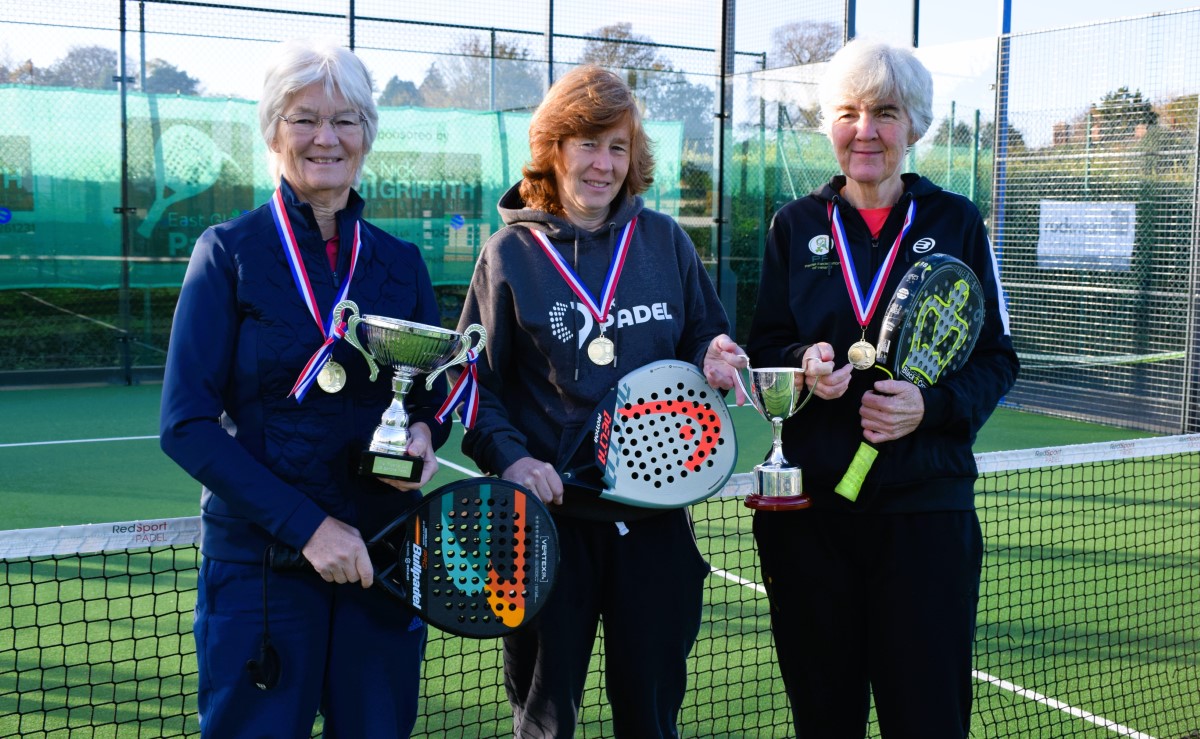
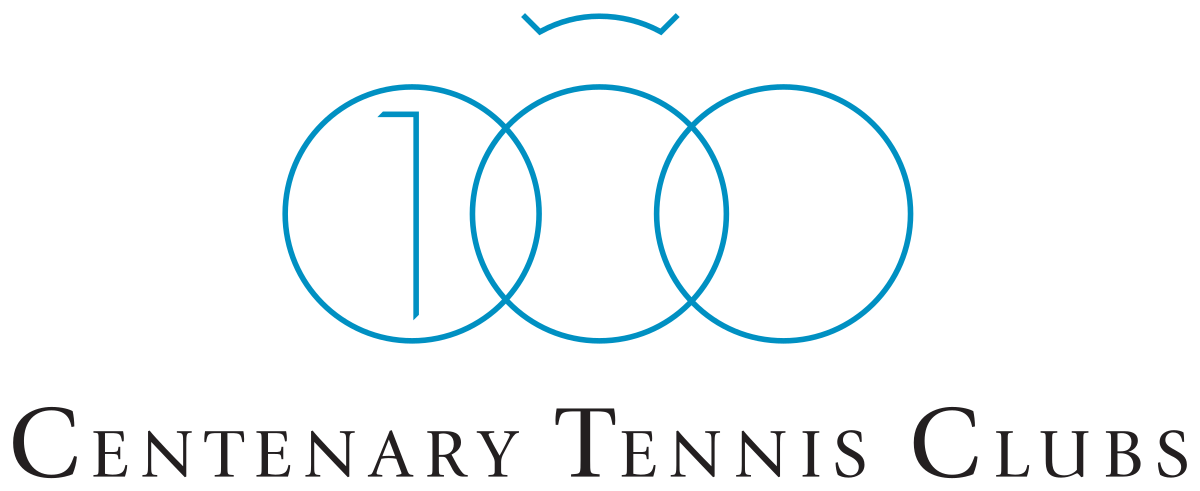 In December, East Glos becomes a member of The Association of Centenary Tennis Clubs (CTC). The (CTC) is an umbrella group of 78 clubs in 24 countries on five continents.
In December, East Glos becomes a member of The Association of Centenary Tennis Clubs (CTC). The (CTC) is an umbrella group of 78 clubs in 24 countries on five continents.
All member clubs have a history dating back at least one hundred years and have played a significant sporting tradition and social role in their communities. Many also offer squash and padel facilities. The key benefit for our club members is the opportunity to play at any of the CTC member clubs globally. Club member Jules Greenwood is the first to avail herself of this opportunity by visiting Villa Primrose Club in Bordeaux.
The development committee announces some club improvements. The mini-tennis area is resurfaced and converted into a pickleball court. The mini-tennis juniors continue to enjoy their games on the court. The Tarmac path from astroturf courts 15 to 13 is extended to provide better access. New LED lighting will be installed on several tennis courts in 2024.
Edit history
26.02.2024: Added new information for 1882 regarding the founding of East Glos. Thank you to Nigel Lawford for his insights on this and on the ladies’ cricket information below.
23.02.2024: Added a match report for East Gloucestershire Ladies’ Cricket Club to 1890.
31.12.2023: Updated the history for 2023.
27.09.23: The below were sourced from a recently discovered article from Cotswold Life from 1985, celebrating the club’s centenary (of tennis first being played).
1907: Added reference to Mr Gould, the groundsman and his injury at work.
1925: Added reference to the duties the club professional is expected to perform.
1938: Added reference to Margaret Eyre becoming the county’s first female professional tennis coach.
1966: Added reference to the lineage of Pam Bocquet and positions held by her mother and father.
22.07.23: Added 2022 annual report.
05.04.23: Amended Steve Worsley’s start date as junior activity coach from 2003 to 2001.
24.03.22: Added links to annual reports for years 2019, 2020 and 2021.
28.02.23: Added Felicity Thomas’ Grand Slam achievement to 2017. Amended the account of a stray arrow which landed on a tennis court in 1982. It was shot during a county match, not by a novice.
20.02.23: Added Felicity Thomas’ world rankings to 2016 and 2018 and Rose D’Sa’s Four Nations selection to 2016.
17.02.23: The death of Major Ted Millman added to 1999.
15.02.23: New findings on the likely derivation of the name “East Gloucestershire Club” added to 1883.

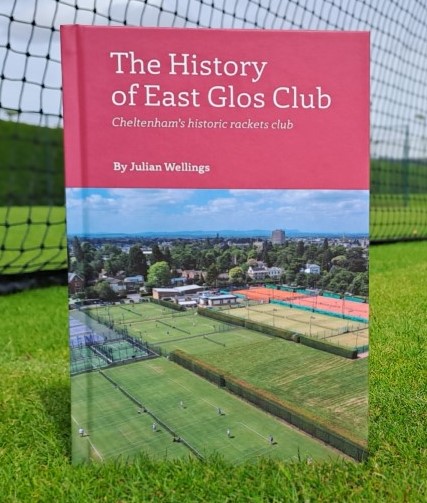 The history of East Glos is
The history of East Glos is